Nitrogen


ANIMAL HEALTH
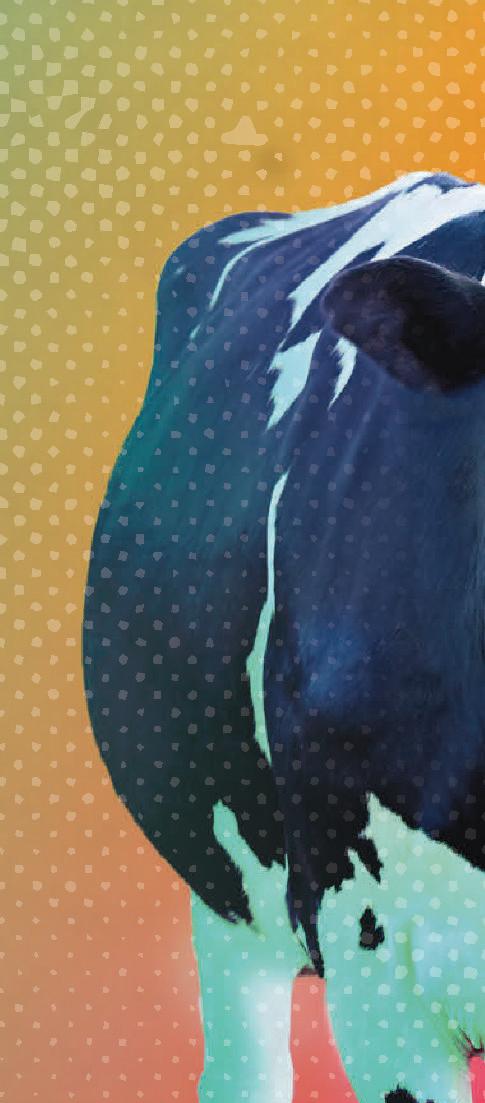


Preparing your herd for spring grazing
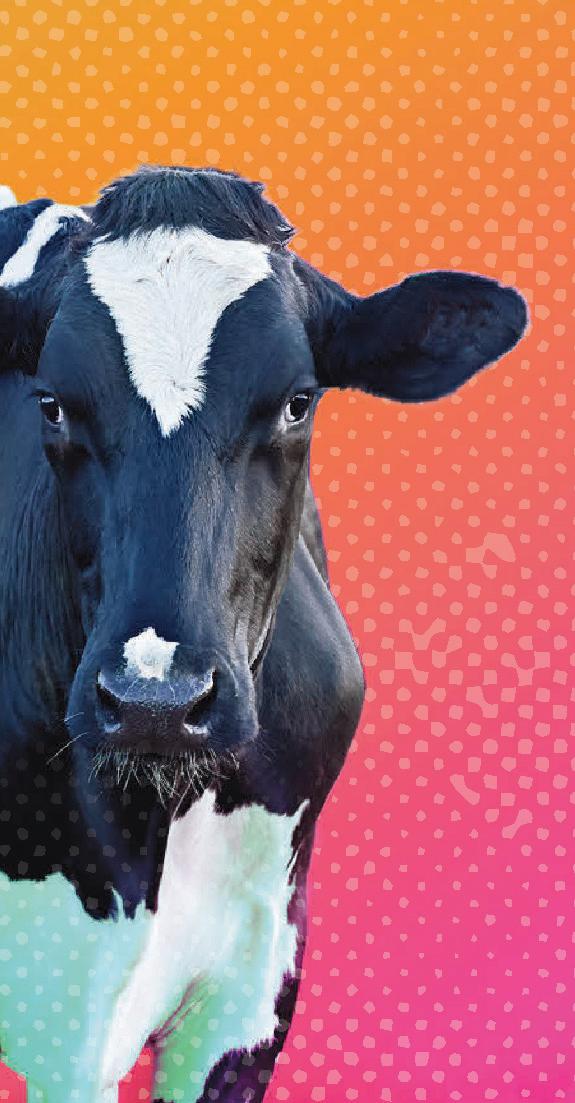



Pages 46-60
YOUNGSTOCK
Lung scanning can aid pneumonia management
Pages 18-19
MACHINERY
A focused look at Manitou’s ULM 412H

Pages 62-67


MILK PRICES
Pages 68-70

TIP OF THE MONTH: How to avoid a spike in somatic cell counts at turnout – p58 DAIRY FARMER
April 2023
70 Issue 4
Pages 32-34
Volume
N LALLEMAND ANIMAL NUTRITION SPECIFIC FOR YOUR SUCCESS www.lallemandanimalnutrition.com take control of silage quality
more dry matter up to 13% more Digestible fibre up to To learn more about MAGNIVA visit LallemandAnimalNutrition.com Uniquely combining the rapid action of L. hilgardii CNCM I-4785 and long-term protection from L. buchneri NCIMB 40788, MAGNIVA PLATINUM forage inoculants:
Rapidly lower pH
Increase aerobic stability for early and conventional clamp opening
Reduce waste and increase energy and protein from silage helping maximise the value of your forage
How modern clover varieties can boost
15%
n
n
n
Take the next step with Mastitis Vaccination


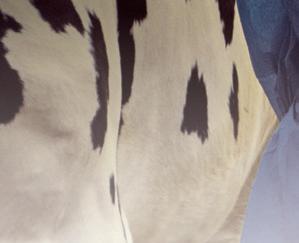







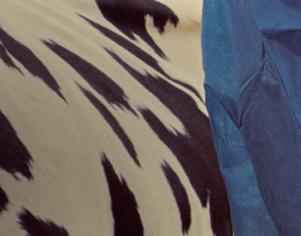





Ask your vet about your mastitis prevention plan



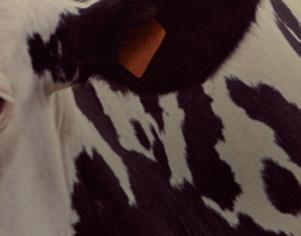


11%

28,2% E. coli

11% Staph. aureus





Andrew Biggs BVSc, FRCVS and Vale Veterinary Laboratory Data. Primary pathogen identified in all high SCC and clinical mastitis milk samples from 2019-2021. STARTVAC® Inactivated vaccine, Bovine mastitis, in injectable emulsion. COMPOSITION PER DOSE (2 ML): Inactivated Escherichia coli (J5) 50 RED60*; Inactivated Staphylococcus aureus (CP8) SP 140strain expressing SAAC** 50 RED80***. Adjuvant. * RED60: Rabbit effective dose in 60% of the animals (serology). **SAAC: Slime Associated Antigenic Complex. ***RED80: Rabbit effective dose in 80% of the animals (serology). INDICATIONS: Cows and Heifers: To prevent Mastitis. For herd immunisation of healthy cows and heifers, in dairy cattle herds with recurring mastitis problems, to reduce the incidence of sub-clinical mastitis and the incidence and the severity of the clinical signs of clinical mastitis caused by Staphylococcus aureus, coliforms and coagulasenegative staphylococci.The full immunisation scheme induces immunity from aproximately day 13 after the first injection until approximately day 78 after the third injection (equivalent to 130 days postparturition). Further information available from the SPC or on www.hipra.com. For more information about side-effects, precautions, warnings and contraindications please refer to the SPC, the packaging or product leaflet. LEGAL CATEGORY: POM-V- Veterinary medicinal product under veterinary prescription.
MARKETING AUTHORISATION HOLDER: Laboratorios Hipra, S.A. la Selva, 135, 17170-AMER (Girona) SPAIN. MARKETING AUTHORISATION NUMBERS: UK(GB): Vm17533/5010, UK(NI): EU/2/08/092/003-6. Use Medicines Responsibly.
UBAC®, emulsion for injection for cattle. COMPOSITION PER DOSE: Lipoteichoic acid (LTA) from Biofilm Adhesion Component (BAC) of Streptococcus uberis, strain 5616 ≥ 1 RPU. Montanide ISA 907.1 mg. Monophosphoryl Lipid A (MPLA). INDICATIONS: For active immunisation of healthy cows and heifers to reduce the incidence of clinical intramammary infections caused by Streptococcus uberis, to reduce the somatic cell count in Streptococcus uberis positive quarter milk samples and to reduce milk production losses caused by Streptococcus uberis intramammary infections. Further information available from the SPC or on www.hipra.com. For more information about side-effects, precautions, warnings and contra-indications please refer to the SPC, the packaging or product leaflet. LEGAL CATEGORY: POMV- Veterinary medicinal product under veterinary prescription. MARKETING AUTHORISATION HOLDER: LABORATORIOS HIPRA S.A Avda. la Selva 135. 17170 Amer (Girona) Spain. MARKETING AUTHORISATION NUMBERS: UK(GB): Vm17533/5011, UK(NI): EU/2/18/227/001-004. Use Medicines Responsibly
These products are not licensed for concurrent use. A decision to use either of these vaccines before or after any other veterinary medicinal product therefore needs to be made on a case-by-case basis.
HIPRA UK and IRELAND Foxhall Business Centre, Foxhall Lodge, Foxhall Road, Nottingham, NG7 6LH. United Kingdom Tel.: (+44) 0115 845 6486 · ukandireland@hipra.com · www.hipra.com
Strep.
2,5% Bacillus 2,7%
bovis 0,9% Klebsiella spp 3,6% Others
Non-aureus Staph 35,9% S. uberis 4,4%
dysgalactiae
Coryne.
Contacts
Editor Katie Jones 07786 856 439 katie.jones@agriconnect.com
Content Editor/Designer














Mike Begley 01772 799 405 mike.begley@agriconnect.com


Picture Editor
Marcello Garbagnoli 01772 799 445 marcello.garbagnoli@agriconnect.com

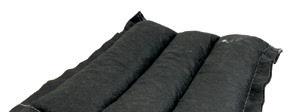

Head of Commercial Solutions
Mike Hartley 01772 799 532 mike.hartley@agriconnect.com

Account Manager

Mark Jackson 01322 449 624, mark.jackson@agriconnect.com
Classified Advertisements 01772 799 400 fgclassified@agriconnect.com
Advertising Production
Justine Sumner 01772 799 437 Fax: 01772 796 747 justine.sumner@agriconnect.com

Circulation and subscriptions 0330 333 0056 help@subscribe.farmers-guardian.com

Subscription rates: UK £65 a year
Europe: £85 World: £95
ISSN 1475-6994
© Farmers Guardian 2023
All rights reserved. No part of this publication may be reproduced or transmitted in any form or by any means, electronic or mechanical including photocopying, recording, or any information storage or retrieval system without the express prior written consent of the publisher. The contents of Dairy Farmer are subject to reproduction in information storage and retrieval systems.
Dairy Farmer, Unit 4, Fulwood Business Park, Caxton Road, Preston, Lancashire PR2 9NZ

Origination by Farmers Guardian, Unit 4, Fulwood Business Park, Caxton Road, Preston, Lancashire PR2 9NZ. Printed by Precision Colour Printing, Halesfield 1, Stirchley, Telford TF7 4QQ. No responsibility can be accepted by Dairy Farmer for the opinions expressed by contributors.
a word from the editor
It was a huge shock to hear about the sudden passing of industry stalwart Ian Po er at the end of February.
Ian was well-known for his forthright nature and no nonsense a itude, and his presence within the industry will be missed.
I used to look forward to receiving his column for Dairy Farmer each month, and I know from reader feedback that ‘Po er’s View’, which he wrote for 30 years before bringing it to an end in 2021, was extremely well-read.
And whether you agreed with its contents or not, it was also arguably among the pages within the magazine which garnered some of the most vigorous debate and discussion.
I would, on behalf of everyone at Dairy Farmer, like to send my condolences to Ian’s family at this sad time.
Ian’s regular news bulletins have been an essential read for many within the industry and particularly at the moment as we continue to keep an eye on milk price movements and the wider global dairy market place.
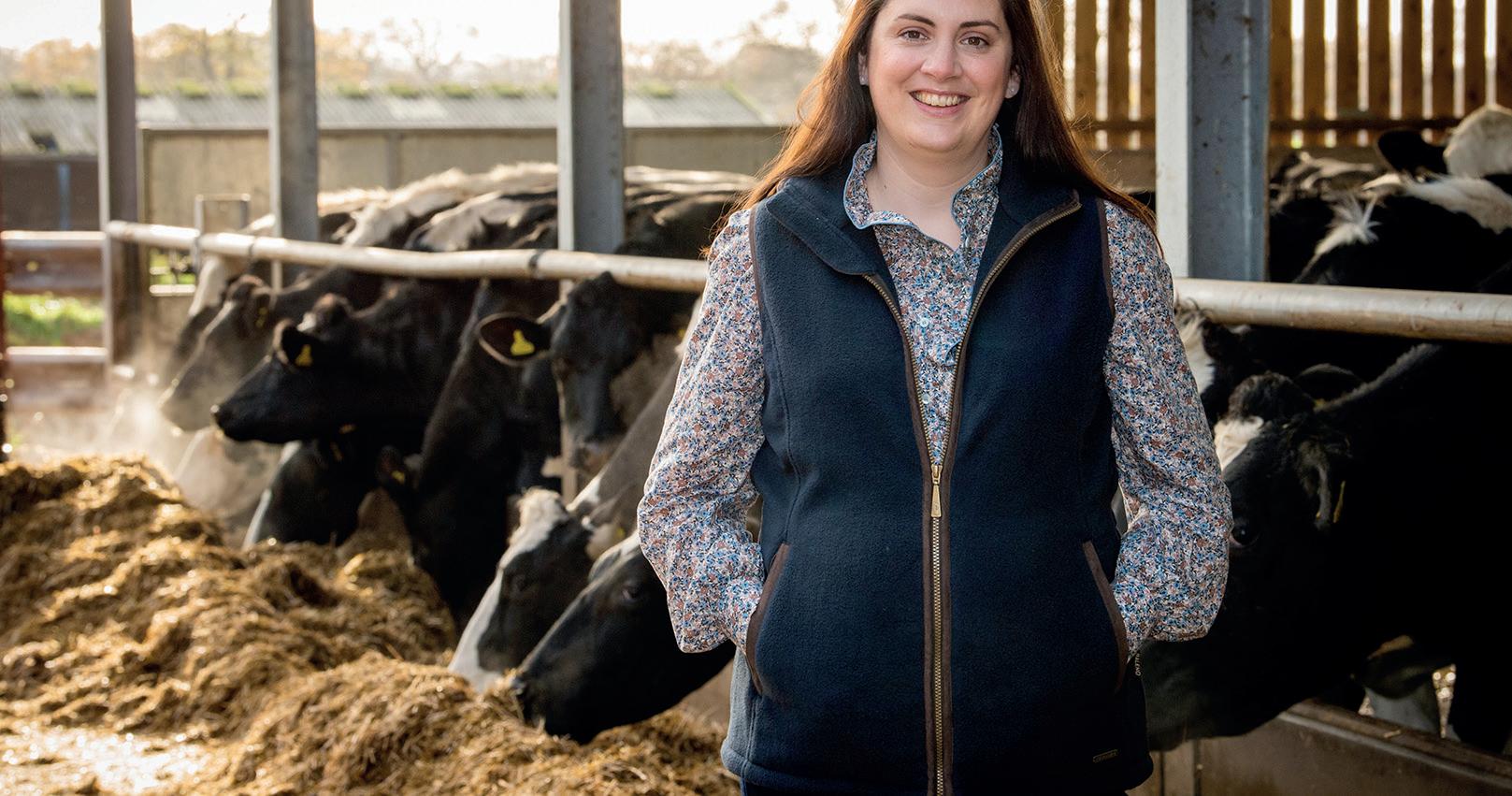
Impact
It is interesting to see the impact the domestic milk price is having on the sales ring and what the longer term outlook for ca le numbers could be (see pages 80-81 for more on this).
A look at sale reports suggests that while cull cow prices remain strong, milking cow and heifer prices are perhaps starting to dip slightly. is will surely have an impact on milk volumes going into spring, particularly as farmers are still having to contend with high costs of production.

Mattress


Calving Gates



3 APRIL 2023
Official Distrib f View our cow comfort range: www.wilsonagri.co.uk Contact us at HQ: 028 7086 8430
Dairy Grip rubber
AgriCow Pendulum Cow Brush
Calf De-horning crate
Cattle Crushes Slat Rubber
Matthew Evans 07922 422556 Charlie Sutcliffe 07703 679023 Midlands & Wales Scotland & Northern England
items in our ranges: Livestock Equipment www agrikit co uk A COMPLETE RANGE OF COW COMFORT PRODUCTS Pasture Mat the premium cow mattress
FARMING EQUIPMENT & TECHNOLOGY FUND 2023
Eligible
Anglesey bTB rise ‘cause for concern’
Increasing cases of bovine TB in Anglesey are ringing alarm bells in Wales, with cattle keepers in Anglesey receiving additional advice as the Welsh Government looks to keep cases low.
Surveillance data showed for the year to September 30 2022, the average number of open breakdowns at the end of each quarter was six. This compares to 5.5 for the previous year and 3.25 for 2017.
Welsh Government said the in-
creasing disease confirmation rates was a ‘cause for concern’ suggesting this may be another area with emerging bTB, following on from now established clusters in rural Wrexham and more recently in Denbighshire and the Conwy Valley.
There have been no TB-positive badgers identified as part of the Badger Found Dead Survey on the island.
NFU Cymru president Aled Jones said the disease was continu-


Budget offers little for farming
JChancellor of the Exchequer Jeremy Hunt delivered a budget (March 15) devoid of any reference to farming, food or the rural economy, opting instead to focus on urban centres, childcare support and duty cuts.
Mr Hunt announced a £94 billion package to address the cost of living crisis which included a three-month extension of the Energy Support Scheme for domestic customers, as well as duty freezes on fuel and beer.
He also revealed the UK would not enter recession this year and inflation would be reduced to 2.9% by the end of 2023.
NFU Mutual welcomed pension changes, which included scrapping the lifetime allowance and increasing the annual allowance from £40,000 to £60,000, saying it would help farmers plan and address succession issues.
However, it added it was disappointing to see the Chancellor leave income tax and child benefit tax thresholds frozen until 2028. £22 billion was also being set aside to develop the UK’s carbon capture sector. The Treasury has also announced a call for evidence on the scope of Inheritance Tax Agricultural Property Relief.
NEWS 4 APRIL 2023 What’s inside? APRIL 2023 VOLUME 70 ISSUE 4 8 DAIRY TALK Updates from Tom Rawson and Gemma Smale-Rowland 10 ON FARM Committed to breeding the very best animals 14 DAIRY MATTERS With dairy farmer David Brooke 16 VET’S VIEW Plateau in antimicrobial usage 18 YOUNGSTOCK Lung scanning can aid pneumonia management 22 WORLD DAIRYING Young Danish farmer buys his first dairy unit 24 BREEDING A focused look at the power of genetics 30 GRASS QUALITY 32 CLOVER 36 NUTRITION 38 TRIBUTE We pay our respects to the late Ian Potter 40 PARLOUR POTENTIAL 44 FERTILITY 46 ANIMAL HEALTH Preparing your herd for spring grazing 62 MACHINERY Manitou’s ULM 412H 68 MILK PRICES 72 MILK ANALYSIS 74 NEW PRODUCTS Products hitting the market 78 GOOD EVANS ‘We leave it in better condition than when we took it on’ 80 BUSINESS CLINIC Cow numbers under pressure – the trends 16-17 Vet’s View 40-43 Parlour Potential
ing to cause ‘heartache and stress’ for farmers across the country.
“We are concerned about the increase in the number of cases of bovine TB on Anglesey, and the fact that TB is becoming more prevalent in the areas of Wales traditionally deemed as low risk,” he said.
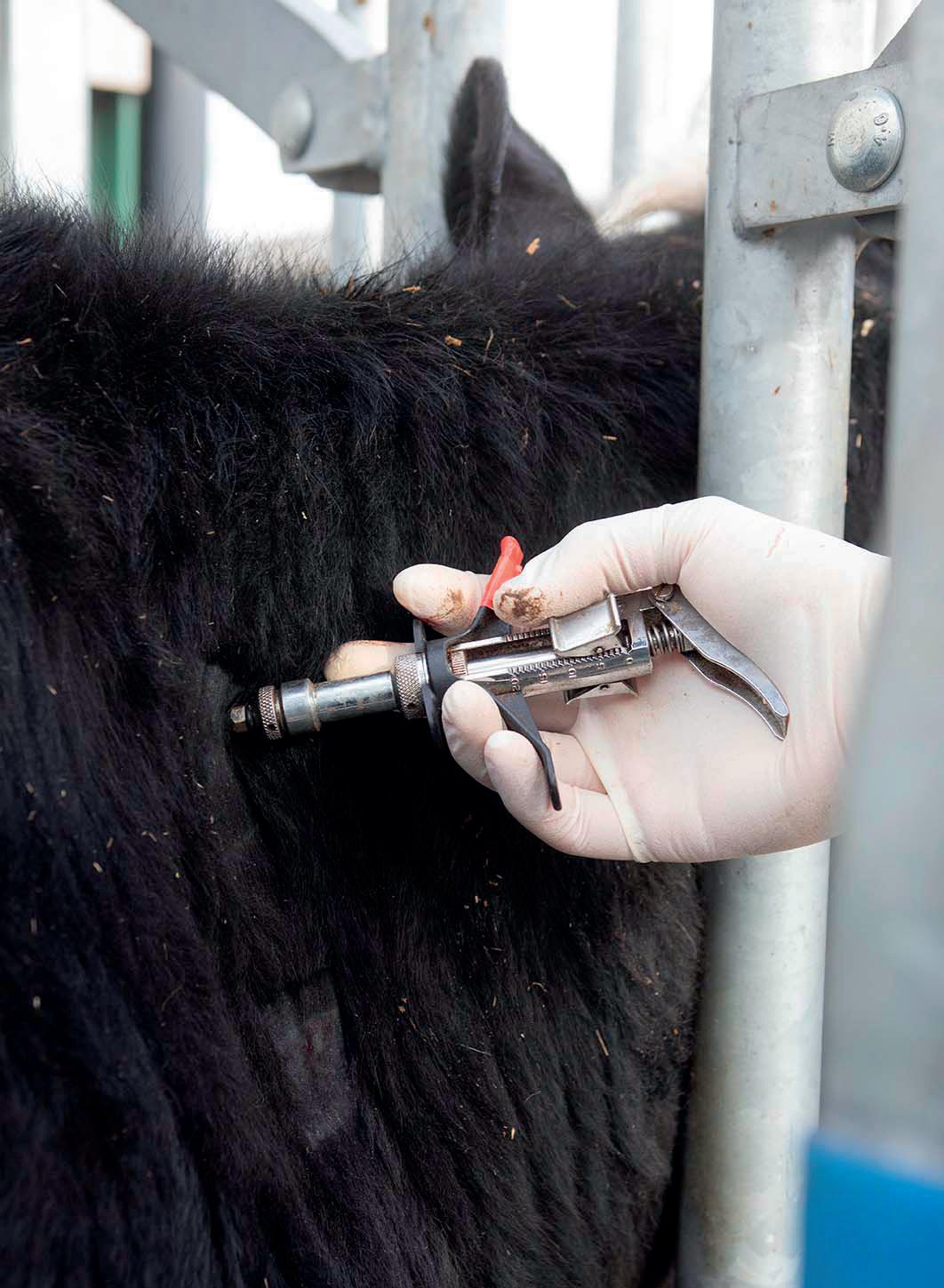
He added farmers should take every step to protect their farms, with many already having strict biosecurity in place.
“We urge Welsh Government to consider how current rural development funding and future support schemes can help farmers make the necessary investment on farms to further enhance biosecurity.
“It is vital any new measures proposed by Welsh Government to tackle TB on Anglesey are developed in collaboration with the farming community.
“In this respect, NFU Cymru has
TB
health of farmers across Wales
requested a meeting with Welsh Government to discuss further their proposals and the challenges TB poses on the island.”
Dr Hazel Wright, deputy head of policy at Farmers’ Union of Wales, said the data showed it remained a signi cant issue for ca le keepers, irrespective of the area they resided in.

“Irrespective of farm TB history, the stress and anxiety endured during TB testing and the fear of facing a potential TB breakdown continues to hammer the mental health of farmers across Wales.
“ is latest surveillance data can only serve to increase such anxiety as farmers continue to run their businesses while doing all they can to avoid a TB breakdown on their premises.”
News in brief Investment in Welsh











dairy
JPembrokeshire Creamery has purchased land for a new milk processing facility at the Pembrokeshire Food Park in Withybush, near Haverfordwest.

The £17 million investment will create 80 jobs, with the processing facilities having a 70m litre capacity and sourcing milk from local farms. The site will be the only British Retail Consortium certified facility to offer Welsh milk also bottled in Wales.
Cornwall dairy farmers win sustainability award
J


The













2023 VetPartners
Sustainable Dairy Farmer of the Year award has been won by Adam and Georgina Roberts, of Trye Farm, Penzance.
The award recognises the adoption of innovative approaches to farming which benefit environment and community, as well as making good business sense.
Runner-up was Michael Oulton, of Springfield Farm, Derbyshire.
Our Mattress Systems, Rubber Flooring & NEW CCTV System are all eligible for ROUND 2 FETF ANIMAL HEALTH & WELFARE GRANT info@coz ycow.co.uk 01296 738 122 | 07713 097 184 for more info: APPLICATION PROCESS EXPECTED MID MARCH GREAT NEWS !!!
NEWS 5 APRIL 2023
Fear of facing a potential
breakdown continues to hammer the mental
DR HAZEL WRIGHT
The Welsh Government suggested Anglesey may be another area with emerging bTB.
PICTURE : Tim Scrivener
Report highlights health and fertility improvements
Herd health and fertility performance is continuing to improve, according to NMR’s latest key performance indicator report.
e report, which is based on data from 500 NMR-recorded Holstein Friesian herds for the year ending August 2022, shows improvements are being made in udder health, conception rates and age at rst calving.
For udder health, the median – or mid-point – of the 500 herd average somatic cell count (SCC) improved from 210,000 cells/ml in 2010 to 166,000 cells/ml in 2022.
e top 25% of herds in 2010 had an average SCC of 169,000 cells/ ml. is is higher than the median level in herds today. In 2022, the top 25% of herds had an average SCC of 130,000 cells/ml.
Another highlight is that nearly half the cows in the top 25% of herds completed their lactation without a high SCC reading (‘high’ being
de ned as more than 200,000 cells/ ml). In 2010, only a third of cows in these herds achieved this.
Calving
ere were improvements to the calving interval, with the median now at 394 days – a drop of 30 days since 2010. ere was also a big di erence in the percentage of cows that conceived by 100 days a er calving, ranging from an average of
29% in the bo om quarter of herds to 46% in the top quarter of herds. e report shows signi cant improvements in age at rst calving with the median of the 500 herds averaging 26 months and one week; an improvement of 10 days in the 12 months to August 2022, and an improvement of 95 days since 2010. e ‘best’ 25% of herds are now averaging 25 months.
Milk production has also in-
creased since 2010, from 7,664kg to 8,707kg in 2022, although last year did see a dip in the upward trend which was most likely due to the hot weather.
“ e UK dairy industry can be proud of the technical progress it has made,” says NMR’s Ben Bartle . “Improvements in herd health, fertility and production drive commercial performance and also support business sustainability.”

Tough year could prompt business change
JLower commodity prices and reduced support payments look likely to outweigh lower production costs this year, which should prompt a discussion about the future direction of English farm businesses, says consultants and research company Andersons.
At the rst in a series of seminars across the country throughout March, Andersons partner and head of business research Richard King said: “High costs will remain the big issue for many farmers in the short-term, but the reduction in support is being increasingly felt.
“Costs have fallen from the highs of last year, but there were

no signs of any immediate decline in input prices soon, while wages seldom fall and prices do not return to where they were before they were raised.”
e drop in input costs has been mirrored by a fall in commodity prices, including in dairy.
“Many English farmers will feel the impact of reduced support payment this year, with the minimum deduction in 2023 at 35% of 2020 levels,” said Mr King.
“In addition, high in ation of 10% has eaten into payments which are not linked to in ation. However, the move to pay half of support payments in the summer has helped cash ow and, from
2024, there will be no cross-compliance requirements in order to receive the remaining Basic Payment Scheme payments.”
Direct support
e continued shi away from direct support may lead to more interest in the Sustainable Farming Incentive (SFI). Figures obtained by e Observer newspaper found that only £10.7 million was paid under the SFI in 2022, which was the equivalent of less than 0.5% of the English post-CAP farm support budget. is contrasted with a 22% decline in direct payments.
Mr King said: “Uptake of the
SFI so far has been slow, but there are a greater range of environmental options to adopt now and many farmers continue to remain in the Countryside Stewardship, which has e ectively become the second tier of the Environmental Land Management scheme. e current budget is only guaranteed until the next election, and there might be a use it or lose it approach if farmers do not adopt more measures.”
Farmers in Scotland and Wales will also need to start preparing for changed supports at the end of 2024, which will require greater environmental action in return for payments.
NEWS 6 APRIL 2023
The report is based on data from 500 NMR-recorded Holstein Friesian herds.

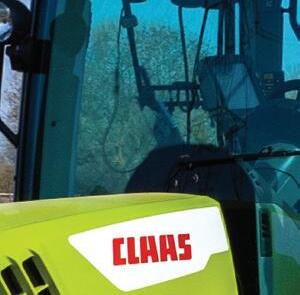



















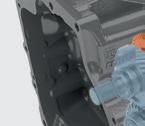








CLAAS CMATIC – Geared for Growth. claas.co.uk Watch the video Andrew Harris, ARION 660 CMATIC, May 2022 Contact your local CLAAS dealer today for a demonstration of a CMATIC tractor. Seamless acceleration and deceleration between 0-50kph. Uninterrupted power for maximum productivity and minimising fuel usage. 3 simple drive modes. Auto stretch brake. Tractor implement control. Engine droop adjustment. The real beauty
is that with CMATIC it’s such a relaxed drive and
so simple to operate.
DAIRYTalk
Tom Rawson
Tom Rawson, who lives in West Yorkshire, is a director of Evolution Farming, a business with a team of 55 staff. The business manages about 3,300 cows across nine units, two of which are organic and one which is in organic conversion, located in seven different counties in the North West, Midlands and eastern regions of England.

The news of the sudden passing of dairy industry analyst Ian Potter was certainly a shock. As a kid my first memory of going to a farmer’s meeting with my dad, put on by the then Midland Bank, was Ian speaking. He was always highly controversial and, often not what you wanted to hear, but you listened and learnt.
His weekly milk industry bulletin was essential reading whether milk prices were rising or falling. I hope someone else will pick up where Ian left off.
Back in 2018 when we had our ‘toughest day’, Ian, on hearing about it, rang me and offered his advice. Several of the actions helped with immediate effect, and were also instrumental in getting the compensation we deserved several months later. Cheers Ian and sleep well.
Spring 2023’s dry February was extremely helpful during calving, as it helped reduce the winter routine, with a less than an ideal amount of silage on farm required.
It is definitely all hands on deck at this time of year but hopefully we will be over the peak workload by the time you read this article. However, as I’m sat here we have just had six inches of snow, so we will see how that goes.
Back in January we looked at this year’s budget and made a worse case scenario prediction of a 11.6ppl milk price drop over the first six months of the year. Sadly our version of crystal ball gazing is now 0.9ppl behind the actual figure, so fingers crossed the rate of drop slows down as we go through the rest of spring.
Feed does not appear to be getting any cheaper for 2023. However fertiliser and diesel are currently cheaper, and this will help offset some of the milk price drop.
The organic milk market is in a strange place. At farm level we receive a premium 4ppl, however our boughtin feed costs are about twice as much as conventional.
For our landowner in that area, being organic is a must; and this would not be uncommon among those involved in the sector, so solutions need to be found.
The second strange thing about organic is the fact that organic cereals ex-farm, are again about half the price of cow cake. The upshot is a feeder wagon purchase for each of the organic dairy farms and start
feeding rolled barley, oats and peas where ever possible. While margins on organic arable are not healthy, the opportunity to blend down the average price of bought in meal by £200 per tonne is relatively exciting.
The new minimum wage for labour hasn’t really been spoken about compared to other rising costs. However, it will have a serious on farm impact going forward.
The point really is that someone having never worked on a farm before will, with a 55-hour working week, be on a salary of £27,200 (without accommodation included). When this is taken in isolation you would think fair enough; that person, if the only person in their household that brings in a wage, will need all of that to pay rent, bills etc or to justify childcare if a single parent to enable them to come to work.
The issue then comes that if on day one you can earn £27,200 a year salary what would you expect to earn with five years’ experience under your belt or the responsibility of being the manager of the unit?
We historically have spent about 6ppl on wages including some council tax so this must now add at least one pence onto the labour costs?
The other reality is of course that we need new people in the industry and furthermore we need to look after those we already have. I have learnt a number of things over the ups and downs of dairy farming in the last 10 or so years, and cutting your labour bill as milk price drops is not the answer.
“ While margins on organic arable are not healthy, the opportunity to blend down the average price of bought in meal by £200 per tonne is relatively exciting
8 APRIL 2023
Gemma Smale-Rowland
Fourth-generation farmer Gemma Smale-Rowland farms with her parents at North Petherwin, near Launceston, north Cornwall, where they milk 120 pedigree Holsteins under the Glebewin prefix. She established the Cornish Moo brand in 2018 and was one of the first farmers in the country to install an on-farm milk vending machine.

Irecently attended the NFU 2023 Conference in Birmingham. I went feeling slightly nervous and apprehensive about what was going to be said about the industry’s future. But I know the organisation will work its hardest to the ensure the industry has the best chance for a strong and positive future.
Back to the farm, and the last eight weeks have been unbelievably dry. But this has been a huge relief and the weather just makes everything feel so much easier, and everyone’s mood changes for the better.
The birds are singing, and while the mornings are cold the strong spring sun is trying to break though, and all of this signals that spring is right around the corner.
We have been incredibly grateful for this period of dry weather, especially as we have been lambing outside, which in February is crazy I know. Thank goodness everything seems to have gone swimmingly and that was all helped by the weather as we didn’t have a plan B.
The spring feeling in the air has also awoken the cows to the fact turnout is just around the corner, which creates a daily challenge in itself as with every chance they get, they make a bid for freedom.
The grass is growing away and fast, and with such beautiful weather we have managed to get all our ground covered with slurry, which is such a valuable source for
us. Like most of you, utilising what we have readily available to us all is important as milk prices starts to take the downward turn.
We are working hard at the moment to try and get all the Mid-Tier fencing and hedging up done ready for turn out.
The new year application packs are now available to download. And for anyone who hasn’t yet considered it as an option, it is definitely worth considering as the fencing work we have completed will be highly beneficial as turn out comes closer.
When attending a local NFU meeting last week there was much talk about all the time it takes to apply for all these new schemes, which I do completely appreciate and understand as it a mine field. Yet these schemes are there for us all to try and access. Work is constantly being done to try and ensure Defra make these accessible for all farmers, despite your location and whether you are a farm owner or tenant.
By my next article we will, fingers crossed, have turned cattle out, and completed the dreaded six-month TB test.. Drilling and silage will be soon around the corner too as long as the weather doesn’t break down. Let’s hope we are not paying later for this beautiful weather we are lucky to have now.
“ Thank goodness everything seems to have gone swimmingly and that was all helped by the weather as we didn’t have a plan B
9 APRIL 2023 DAIRY TALK
A family farm is leading the way in elite Holstein genetics and producing longer lasting, more efficient cows as a result. Chloe Palmer reports.
At rst glance, Broomhouse Farm might appear like any other dairy farm, but it is far from ordinary. Broomhouse Holsteins ranks at number ve in the Holstein UK top genomic herds and consistently has animals in AHDB’s list of top 1,000 genomic heifers.
is performance re ects many years of commitment to breeding the very best animals and several generations of dairying for the Easom family, at their farm near Alfreton, Derbyshire.
Eric Easom, one of four brothers managing the three sites making up the family’s farming business, says the clear roles and responsibilities they each maintain has allowed them to focus on the detail.
Genetics
Eric says: “My father came here in 1946 and my brothers and I have all been involved in the farm since before we le school. My particular interest is feeding and breeding and I have been fascinated by genetics since I was at college.
“My eldest brother John is herd manager and is responsible for the day to management of the cows. Mark is the mechanic and looks a er the tractors, machinery and our
Committed to breeding the very best animals
anaerobic digestion [AD] plant. My youngest brother David is in charge of the youngstock and the beef unit.”
As a consequence, the farm is largely self-contained and has been a closed herd for more than 30 years.
e Easoms produce all their own electricity from their AD plant and grow most of their own forage, buying-in just small amounts of concentrate and straw.
Silaging, digestate spreading and almost all other farm operations are carried out in house; contractors are only brought-in to harvest maize.
Self-su ciency means the business is as resilient as it can be and it allows the brothers to focus on being the best at what they do.
For Eric, using genomic testing
to identify the best females on the farm has resulted in rapid genetic improvement.
e current cut-o for heifers selected for sexed semen to produce breeding replacements is a Pro table Lifetime Index (£PLI) of £500.
Eric says: “We started using the genomic sexed and beef system almost six years ago. We work out how many heifer replacements we need to breed each year, allowing for some surplus to sell.
Sexed semen
“We look at our pool of breeding age animals and then look at how many will receive sexed semen, starting from the top of the list with the highest index females.
Farm facts
rBrothers Eric, John, Mark and David Easom and their sister Helen, together with: John’s sons James and Frank; David’s sons Oliver and Jack; and Mark’s son Alan, farm 304 hectares (750 acres) across three sites
rMost land is located at Broomhouse Farm, near Alfreton, with Nethergreen Farm and Spring Farm located within a five-minute drive
rMost of the acreage is down to permanent grassland, with about 60ha (150 acres)
“ is gives us our cut-o point, below which we will articially inseminate with conventional beef semen.

“Our bulls come from Genus ABS and we are one of its elite herd partners, giving us access to elite sires as soon as they are commercially available.”
Although Eric has a clear picture of the type of animal he is looking for, genomic testing is the sole selection criterion used for breeding replacements, removing any subjectivity from the process.
He says: “We have some prom-
down to cereals for wholecrop, split roughly half and half between triticale and wheat and a small acreage for maize
rUp to 360 cows are milked, with about 400 followers plus 200 beef calves
rThe herd is all-year-round calving and cows produce an average of 10,300 litres at 4.53% butterfat and 3.55% protein

rCell count is 87, the calving index is running at 377 days and the pregnancy rate is 28.5%

10 ON FARM APRIL 2023
Heat produced by the AD plant is used to heat the calf shed.
Brush rollers are placed along the cubicle house.
inent cow families, such as Robo, Desh, Belta and Diva, but because any animal has to meet a minimum score before it receives sexed Holstein semen, it removes




any unconscious bias from the selection process.


“As a result, we have 29 heifers appearing in the AHDB top 1,000 genomic heifer list [750 £PLI] from 23 di erent cow families, indicating we have good spread and strength in depth in our breeding programme. Our herd is also in the top 1% of AHDB’s HealthyCow and EnviroCow index.
“Furthermore, with the use of genomics, we are nding we have enough heifer replacements coming from our maiden and rst lactation heifers, plus a few exceptional cows.

“If we were waiting for conventional classi cation to decide which animals to breed from, we would have missed at least two potential heifer calves.

“With our system, by the time
our cows reach the point where they can be classi ed Excellent, we have nominated them for a beef mating.
“ is is because we already have at least two or three heifers from them if their genomic score was above the £PLI threshold for sexed semen at the time.”

Eric uses Genus’ genetic management system for corrective matings and this is producing the results he

11 APRIL 2023 Consistently boosts milk fat Consistently boosts milk yield Consistently available How can 100,000 cows be wrong? Order your Butterfat Extra today, call 01733 422214 **Calculated using average feed rate 0.3g/head/day, BFX being fed for 250 days and 2019 annual volume. ai158149632424_449115 AB AGRI TRIDENT BUTTERFAT ADVERTS V4-139x210 PR BLEED CROPS.pdf 1 12/02/2020 08:32
PICTURES : Adrian Legge Eric Easom
ON FARM
is looking for in terms of fertility, cell counts, milk constituents and conformation.

He says: “We are looking for an animal with a strong stature, which is not too large and is e cient in converting forage to milk. Our smaller cows have fewer lameness problems and they last.
“Broomhouse Hurricane Treat 5772 is an example of a very smart cow we strive to produce. She has a straight back, her teats are nicely positioned above the hock, she has excellent feet and conformation and she is a very high index cow on her third lactation.”
Although the Broomhouse herd is relatively young, with 64% of the milking herd in their rst or second lactations, it still has cows which are qualifying for sexed semen when approaching their fourth lactation.
Eric says: “Broomhouse Applejax Diva 6000 SP EX90 was identi ed in the top of her cohort group when genomically tested as a calf. To date, we have three daughters out of her, including a polled Winstar Mendel P calf, at 766 £PLI, and four high-ranking granddaughters.
“We sell about 50 dairy replacements, both cows and heifers each year, either privately or through Leek Market. e number we sell has increased each year, because
Management
JThe milking herd and dry cows are housed at the home farm and dry cows are turned out to graze over summer.
Calves are kept in a building adjacent to the cubicle shed, heated by surplus heat from the anaerobic digestion plant and they move to Nethergreen Farm, about two miles away, after weaning.
The milking herd is fed a total mixed ration of grass silage, rape and soya meal, maize and triticale and wheat wholecrop, supplemented with bread waste and minerals. The dry cow ration contains straw and higher quantities of forage.
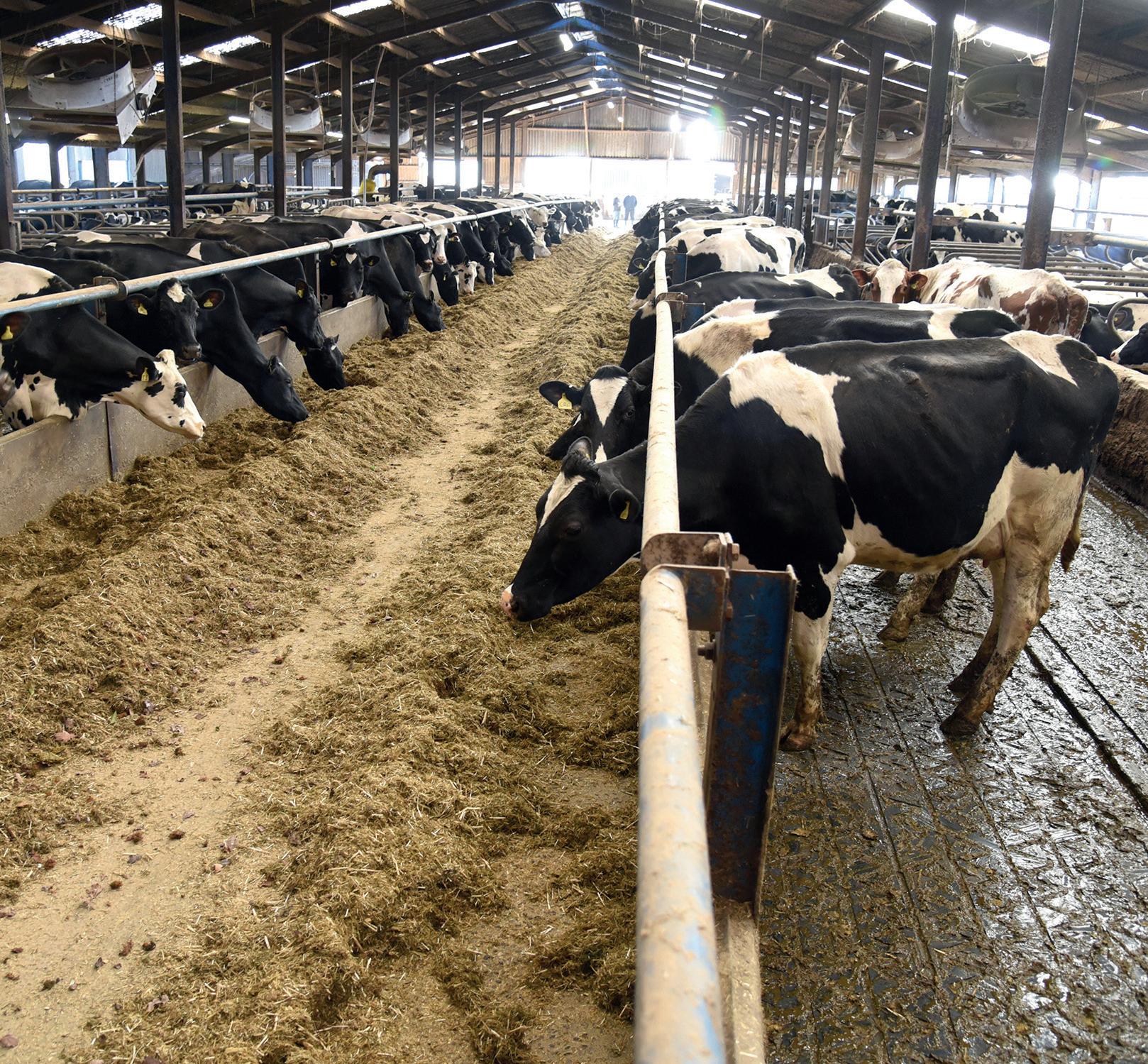
the cows are becoming more fertile and are lasting longer.”
Advancements
Eric says genomics have allowed them to advance their herd far more rapidly, but technology could enable them to accelerate this process further.
“We all know what a good cow looks like, but genomics allows us to identify cows with strong heritability for traits which you cannot see, such
The dedicated rearing unit at Nethergreen Farm houses youngstock aged between eight weeks and 14 months old. Here they are kept on straw yards and fed a diet of ad-lib straw and a bought-in 18% protein concentrate.
Heifers calve at 23-24 months old and are moved back to the home farm in plenty of time to settle before calving.
Beef calves are fed intensively at the Spring Farm site. Youngstock are kept here and grazed over summer and housed over winter, fed on a forage-based diet of silage.
as fertility, mastitis resistance or milking speed.
“We have considered using embryo transfer with our exceptional heifers and cows, as we could then use the lower index cows as recipients, which might increase the number of the highest scoring progeny born each year.”
Ultimately, breeding exceptional cows, Eric says, contributes to the farm’s strategy to spread risk by increasing the number of income sources it relies on.
He says: “Looking ahead, we want to improve our business
resilience by having more than one income stream. We have the AD plant, from which 90% of the electricity is exported to the grid, we have the beef unit and we have genetics.
Exciting
“I nd genomics exciting and challenging, but perhaps not always rewarding, as occasionally you have calves where their index drops compared to the parental average.
“But when you have a pleasant surprise, where a lower £PLI cow has a high index calf, this is when it all pays o .”
Improving resource efficiency
JThe anaerobic digestion (AD) plant was the first step in improving resource efficiency when it was constructed in 2007. It produces 250kWh, of which 10% is enough to run the farm, with the rest exported to the grid.
It is fed with slurry and other farm wastes and the digestate is spread on the surrounding silage ground. The nitrogen, phosphate and potash in the digestate is in a more available form to the grass than in the untreated
slurry, improving plant uptakes and reducing the fertiliser bill.
The heat produced by the AD plant during the generation process is used to heat the calf shed and a large 27,000litre hot water tank; all troughs in the cubicle sheds are supplied with warm water.
By drinking water at almost body temperature, the cows save the equivalent of 3kW (10.8MJ) of energy, which equates to an additional 1.5 litres of milk production per day.
12
APRIL 2023
The milking herd in the cubicle building.
Always Robot Ready with ForFarmers

At ForFarmers we understand what needs to be undertaken in the transition from conventional milking systems to a robotic one. Not only does it involve a different milking method, but also an entirely new way of managing and feeding cows.

Our national team of Robotic Milking Specialists is here to help with feed planning, diet advice, costings and assistance so that you can achieve the best results with the optimum settings.

ForFarmers is proud to offer total robot milking feed support.
For more information speak to your local ForFarmers Robotic Specialist or visit >
0330 678 0982
info.uk@forfarmers.eu
www.forfarmers.co.uk
@ForFarmersUK
DAIRYMatters
‘The future of our industry depends on young farmers progressing’
Dairy farmer
David Brooke writes about his own journey towards retirement and how share farming has given him the opportunity to create a positive work/life balance.

My Dad died at 68, so when I was 58, I decided I needed to think carefully about the ‘rest of my life’. This was 12 months after my dear wife/business partner had passed away at 55.
I was milking 100 cows organically in the Teifi Valley in Carmarthenshire.
We had about 250 cattle on a farm which was within seven years off being paid for and debts, although not insignificant, were under control.
The business was profitable, with minimal labour costs, under control purchased feed costs and low machinery inputs, mainly because of competitive contractor costs.
I enjoyed milking cows, running a business and also some ‘stature’ in the local community.
My children were self-sufficient and independent (largely).
I had also started a new relationship with a lady who was financially independent.
So where now? For me, the ideal scenario for an ageing dairy farmer is to support his or her children
as they continue or develop the business. Make the tea, feed a few calves, take calves to market, become the local union chair, go on the local authority or give time to church or other charities. All rewarding and significant.
My four children did not want to farm (sadly).
I did not want to sell the farm, so I advertised for a share farmer, but was rather nervous about going into business with another.
A local man approached me about renting the farm; he was happily married with three children and perfectly suitable to run his own business.
So four years ago I started a Farm Business Tenancy with him.
We agreed a 12-month trial with an option for five more years.
I also asked my tenant if I could milk once a day to ‘ease me out’ and until recently I was milking about 13 times a week for him (paid of course).
This I enjoyed and I had no real responsibility except to turn up.
Freedom
The freedom this agreement has allowed has meant I have been able to pursue various voluntary roles including work with the bereavement support organisation Cruse; a local farming charity which supports people with mental health difficulties, and another role with a befriending brief.
In the past year, we have bought a smallholding a mile or so from my farm which is my latest project.
I now also milk for a 72-year-old farmer 10 times a week.
I also sing in two choirs, play badminton weekly, go to a yoga class, run a discussion group, swim in the sea locally during summer, enjoy walking, have a busy social life and attend church regularly.
All of this while milking 10 times week, for which I am well paid.
14 APRIL 2023
David Brooke
I can also have time o for holidays. We bought a caravan pre-lockdown, which was the best £250 I ever spent.
e future of our industry depends on young farmers progressing and, with dairy farms in this area knocking a hole in £1.5 million, it is not easy.
I was fortunate to rent a 72-acre council holding in Worcestershire 35 years ago and to have believing and supportive parents.
Many farmers do not save in a pension in spite of tax incentives to do so, but as one of my old bosses used to say ‘it’s not what you earn but what you spend’.


e state pension at more than £700 is not insigni cant, but would be stretched to pay for a rent/mortgage and provide a comfortable living.


Life is all about managing change – something all farming business have to embrace regularly.




e saying ‘today is the beginning of the rest of your life’ is very true.
Many farmers miss the opportunity to rent their farm out and enjoy the freedom this enables because they miss the sense of identity.
I have had people question what I am doing, which does not particularly bother me. In fact I question myself (most days).

What most seem not to realise is that a fair rent is o en a very good pro t. Selling the livestock and machinery (i.e. the business) does enable a reset in any business and if living costs are under control and with a modest mortgage to be paid, life can be much less demanding than full-time dairying.
Life is good (and very precious). My dear Dad used to say ‘life is too short’.
He also said ‘there is no point in being the richest man in the graveyard’. How true.












15 APRIL 2023 Subscribe in spring & save with our VIP+ membership *Terms and conditions apply. New subscribers only, o�er expires May 12, 2023 Call 0330 333 0056 Visit online at: FGinsight.com /spring23 Two easy ways to subscribe *
“ What most seem not to realise is that a fair rent is often a very good profit
Many farmers miss the opportunity to rent their farm out and enjoy the freedom this enables because they miss the sense of identity, says David Brooke.
The latest antimicrobial focus report from Kingshay shows that while reductions in antimicrobial usage have been signi cant over the years, e ort is still needed in certain areas to reduce usage further.
e report, which includes antimicrobial usage data from 1,044 dairy herds across the UK for the year ending March 2022, shows that for the herds sampled, individual herd antimicrobial use ranged from 0.26 to 87.17mg/kg population correction units (PCUs).
However, average total antimicrobial usage for the year was 15.9mg/kg PCU.
is is up slightly on last year’s gure of 15.5mg/kg PCU, but down from 21.7mg/ kg PCU in 2018.
Kingshay says it is encouraging that almost three-quarters (69%) of herds sampled were using fewer antimicrobials than its benchmarking target of 17.9mg/kg PCU.
e target has been calculated by Kingshay based on a 15% reduction in the 2020 target of 21mg/kg PCU set by the Responsible Use of Medicines in Agriculture Alliance (RUMA).
However, the gures also suggest that one-quarter of herds sampled were responsible for 49% of total antibiotic usage.
Dr Tim Po er, Kingshay and Westpoint Farm Vets senior clinical director and co-author
While there has been a significant reduction in the use of antimicrobials for the last three years, according to the latest antimicrobial focus report

Plateau in antim
of the report, says the plateauing gures demonstrate there are still certain areas of usage which require more a ention.
Dr Po er adds: “Early wins have been made in terms of re ning antimicrobial usage on-farm, but continued e ort and further changes are required to reduce the usage further.
“A proportion of herds –the top 25% of antimicrobial users – are accounting for a large amount of usage, so vets and advisers need to be really speci c about targeting those high-use farms and work with them to make further progress.”
According to the report, if
the highest 25% of antimicrobial users cut their usage by onethird, the overall average herd usage across the board would reduce to 13.3mg/kg PCU and 79% of herds would then fall below the 2024 usage target of 17.9mg/kg PCU.
Dr Po er says the report also reveals that injectables remain the most used route of antimicrobial administration on dairy farms, highlighting an area for improvement going forward.
He says: “Injectables account for 70-76% of usage, irrespective of whether the farm is a heavy or light user of antimicrobials. “ ey are generally used
for sick cow management, so there is real value in people regularly reviewing their treatment protocols with their vets to ensure they are using the right products.
Changes
“Regular reviews can also help identify potential management changes, such as making improvements to buildings, disinfection protocols and nutrition, or introducing vaccination programmes which could help reduce the need for antimicrobial treatments in the rst place.” e use of lactating cow and antibiotic dry cow tubes
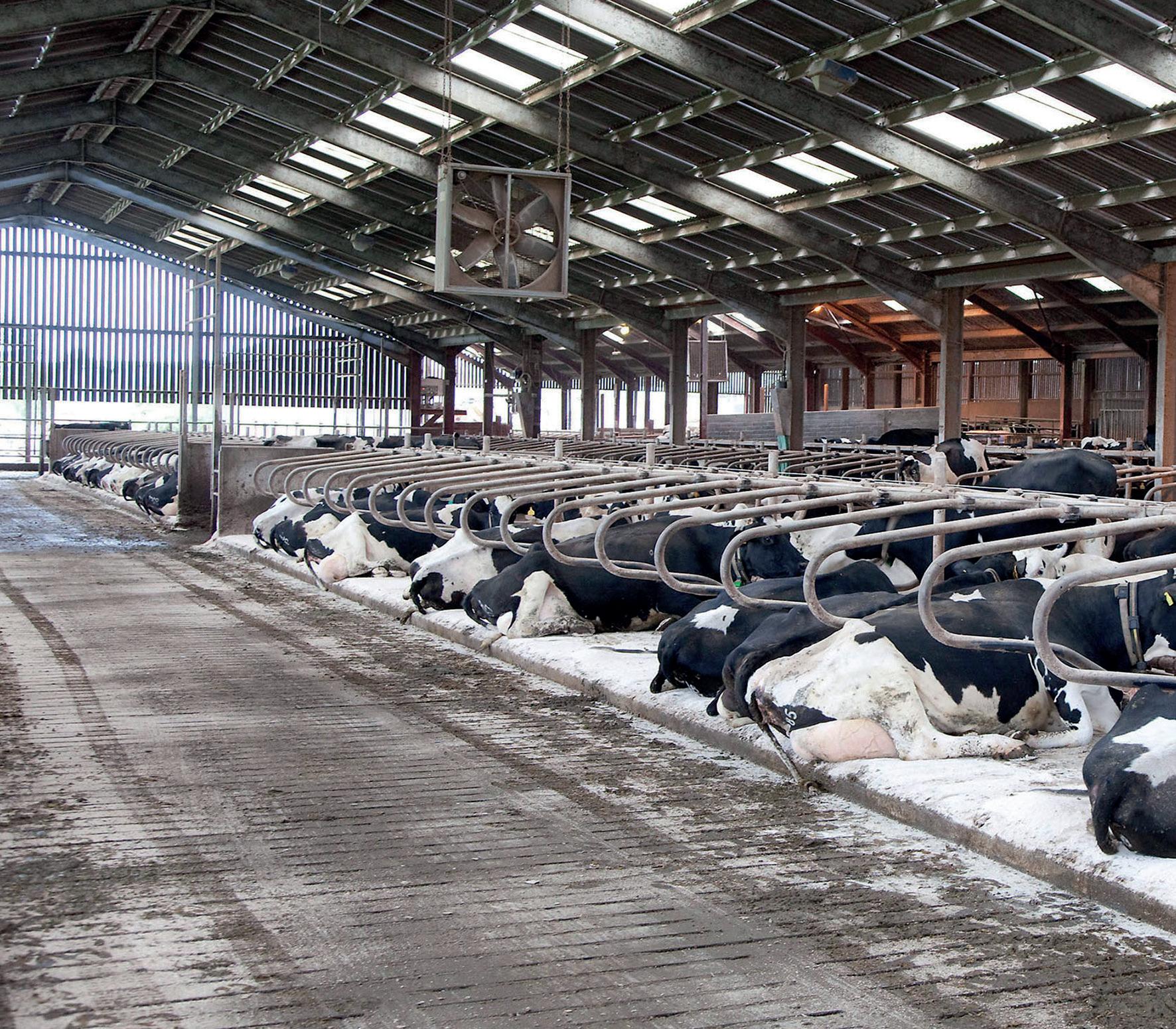 Dr Tim Potter
Dr Tim Potter

16 VET’S VIEW APRIL 2023
Almost three-quarters of herds sampled were using fewer antimicrobials than Kingshay’s benchmarking target of 17.9mg/kg PCU.
on dairy farms since 2018, that decline has been plateauing from Kingshay. Katie Jones reports.

icrobial usage
is declining in line with the RUMA targets. However, Dr Potter says there is still scope to reduce usage further.
He says: “It is encouraging that 99 of the herds in the sample used no antibiotic dry cow tubes at all during drying off, but a large proportion of the herds sampled [33%] were not using teat sealants.”

According to Dr Potter, responsible antimicrobial use is not just an ‘end goal’, it should be viewed as an ongoing process.
He says: “We see circular change on-farm, so it is important to continuously go through that review process.
“For example, if we have seen a problem with a particular disease, we need to think about what we are doing to prevent that disease next year.”
Kingshay antimicrobial product owner

Christina Ford, who co-authored the report, says a regional breakdown of the data shows antimicrobial usage was higher in the North, Wales and Scotland, when compared to the southern regions.


She says: “The regional variation in antimicrobial usage identified by the report is really interesting, but further work is required to understand what is driving this.”
Dr. Laura Tennant Young Animal Feed Technical Adviser Trouw Nutrition GB

For more details about OsmoFit contact Laura at trouwnutrition.co.uk/osmofit






17 VET’S VIEW APRIL 2023
“Rehydration of calves with OsmoFit is easy and key to maintaining health, performance and growth.”
Christina Ford
Earlier diagnosis and a more accurate detection of lung consolidation makes lung scanning a positive tool in detecting and managing pneumonia in calves. Katie Fallon reports.

How lung scanning can aid pneumonia management
ith an estimated annual cost of £80 million to the UK cattle industry, pneumonia is one of the main causes of calf deaths within the UK’s dairy herd. Therefore, accurate diagnosis of infection is crucial to providing effective treatment and reducing the associated on-farm costs. A relatively new diagnostic service which is increasingly being used by vet practices in the UK to identify pneumonia among calves is lung scanning.
Method
Providing a more sensitive and accurate method of detecting lung consolidation, vet
Gwen Davies, of Nantwich
Farm Vets, says lung scanning allows for the detection of pneumonia issues within a group of calves.
Lung scanning is also able to diagnose sub-clinical damage and disease, which is often a hidden cost to the farmer, says Ms Davies.
She says: “Some animals may
Wnot show any signs of pneumonia or may show subtle signs, which might have been missed.
“Lung scanning provides a more sensitive tool in identifying lung consolidation lesions, compared to auscultation or clinical scoring.”
Routine
The service can also be used as routine practice to aid on-farm management of pneumonia and reduce the number of pneumonia cases in the long run.
Ms Davies says the process of lung scanning uses a linear ultrasound probe, as used for pregnancy diagnosis in cattle, to scan the lungs for evidence of lesions associated with pneumonia.
This includes areas of consolidation and inflammation, which indicate the presence of a pneumonia infection.
Ms Davies says: “The process involves spraying the area over the ribcage with surgical spirit and placing the ultrasound probe in between the rib spaces to scan different areas of the lungs on both sides of the animal.”
She adds that while the process is fairly limited when identifying
lesions deep within the lungs, it accurately detects superficial consolidation of lung tissue.
Once scanned, the lungs are then visually scored from zero to five. Zero means lungs are normal with no pneumonia present and five means there are multiple lesions present within multiple lobes and treatment for pneumonia is required.
Ms Davies says the scores are based on the number of lesions seen and the number of lung lobes affected.
Vet Jimmy More, of Bovine Lung Ultrasound UK, says lung scanning should be carried out on calves during the pre-weaning stage.
This is due to the vast majority of pneumonia not occurring until after 26 days of age and that practically, once calves reach the weaning stage, their size and weight becomes problematic for easy handling. He advises scanning all calves within that age group to understand the level of infection on-farm.
While lung scanning can be carried out as a monitoring process in response to an increase
in pneumonia cases, Mr More believes using the service as a way of identifying animals to treat does not prevent infection.
He says: “Once you are picking an animal to treat, you have lost your 500 litres. Any calf which gets an area of consolidation in its lungs before weaning will produce 500 fewer litres in its first lactation.
“If heifers have suffered with sub-clinical damage to their lungs, they will never reach their true potential.”
Therefore, Mr More advises farmers to use lung scanning as a routine practice on all calves to ensure effective pneumonia management is in place and the associated costs of reduced performance are lowered.
“It is much better to reduce the level of consolidation going
18 YOUNGSTOCK APRIL 2023
Some animals may not show any signs of pneumonia or may show subtle signs, which might have been missed
GWEN DAVIES
forward rather than seeing that pinpoint action as treatment.”

When looking at the cost of lung scanning, Mr More says most vet practices will only charge for their time to carry out the process, rather like when pregnancy scanning ca le, making it a relatively cost-e ective option compared to pneumonia treatment on a case-by-case basis.
Results






He adds that the immediate results and ability for farmers to visually see the lung consolidation themselves means it o en becomes routine practice following the initial use.






While it is a process not all farmers will be aware of, Mr More says the interest in lung scanning is growing, with an increasing amount of vet practices o ering it to their farmers.
Not limited to identifying pneumonia in calves, the process can also be used to identify rumen drinking, assess calves entering rearing units and assist with pre-breeding heifer dra ing.





19 APRIL 2023
Volac International Limited, Volac House, Orwell, Royston, Hertfordshire, SG8 5QX, United Kingdom T +44 (0)1223 208 021 · enquire@volac.com · Copyright © 2023 Volac International Ltd. All rights reserved. . FOR GROWTH HEALTHIER
Animal Nutrition 02291 CMR Lifeguard Reflection Advert Dairy Farmer 188x137mm March 2023.indd 1 14/03/2023 07:52
Volac’s Lifeguard range of milk replacers all contain ImunoproTM, our unique concentrated milk protein, which enables better development of the early life immune system and stimulates the young calf’s digestive system, crucial for fast, healthy and sustainable growth. feedforgrowth.com
FUTURE.
Lung scanning is a relatively new diagnostic service being using to identify pneumonia in calves.
AWARDS NOW OPEN FOR ENTRIES



The British Farming Awards returns for 2023 and is now open for entries and nominations as we aim to shine a light on the phenomenal work taking place across the industry and the driving forces behind it.

Supported by Morrisons, farming’s much respected event – the British Farming Awards – is back for its 11th year and will celebrate the diversity and resilience of UK farmers and their businesses.
Alongside our core farming sectors – arable, beef, dairy, sheep and beef – we also recognise the importance of sustainable farming practices and innovations within the digital and agritech arenas.
The awards also champion the role of family farms, new entrants and agricultural students – all of which are vital to the future of the industry.
Positive changes
The awards also welcome nominations of businesses which have introduced positive changes, streamlined production and efficiency, and adapted structures to tackle ongoing challenges presented by policy, legislation, the environment and volatile global commodity markets.


















Sophie Throup, head of agriculture, fisheries and sustainable sourcing at Morrisons, says: “As long-term supporters of British farming, we want to thank farmers across the country for the work they continue to do in these challenging times.
“We are pleased to once again be supporting the British Farming Awards, recognising the effort, care, innovation and skills British farmers put into making and providing the food we are all proud of.”
We know the UK is home to some of the best and brightest farming talent in the world.
From its rich history in technology and innovation, its place in feeding an ever-growing population and, of course, nurturing our natural world – there are infinite reasons to be proud of.
That is why we believe our British Farming Awards are so important; to celebrate the talent, the ingenuity and the often-unsung heroes in our sector.
Of course, the awards are much more than that – as well as helping
WORD FROM THE EDITOR
to communicate farming’s fantastic stories to the wider public, the event is a chance to enjoy an evening of celebration among farming peers and collectively mark each other’s achievements.
As with any busy job, it is difficult to appreciate how far you have come until you take a step back. But the awards are a chance to do just that.
Many of our previous entrants credited the application process as offering a chance to reflect and think objectively about their business or product and what opportunity
and success looks like for a happy future.
After another challenging year, it is more important than ever to take stock and come together to enjoy our world-class industry and the people behind it who make it tick and go that extra mile.
OLIVIA MIDGLEY Editor of Farmers Guardian

OUTSTANDING CONTRIBUTION TO BRITISH




XThis prestigious award is designed to recognise one individual’s dedication to the farming industry.
Innovation
The award is given to a member of the agricultural industry who has worked tirelessly for UK farming, either through delivering innovation, championing the needs for fellow farmers, spearheading change and/or
FLYING THE FLAG FOR BRITISH AGRICULTURE
X This award recognises an individual or group of people who are flying the flag for British agriculture by making a positive difference across the agricultural industry.
They may be campaigning about a specific cause or issue and/or raising positive awareness about the role of farming to the public.
You can nominate someone you feel is flying the flag for British agriculture. They will not be notified that they have been nominated unless they are chosen as the winner of the award.
Awards night
This award is chosen by the British Farming Awards team and announced during the awards night.
promoting the industry to the wider public.
You can nominate someone you feel is working tirelessly for UK farming. They will not be notified that they have been nominated unless they are chosen as the winner of the award.
This award is chosen by the British Farming Awards team and announced during the awards night.


britishfarmingawards.co.uk
Vox Conference Centre, Birmingham Thursday, October 19, 2023 AGRICULTURAL STUDENT OF THE YEAR AGRITECH INNOVATOR OF THE YEAR CONTRACTOR OF THE YEAR Sponsored by Kuhn DIGITAL INNOVATOR OF THE YEAR DIVERSIFICATION OF THE YEAR (small to medium) Sponsored by NFU Mutual ARABLE FARMER OF THE YEAR BEEF FARMER OF THE YEAR Sponsored by ABP DAIRY FARMER OF THE YEAR Sponsored by KW Alternative Feeds THIS YEAR’S CATEGORIES
Last year’s winner Tom Pemberton.
AGRICULTURE
20 APRIL 2023
Last year’s winner Phil Stocker.
PREVIOUS WINNERS HAVE THEIR SAY

We couldn’t quite believe someone had nominated us for the award, but it is nice to know other people see what we see for the business and its future




James and Emma Loder-Symonds

Nonnington Farms, Kent Winner of Arable Farmer of the Year at last year’s British Farming Awards

Social media helps us to sell our story to the public. These awards are shouting about what the industry is doing and telling good news stories
Ewan Irvine and Emma Gray
Sheepdog School, Argyll and Bute Winner of Digital Innovator of the Year and Diversification (small to medium) at last year’s British Farming Awards
It feels amazing [to have won] and I am very humbled. I am proud to be a part of an incredible industry which has only grown through adversity
Gordon Davis Rivermead Dairy, Devon Winner of Dairy Farmer of the Year at last year’s British Farming Awards
KEY DATES
Entries and nominations open


JUNE 27



Entries close

AUGUST 11

Shortlist announced










AUGUST
Judging and interviews take place
OCTOBER 19 Awards night
Sponsored by
DIVERSIFICATION OF THE YEAR (large) GRASSLAND FARMER OF THE YEAR Sponsored by Germinal FAMILY FARMING BUSINESS OF THE YEAR Sponsored by Goodyear SHEEP FARMER OF THE YEAR Sponsored by SAI Global OUTSTANDING CONTRIBUTION TO BRITISH AGRICULTURE Sponsored by NSF FLYING THE FLAG FOR BRITISH AGRICULTURE Sponsored by Eternit SUSTAINABLE FARMER OF THE YEAR Sponsored by Lloyds Bank FARM WORKER OF THE YEAR Sponsored by Isuzu NEW ENTRANT: AGAINST THE ODDS Sponsored by Massey Ferguson For more information on the categories and how to enter and/or nominate, visit BRITISHFARMINGAWARDS.CO.UK
MARCH 17
21 APRIL 2023
Last year’s winners celebrate together after winning their awards.
After buying his own farm in 2018, young farmer Jesper Toft Bitsch has invested in cow accommodation and automation. Chris McCullough reports.
Dream comes true as young farmer buys dairy unit
Having worked on and managed a number of dairy farms a er completing his education, it was always Jesper To Bitsch’s dream to one day own his own unit and milk his own cows.
However, the road to that goal is never easy for young farmers like Jesper, trying to get into the dairy industry with hurdles such as nance and farm availability to overcome.
Jesper trained as a farmer at Denmark’s Agroskolen and Bygholm Agricultural School in 2012 and then took a job as the feeding manager on a farm with 500 cows.
In 2014, he then moved to another farm as feeding manager,
before becoming quali ed as an agricultural economist.
By 2018, his aspirations of running his own farm fell into place, as a 150-hectare (370-acre) unit at Aulum, central Denmark, came up for sale, and he was able to buy it.
Jesper, now 31, says: “ at was the start of my journey to being my own boss as a dairy farmer. Armed with a detailed business plan I was able to secure enough funding to purchase the farm and start to change things around on the original dairy system.”
One of the biggest changes Jesper made was converting the farm to organic status in the hope of achieving higher milk prices.
e price he receives currently is 66 euro cents per litre (59ppl).
Jesper started o with 160 cows and, in 2020, built a new shed to accommodate more stock. Since then he has increased cow numbers to 220 and achieves an annual average yield of 12,200kg.
Younger cows
e new shed, which also has space for dry cows and calving pens, was built almost perpendicular to the original shed, which today houses younger cows.
ere are three Lely Astronaut A5 milking robots installed, two in the old shed and one in the new one, each milking 65 cows.
Jesper says: “I am budgeting for 60 milking cows per robot, but they can easily handle 65, so we have slightly increased the number of cows.
“ e new shed cost 3.2 million Danish Krone to build and contains 112 cubicles plus a section for calving pens and sick bays.

“All the cubicles are bedded with sand, as we nd it keeps the beds much drier. I was very familiar with using sand on the other farms I worked on, therefore it was an easy decision to use it on my farm as well.”

Jesper is aiming to use only locally grown protein in the cow diet.
He says: “We do not use soyabeans as they are usually imported from overseas and it is not always clear if they are grown in a sustainable way.
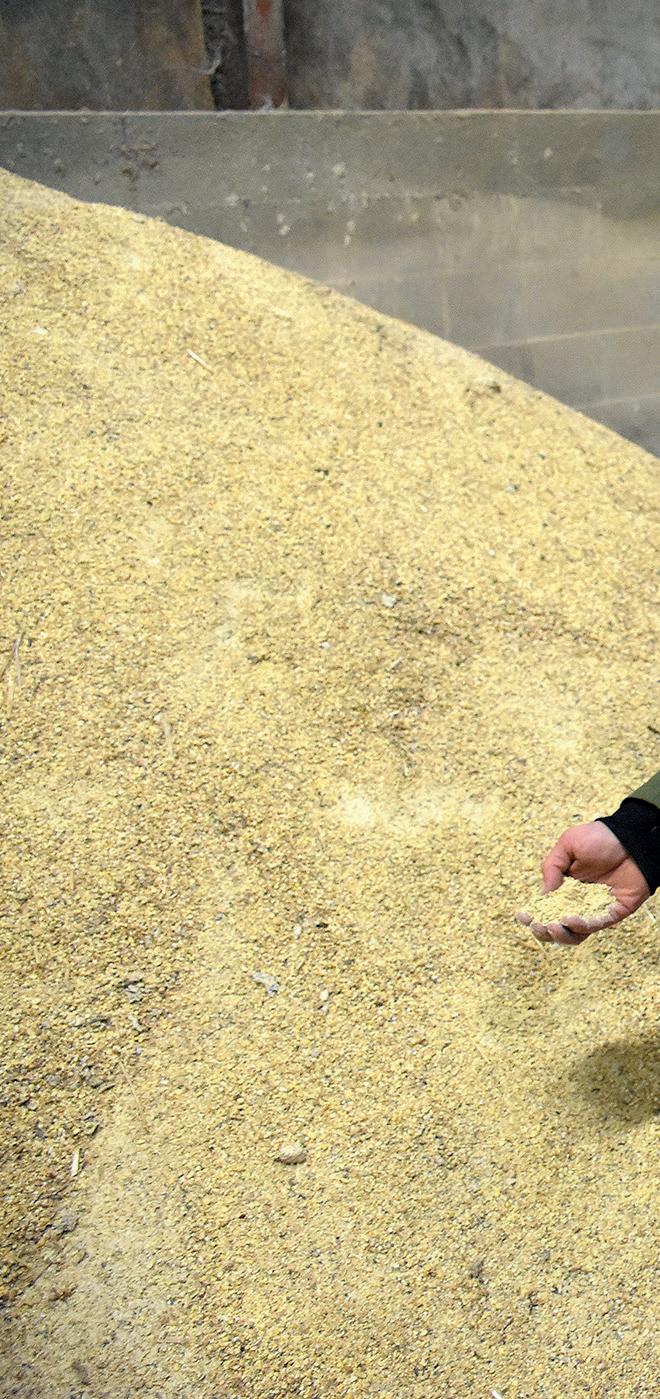
“Our milk is supplied to dairy company iese, which some years ago decided its producers should

Farm facts
rThe farm is 150 hectares (370 acres), with an additional 25ha (62 acres) rented



rCows are yielding an average of 12,700kg a year

rTotal mixed ration is based on grass, field beans, canola and lupins

22 WORLD DAIRYING DENMARK APRIL 2023
The new shed houses 112 cubicles and calving pens.
Jesper Toft Bitsch sources his protein locally.
stop using soyabeans in the feed. Instead, we use locally grown grass, eld beans, canola and lupins in our rations. ey do not t in very well in a crop rotation for milk producers who grow a lot of clover grass and maize, but it is easily grown
by neighbours and is therefore not transported over long distances.
“For some time our organic milk producers have been phasing out the use of soyabeans and now our conventional producers are beginning to do the same.

“Danish dairy companies no longer accept GMO soyabeans and non-GMO soyabeans are very expensive. erefore, the advice is to replace soyabeans with other protein crops.”
Jesper is aiming to keep protein levels in the total mixed ration (TMR) under 17%, which is in line with a voluntary agreement made


by Danish milk producers three years ago. At that time, about 50% of producers used more than that level. Jesper says: “ e agreement was put in place to prevent public regulation. By reducing the protein percentage in TMR, we as livestock farmers can help contribute to the overall goal of reducing ammonia emissions.”

23 DENMARK WORLD DAIRYING APRIL 2023
The new shed includes calving pens as well as a sick bay.
Choosing the right genetics for the future of the herd is one of the most important decisions influencing performance. Chloe Palmer learns more.
Power of genetics
Improved performance in a herd as a result of be er genetics is permanent and cumulative. is is according to Marco Winters, head of animal genetics with AHDB, who spoke at a Peak Farmers Group event on ‘modern genetics’.
He said: “ e performance of a cow is in uenced by her genetics and external environment. If poor breeding decisions are made, these genes will remain in the herd for six to seven years,” he reminded farmers.
Low input
He also highlighted genetics were not just important for high yielding dairy herds, and he said it could be argued they were even more critical for low input, extensive systems because, for these, the farmer was more reliant on ‘good genes’ for performance.
“A genetic evaluation of an animal excludes all the ‘environmental noise’ a ecting performance such as feeding and other aspects of management. is allows for the comparison of two animals which are managed very di erently.”
Historically, genetic improvement focused mainly on yield
but, more recently, fertility and health traits such as somatic cell counts (SCC) and lameness have come to the fore, said Mr Winters.
Production
He said: “We are now concentrating on traits most likely to deliver increases in daily lifetime yield. e Pro table Lifetime Index [£PLI] is the single most important measure in uencing this, followed by fertility, longevity, protein content and SCC.
“ e consumer wants increased supply, cheaper products, healthy animals and more sustainable production. Producing more from less is the focus for the dairy cow of the future.
“Producers currently on a liquid contract should consider fat and protein when selecting

MARCO WINTERS
genetics, because the scope for market growth is greatest in value added products such as cheese and exports.”
Genetic advancement has allowed producers to make choices about which animals to keep in the herd and which to sell, said Mr Winters.
“In the 1970s, when producers were breeding for yield, fertility decreased, but now fertility has recovered beyond where it was, and this is coupled with increased production.
“ e average number of lactations for a dairy cow is between 3 and 3.5 and this has changed li le. e e ciency sweet spot is the h lactation but this does not consider the potential from bringing in newer, be er genetics.
“ e decision as to how long to keep a cow will depend partly
Continues over the page...
on the cull cow price, but the cost of keeping cows increases a er the fourth lactation because there are generally more mastitis and lameness problems,” said Mr Winters.
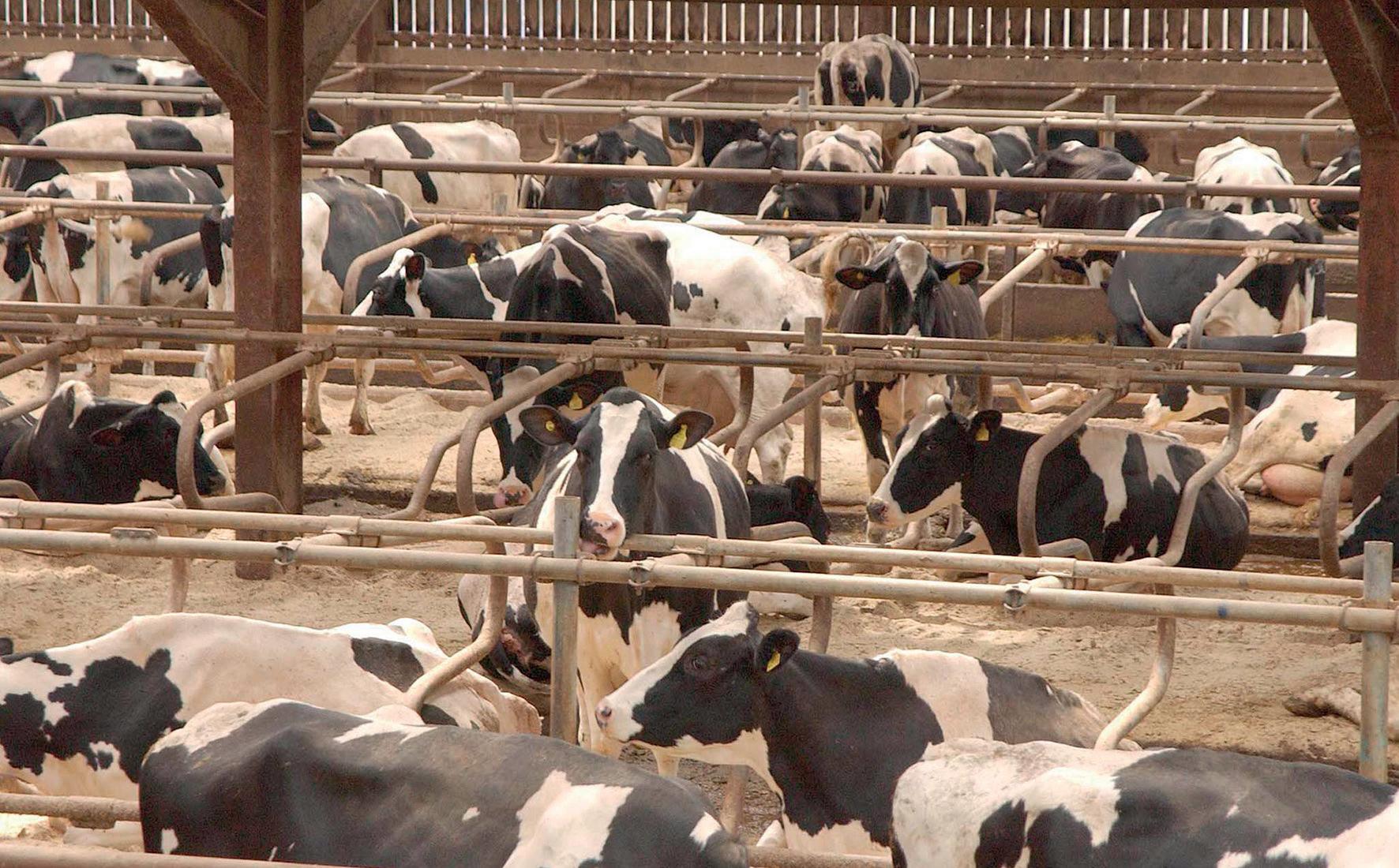
Genomics
He also said genomics had been a game changer over recent years, and was something he described as a ‘very powerful tool’.
“Genomics allows us to ‘look inside’ a newly born calf and predict her future potential. Herds using genomic testing are making faster progress than those which do not.
“Genomic testing can identify the best 20-30% of the females to be selected for sexed semen, allowing the genetic potential of the herd to increase more rapidly. is translates into increased pro tability.”
24 BREEDING APRIL 2023
Producing more from less is the focus for the dairy cow of the future, said Marco Winters.
Herds using genomic testing are making faster progress than those which do not
AT NFU MUTUAL, WE’RE BIG ON LOCAL PRESENCE
Although we’ve grown, we haven’t lost our personal touch. With a network of over 295 UK agency offices, we can get to know you, your family and your farm.
To see how our policies and services can benefit your farming business, search ‘NFU Mutual Farming’ or contact your local agency office.
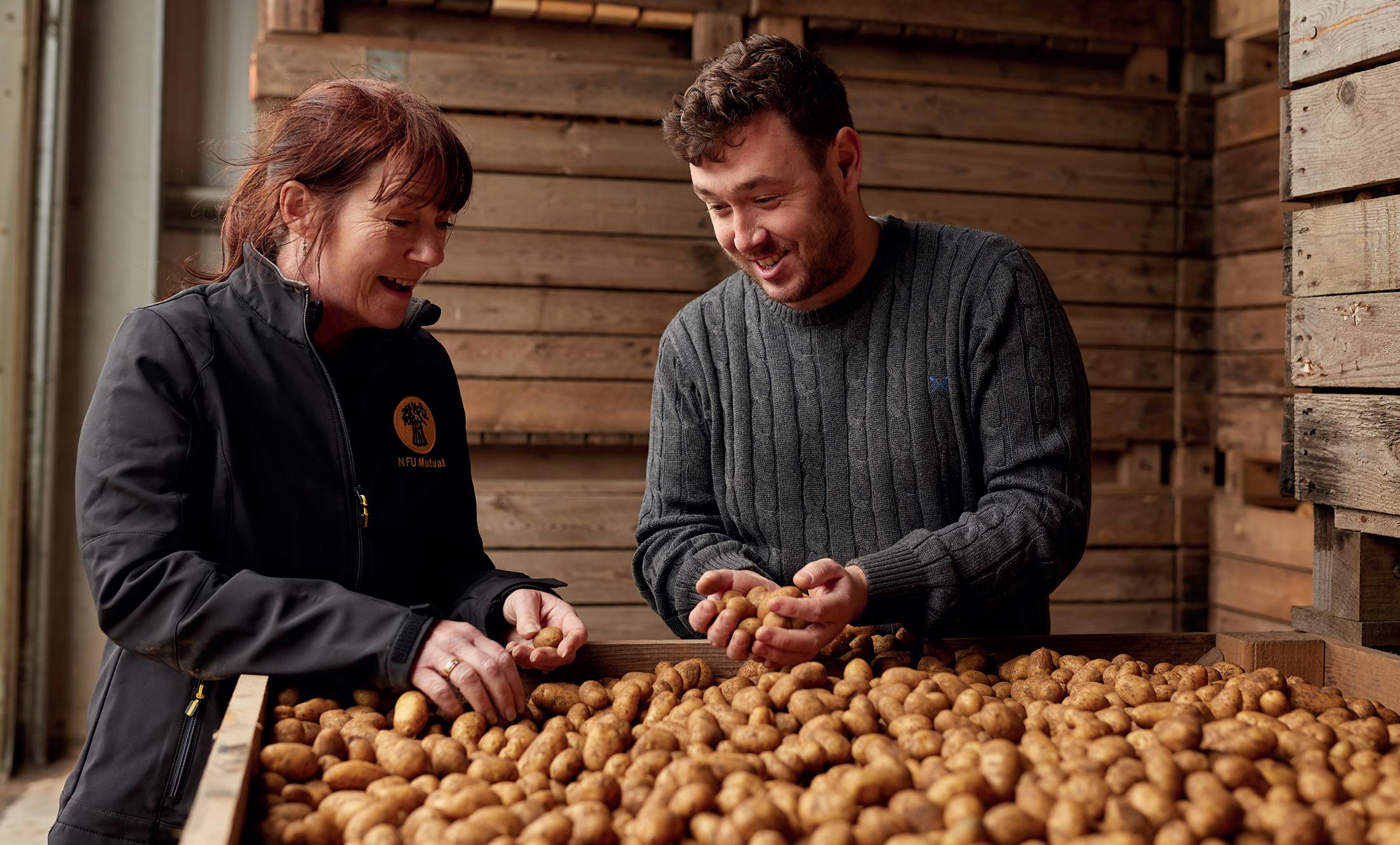
The National Farmers Union Mutual Insurance Society Limited (No. 111982). Registered in England. Registered Office: Tiddington Road, Stratford-upon-Avon, Warwickshire CV37 7BJ. Authorised by the Prudential Regulation Authority and regulated by the Financial Conduct Authority and the Prudential Regulation Authority. A member of the Association of British Insurers.
BREEDING
Four steps to improved breeding outcomes
rUnderstand where you are starting from – milk record at least four times a year and register for a Herd Genetic Report
rSet breeding goals –
where do you want to be?
rChoose the best index for your system – one size does not fit all
rConsider genomics for accelerated improvement
What are your breeding goals?
similar weighting across the three indexes.”
Marco
encouraged producers to
record at least four times a year to provide the information to generate a Herd Genetic Report.
Beef from dairy herds
JThe value of the beef calf has become more important for dairy businesses over the last decade and 60% of UK beef now comes from the dairy herd. Mr Winters said the market for beef from dairy was likely to continue to increase.
“Some buyers, such as McDonald’s, may well be looking to source their beef entirely
Glossary
rHeritability: The proportion of a parental trait that is passed onto the next generation
rGenomics: Identifies specific gene sequences in a young animal’s DNA that are associated with preferential trait performance
rGenotype: The underlying genetics which predict potential
rPhenotype: The observable traits resulting from genetics
rProfitable Lifetime Index
(£PLI): A within breed index which indicates the additional profit that a daughter of a high £PLI bull is expected to earn over her lifetime, compared with a
from dairy herds because of its reduced carbon footprint.
“AHDB analyses all the beef from dairy abattoir data giving figures for carcase conformation, average daily carcase gain and therefore days to slaughter to give a dairy carcase index.
“To help us provide this data, it is vital the sire of all animals is recorded.”
J Mr Winters urged farmers in the audience to identify their breeding goals at the outset, and he said the three lifetime indexes offered by AHDB (£PLI, £SCI and £ACI) allowed those with different systems to select the right genetics for their herd.
Farm models
“Behind each lifetime index is an economic farm model which uses feed, milk and cull prices to calculate which genetics will perform and translate into profit for each system.
“For example, for spring and autumn calving herds, fertility is given a greater weighting as it is more critical to success.
An increased focus on sustainability has led to the development of the ‘Feed Advantage’ and the ‘EnviroCow’ traits, said Mr Winters.
“There is a very strong link between environmental performance, feed efficiency and profit and these traits indicate a cow which can produce more from less.
“The ‘EnviroCow’ trait combines the traits of productivity, longevity and feed advantage. We calculate the EnviroCow genetics are responsible for a 1% year-on-year improvement in carbon footprint.
daughter sired by an average bull with a £PLI of zero
rSpring Calving Index
(£SCI): An across-breed genetic ranking index developed to breed cows that produce lower volumes of milk of a higher quality. It is specifically for spring block-calving herds, which rely heavily on grazed grass and calve in a block of 12 weeks or less
rAutumn Calving Index
(£ACI): Suitable for autumn block-calving herds and reflects the costs of feeding for winter milk production and the higher milk price per litre received at that time of year
“For an all year round calving herd, production traits are given more prominence. All the health traits are given
MARCO WINTERS
Greenhouse gases
“This will lead to a 20% reduction in greenhouse gas emissions by 2040, purely because of better genes.”
Mr Winters stressed the importance of reliable data for all breeding decisions, urging producers to milk record at least four times a year to provide the information to generate a Herd Genetic Report.
“The Herd Genetic Report is free of charge to levy paying milk recording herds and it gives us a starting point to produce regular benchmarking reports both for the milking herd and youngstock.”
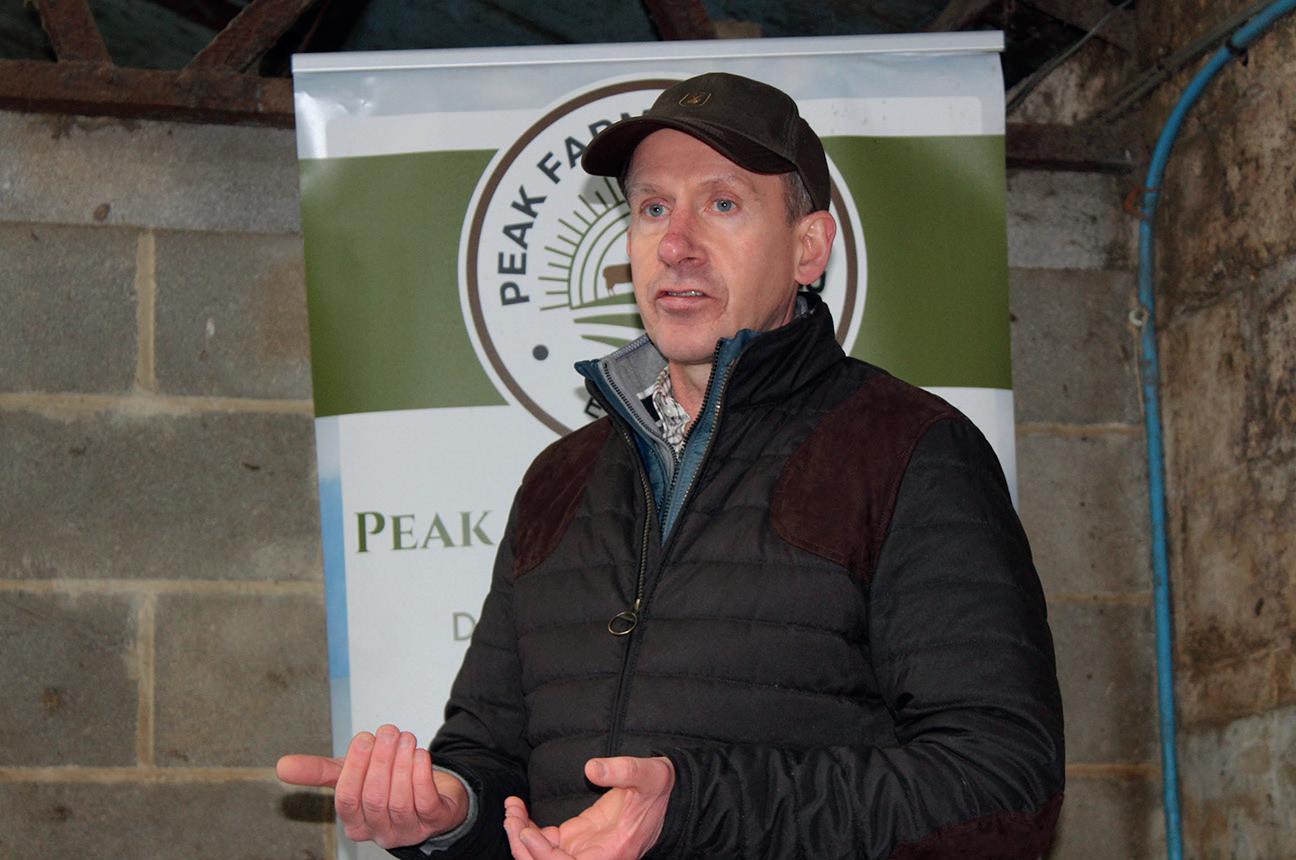
26
APRIL 2023
Winters
milk
The ‘EnviroCow’ trait combines the traits of productivity, longevity and feed advantage



27 APRIL 2023 I would not look back after making the switch to EASYFIX, just seeing how comfortable and content the cows are, a picture paints a thousand words www.easyfix.com Providing Farmers With Peace of Mind 07985 602767 - Tom Pemberton Farm Life Our Dairy Housing Solutions Are Grant Approved! Call For A Free Quotation
Silage lessons
Last season’s heatwave provided some big lessons for making grass silage. So what can we learn from 2022?
If someone had told you at the start of 2022 that by summer you would be staring at a grass silage shortfall due to drought, would you have approached earlier silage cuts any differently?
Not all parts of the country experienced drought, but even if you were fortunate enough to escape relatively unscathed, there were still key lessons, Volac’s silage experts around the UK agree.

Peter Smith, who operates throughout Wales and parts of the English Midlands, says: “The major grass silage lesson that 2022 underlined for me was that a multi-cut approach can bring big advantages.
“The term multi-cut can put some farmers off, but it does not necessarily mean cutting six times a season. It might simply mean taking four cuts rather than three.
“The important point is to take that first cut earlier. For example, in April rather than late May, when
there is an increased risk of grass going to head.
“For a number of years we have seen that farmers with the best silage have tended to cut earlier and more often.
“Last season underlined this because the drought triggered a stress response in grass which caused it to head prematurely, so there was little extra growth after that point and quality was lost. Producers who cut earlier avoided this.”
Fresh regrowth
By taking first-cut earlier, Peter says it clears out over-wintered grass to encourage fresh regrowth for a better second cut, plus it means some silage is safely ‘banked’.
He says: “A survey we conducted among more than 700 UK dairy farmers at the end of last year showed almost half (45%) of those making multi-cut had already taken two cuts by the end of May, compared with only 17% in the conventional group.
SILAGE-MAKING LESSONS FOR 2023

● Consider taking first cut earlier for less risk of quality losses due to heading, less risk of bulky crops and potentially better contractor availability
● Consider more cuts over the season; this is shown to produce better grass quality and higher overall DM yield
● Get wilting technique right; trials have shown that
tedding immediately after cutting dramatically reduces wilting time. Lighter crops are also easier to wilt
● Use a proven additive to improve fermentation; Ecosyl has been shown to produce a rapid pH fall and inhibit ‘bad’ bacteria; it has also halved DM loss, preserved more ME and true protein and improved milk yield from silage
“And nearly twice as many multi-cut makers as conventional silage-makers felt their silage quality was actually better than normal in 2022 – at 20% versus 12%.”
Overall, Peter says grass silage yields were 5-10% down in his area, but harder hit were the southern counties of England, where Volac silage expert Ken Stroud says they were 10-15% down.
Ken agrees that 2022 underlined the benefit of a multi-cut approach.
Ken says: “Although the summer drought hit grass growth particularly hard in southern England, in spring we actually had good growing conditions, so initially there was plenty of grass.
“While some farms used this as an opportunity for an early first-cut, those who waited until later started to run into problems with crops producing excess bulk.
“This had two consequences. Firstly, bulky crops took longer to wilt and we know that longer wilting leads to higher in-field losses in sugars and proteins.
“Secondly, they contained a lot
of dead grass in the sward base and dead grass is prone to yeast and mould growth, leading to problems with silage heating.
“Those who took the opportunity for an early first-cut produced some superb second cuts of up to 12.25MJ/ kg dry matter [DM] of metabolisable energy [ME], while poorer crops were down at about 10.3 ME.”
Silage stocks
Another negative legacy of seasons like 2022 when silage yields are down, says Ken, is if spring grass growth for turnout the following year is slow, because there will be limited silage stocks for buffer feeding.
He says: “Sometimes, it can be difficult for farmers to grasp the benefit of multi-cut because they focus on the cost of additional cuts. But it is important to see the bigger picture.
“From our own trial work, cutting grass five times actually yielded more DM over the season and produced grass on average three D units higher in digestibility and almost 3% higher in crude protein.
28 SPONSORED CONTENT APRIL 2023
from last year
“Extra cuts may cost a bit more, but having extra silage in stock can be a life saver, and producing better quality silage is the foundation for more milk from forage. If you look after it, well-conserved silage can last in the clamp for years.”
Northern England
In northern England, Jason Short reports a more mixed 2022 silage
CHECK OUT THE CAMPAIGN FOR BETTER SILAGE
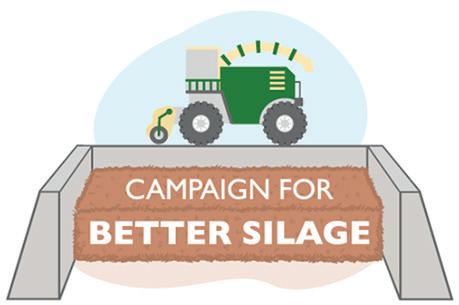

season, with some locations experiencing a favourable summer with good grass growth while others were hit by drought.
Overall, Jason says northern England grass silage yields were down 5-10%. He says forage maize did not come to the rescue because maize yields were as much as 20-40% down.
Jason says: “Years like 2022, when grass quality and quantity are down, underline the importance of not letting any more slip away in the clamp or bale.


“This comes down to good harvest practice and good clamp management, but also down to correct additive choice so fermentation is not simply left to chance.
“Research on the additive Ecosyl has shown it to halve DM losses, which means more DM is available to feed.
● As well as its Cut to Clamp initiative, Volac is proud to be one of the sponsors of Dairy Farmer’s Campaign for Better Silage. See page 45 or visit FGinsight.com/bettersilage
“In other work, Ecosyl treatment has also been shown to boost average ME by 0.6 MJ/kg DM, to improve digestibility by three D units and to preserve more true protein.
“In independent dairy trials, feeding a range of silages preserved with Ecosyl also boosted milk yield by an


average of 1.2 litres per cow per day. Sometimes farmers think protecting silage with an additive is expensive. But what is actually expensive is losing DM or quality after you have gone to the expense of making silage, then having that poorer silage impact on milk from forage.”
Scottish silage
Volac business manager in Scotland, Alan Smith, says there was no drought in Scotland in 2022.

Indeed, it was one of the best years he can remember for grass growth, with second and third cuts producing good yields and quality. But there were issues with some first cuts – which, once again, those cutting early managed to avoid.

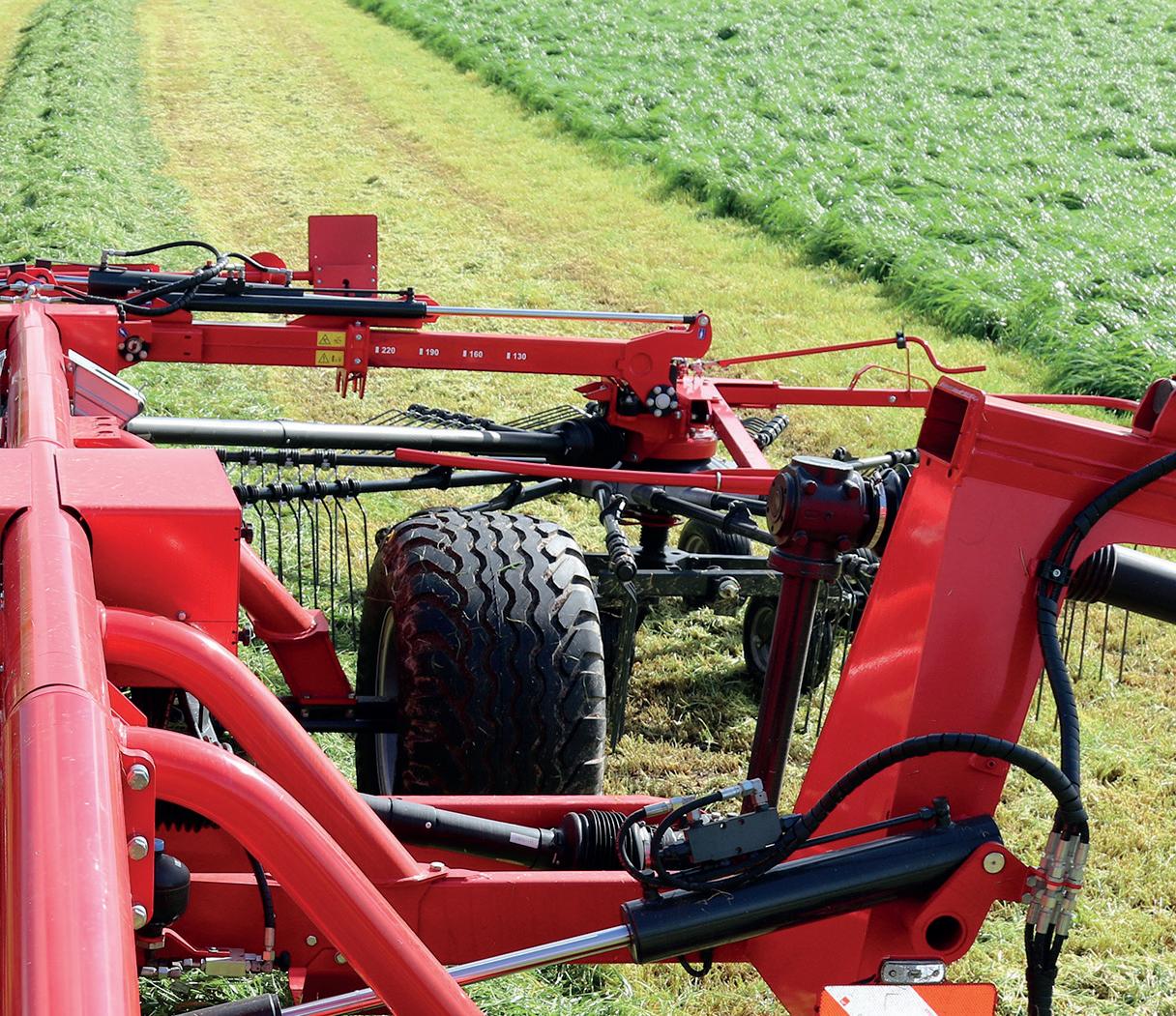
Alan says: “Some farmers took first cuts early, but then we had one to two weeks of poor weather and, by the time others got to first cuts, grass crops were
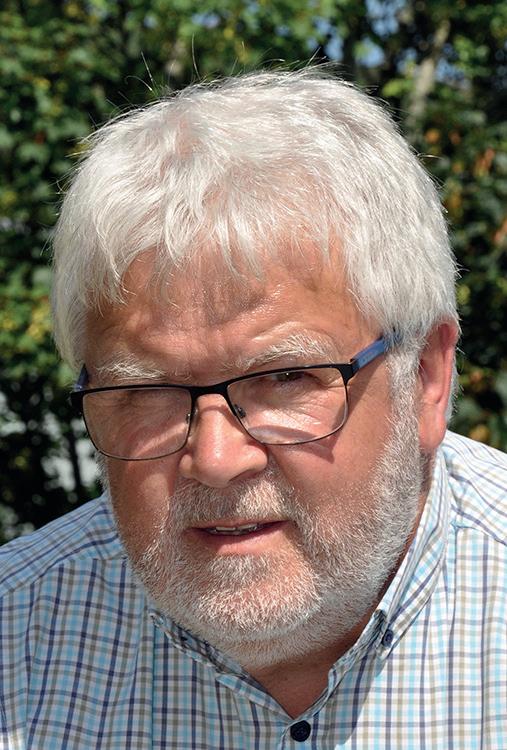
heavier and of poorer quality, which was not ideal for dairy diets.
“Other than that, just because we had generally kind weather for making silage in Scotland in 2022, we cannot assume the same will happen this year.

“To preserve silage with a quality fermentation, use a joined-up approach combining good in-field and harvest management, good ensiling practices and a proven additive.
“By investing in producing good silage, it puts farms in a stronger position. Not only is home-produced silage a financially attractive feed, it is also highly sustainable.”
SPONSORED CONTENT
For more information on Volac’s Cut to Clamp initiative, visit cuttoclamp.com
29 APRIL 2023
Volac’s silage experts around the UK agree that if you were fortunate enough to escape last season relatively unscathed, there were still key lessons.
Peter Smith
Jason Short
Alan Smith
Ken Stroud
Monitoring grass boosts production
Monitoring grass quantity has become a more commonplace and valuable management aid on dairy farms in recent years, providing a better understanding of grass covers and dry matter (DM) production to improve decision-making.
Isabelle England, ruminant nutritionist at Trouw Nutrition, says applying the same discipline to monitoring grass quality is the next stage in optimising production from grass.
She says: “Grass is an incredibly variable crop with quality affected by a range of factors, most notably the weather and growth stage.
“As farmers cannot control some of the biggest contributing factors, having a better picture of grass quality will help improve production from grazing, ensure supplementation is cost-effective and improve silage production.”
She says that changing seasonal weather patterns mean grass quantity and quality are less predictable (see graph below).
Ms England says: “What stands
out are the different graph shapes; 2021 saw a slower start to grass growth than 2022 before achieving a higher, but delayed peak. The last year saw an earlier peak but then the dry summer saw growth fall away.
“Based on estimating intakes from handfuls of grass submitted and other parameters, such as spoilage, hours at grass and quality of the grass on offer, we are able to calculate the potential milk from grazing.”
Patterns
Potential production followed a different pattern, with early season milk yields better in 2021, despite the slower growth, and even worse in 2022, even though more grass was available.
The key message is that just because grass growth is good, does not mean quality will follow.
Ms England says: “In early 2022, grass had continued to grow throughout winter and grass quality was reduced, due to increases in total undigestible fibre, which comes with a more mature plant.
“This had a negative effect on energy levels and digestibility, which
Average GB grass growth rate
negatively impacted intakes, ultimately reducing milk production.”
She says that 2022 was officially recorded as the eighth warmest winter on record. January 2023 was also warm on average, but with a very cold spell.
Ms England says: “Combined, these all have implications for early season grazing. Grass has continued to grow throughout winter, meaning there will be a proportion of higher fibre over-wintered grass with lower potential intakes and energy levels.
“Then as paddocks are grazed off, the quality of grazing and potential production should increase. But it is not possible to judge quality just by looking at the crop.”
Ms England advises taking regular samples for analysis throughout the season as a way to better estimate grazing quality.
She says: “As pasture becomes more mature, the quality can reduce due to a stemmier, more lignified plant. By having a better picture
of grass quality, you can ensure you do not over-estimate or under-estimate the contribution grazing can make and ensure supplementary feeds are adjusted to more precisely complement grass.”
The other area where quality testing is particularly valuable is pre-cut testing silage fields. Timing cutting based on data rather than ‘traditional’ cutting dates will help produce a better quality forage.

Factors
Ms England says: “Factors including sugar content, free nitrate levels and NDF content all have a bearing on how well crops will ferment and resultant silage quality. You have one chance per cut to get the cutting date as accurate as possible, so it really pays to test grass and results will be back on farm within 24 hours depending on the day of the week the sample is sent.”
Ms England says high sugars will encourage a rapid fall in pH, resulting in a more stable forage.
In addition, a higher sugar content will help produce a feed with a higher energy content.
A sugar content of more than 15% DM is excellent. Sugars with less than 10% DM increase the risk of a poor fermentation.
NDF is an important indicator of how well grass is growing, increasing as grass matures. If NDF increases too much, silage quality, particularly digestibility and ME content, could be reduced.
She advises cutting before NDF content exceeds 40% DM.
30 GRASS QUALITY APRIL 2023
6 7 8 9 10 11 12 13 14 15 16 17 18 19 20 21 22 23 24 25 26 27 28 29 30 31 32 33 34 35 36 37 38 39 40 41 100 80 60 40 20 0 Week kg of dry matter/hectare/day SOURCE : Trouw Nutrition Grasswatch GB average 2022 GB average 2021 GB average 2020 GB six-year average
Timing cutting based on data rather than ‘traditional’ cutting dates will help produce a better quality forage.
Brought to you by:







CREATED BY FARMERS, FOR FARMERS



OUR STEERING BOARD COMMITTEE
Future Farming Expo is driven, designed and built for Scottish farmers based upon their need for knowledge on how to have a successful and sustainable future for their businesses.




BRUCE IRVINE
Bruce farms near New Aberdour, on the Buchan coast, and runs an organic mixed unit on 250 hectares (650 acres) of droughtprone sand and gravel land.

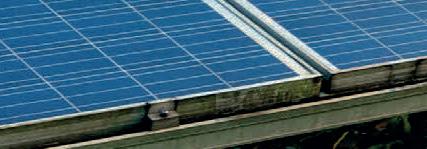

Our Steering Board committee members have been involved from the very start of the process by sharing their experiences, opinions and views of the challenges and opportunities their businesses have encountered.

DAVID CRUICKSHANK
David farms at Logie Newton, Huntly, in partnership with his mother and daughter. The farm is mainly arable, with 200ha (500 acres) of crops.

Mackintosh Farms won the Royal Northern Agricultural Society Good Farming Practice Award last year.


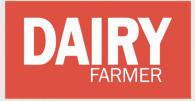

Janelle is a director of The Royal Northern Agricultural Society, having been society president in 2017.

Peter Cook heads the Food, Drink, and Agriculture team within the private sector-led and funded economic development body, Opportunity North East (ONE).





Hugh farms south of Aberdeen, near Stonehaven and runs a mixed unit in a family partnership with his mother, sister and son.

John is currently vice-chair of the Scottish Association of Young Farmer’s Clubs (SAYFC) Agri and Rural Affairs Committee.

2023
Find out more at www.futurefarmingexpo.com
FRASER MACKINTOSH
JOHN MCCULLOCH
HUGH GORDON
JANELLE ANDERSON
10-11 OCTOBER 2023
PETER COOK
P&J LIVE, ABERDEEN
New herbicides, varieties and management thinking are underpinning a clover revival among producers keen to cut back on bought-in fertilisers and get the most out of their grassland. Dairy Farmer reports.
Modern clover varieties producing more than
£1,000
worth of nitrogen per hectare

Modern clover varieties as part of a properly specied and managed grass ley are now capable of delivering a return on investment (ROI) of 50:1, says Jim Juby, of Horizon Seeds.

He says: “In the current economic climate, there are very few reasons why grass mixes should not contain an element of clover. ey add relatively li le to the cost of a reseed, yet will deliver signi cant
bene ts over the life of the ley. A top-notch grass mix containing some of the latest varieties of red and white clover can easily put the equivalent of 120kg nitrogen [N]/ hectare into the soil consistently over a ve- to six-year period.
“ is means they could contribute more then £1,000 N/ha over a typical ve-year period, which is a pre y impressive return on an initial investment for £20/ha for the additional cost of the clover seed.”
And as well as boosting yields,
Mr Juby says the addition of clover will also raise the quality of the grass produced, particularly with regard to crude protein, and help condition soils as result of its extensive roots –especially if white clover is used.
He says: “In most systems, the need for bought-in fertilisers can be completely negated, especially if farmyard manure and other organic sources are used in addition. You might need 100kg N/ha of bagged N to kickstart a reseed, but a er that, clover will do the rest.”
Understanding the di erence between the two main types of clover – red and white – can do much to ensure growers select the right type for their system, he says.
“Red clover is a high-protein legume crop, providing highly digestible forage producing high yields, particularly when grown with companion ryegrasses.
“It has an upright growth habit and a strong, deep taproot and is typically higher yielding than white. Historically, it has been much less persistent than white and, as a result, is best suited to cu ing leys.
“White clover, by contrast, has a


multi-branched creeping stem [stolon], which provides sites for new leaves, roots and owers.
“ e stolon stores carbohydrates and proteins, giving the plant the ability to over-winter and regenerate when grazed.
“Both can produce the equivalent of 100-200kg N/ha per year.”
Red clover is be er suited to applications where silage cuts will be taken and white clover is the be er option for grazing, he says.
Seed rate
“Red clover can be drilled at a seed rate of 7.5kg/ha and form 50% of the sward at cu ing. e higher the inclusion rate, the more care you will need to take care with ensiling due to the high moisture content.
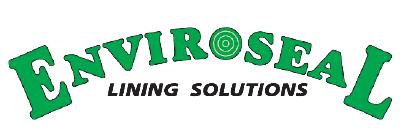
“Cu ing should be avoided in the establishment year, but a er that, up to four cuts for conservation can be taken in late May or early June, a er bud development, or two cuts followed by rotational grazing.
“It is important to avoid cu ing too low and ensiling should take place at 25-30% dry ma er to minimise wilting losses. A good additive
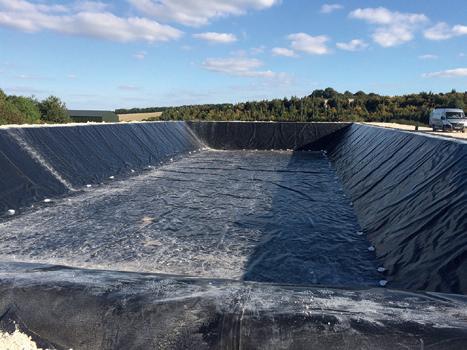

32 CLOVER APRIL 2023 YOUR DEPENDABLE PARTNER FOR SLURRY STORAGE SOLUTIONS enquiries@enviroseal.co.uk t: 01695 228626 www.enviroseal.co.uk SLURRY LAGOON FLOATING COVERS Keeps rainwater out of slurry Reduces odour from lagoons Covers comply with EA and SSAFO legislation SLURRY LAGOON LINERS Comprehensive 25 year warranty Materials meet EA and SEPA requirements Installed and tested by certified technicians Enviroseal provide a complete range of products for slurry storage
[White clover] is lower growing than red clover, which makes it a good weed suppressant
JIM JUBY
is important too. But the end result is silage with a very high protein content which can go a long way to reducing the need for bought-in feeds, such as soya.”
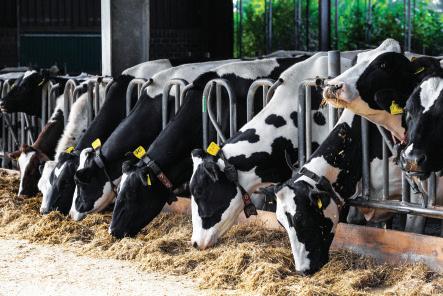
For grazing, Mr Juby advises going for a white clover, sown at 3kg/ha (1.2kg/acre) to give an inclusion rate of about 20% by weight.
But he adds that regardless of clover type chosen, weed control is o en a stumbling block for many producers. However, he says the advent of clover-friendly herbicides has helped to eradicate this.
“Products containing 2,4 DB and MCPA o er broad spectrum control of perennial and broad-


























































































































Additional benefits
JAn added advantage of clover in a mix is that it can also keep grassland rusts at bay, Mr Juby says.
“In systems relying on applications of nitrogen [N] made mainly in spring, N can run out towards autumn and this can result in rusts forming, particularly in more vulnerable varieties.


“Clover will put N in the ground throughout the year and gives a vital tail-end boost to stop rust developing at the end of the season, which can reduce intakes as livestock find grass affected in this way fairly unpalatable.”


Clovers are also becoming increasingly popular

leaved weeds in grass and clover mixes without a ecting the clover as long as manufacturer’s guide-

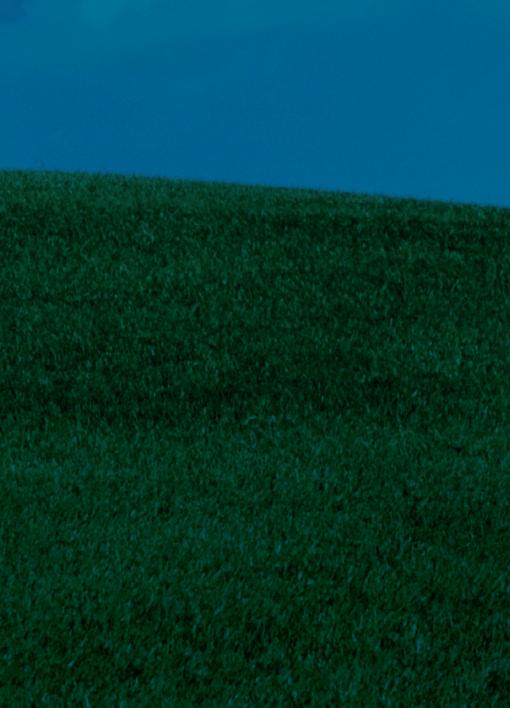



constituents of multi-species and herbal leys, says Mr Juby.
“Red clover is widely used in herbal ley mixtures and, as well as being able to fix N, adds to feed quality with its flowers providing a great source of nectar for beneficial insects, such as bees.

“While white clover also fixes N making it a good protein source, it is lower growing than red clover, which also makes it a good weed suppressant, especially while the ley is establishing.
“Alsike clover is less well known, but it is highly palatable and has the ability to grow on more acid soil situations, unlike many other clover species.”
lines are followed. is means that grass and clover can now be drilled together and weeds controlled at

33 CLOVER APRIL 2023
Red clover is better suited to applications where silage cuts will be taken, says Jim Juby.
CLOVER
all stages from newly seeded leys to established ones which e ectively removes one of the main barriers to wider adoption of clover.”
New varieties of clover also add a degree of vigour and persistence in the sward that older varieties cannot match, he says.
“Aber Claret red clover has shown exceptional persistence in trials giving high production for more than ve years, which is a signi cant step forward in the three- to four-year reseeding interval of older varieties.

“If you have had a bad experience with sclerotinia when using clover in the past, the newer more aggressive varieties can also help.




“Triumph two-year red clover ley, for example, contains 25% of Merviot red clover, which shows very good resistance to sclerotinia and virtually eliminates the problem.”
But whatever clover is being used, Mr Juby says it is important to have good grass varieties in the mix which can make full use of the N created.
He says: “Ryegrass is particularly responsive to N, so this is always a good choice as a key part of the mix.
“A modern perennial ryegrass will give a 50% be er response to N than something like Yorkshire Fog or most of the other weed grasses which thrive when reseeding is de-




layed or swards are damaged.
“If you do not address your grassland issues when needed, you will e ectively be wasting half the N you apply and that is a cost few
businesses can live with in the present circumstances.”
If bloat ever becomes a problem when feeding high levels of clover, the solution is simple, Mr Juby adds.
“ e addition of cooking oil into the water trough is an e ective and easy way to prevent bloat in the herd, as it acts as an anti-bloating agent.”
34
APRIL 2023
The addition of clover will raise the quality of the grass produced.
Jim Juby says new varieties of clover add a degree of vigour and persistence in the sward that older varieties cannot match.

TRANSFORM HOW YOU FEED YOUR HERD With Feedlync’s weigh system & feeding app you can: > Quickly & easily analyse your feed accuracy > Instantly save money by reducing feed waste > Access your data instantly from your mobile anywhere, anytime > Integrate with your processor, herd management, nutritionist and more! Speak to our friendly team today to find out more! Call +44 20 3966 90 63 or visit www.feedlync.com
Formulate buffer feed to exploit value of grazing G
e ing the most from grazing will be a priority this spring, so while it will be important to ensure cows are given every opportunity to maximise grass intakes and utilise it e ectively, it also means a ention needs to be paid to the formulation and delivery of bu er feeds.
Georgina Chapman, of ED&F Man, says intakes will be in uenced by grass quality, so it is important to feed grass at the most nutritious three-leaf stage and avoid overmature grass which can be more of an issue as the season progresses.
Feed value
But, she adds, very early-season grass can also have a lower feed value.
“Sugar and protein contents typically only begin to peak from late April onwards, while bre can be higher if the sward contains overwintered material that has the potential to depress intakes.”
According to Grasswatch, grazing in early April last year was only worth between maintenance+5 to maintenance+10 litres depending on the region.
“Grazing activity is also a key factor in determining grazing intakes. e amount of time cows spend grazing, and therefore their intakes, increase as the number of daylight hours extend. All these factors in uence how the formulation of bu er feeds is optimised, particularly in early season.”
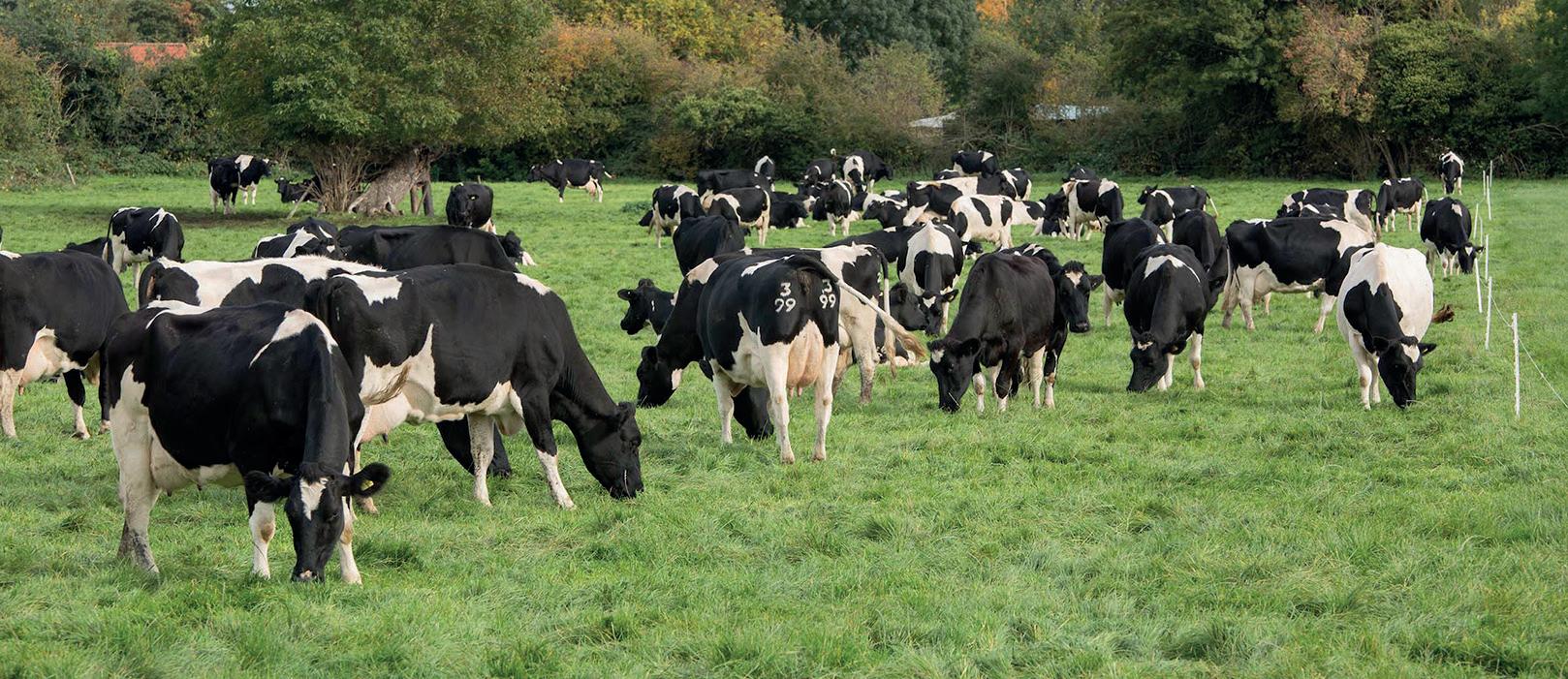
Ms Chapman says the role of bu er feeds is to complement grazed grass and balance nutrient supply without compromising grazing intakes.
Anything that displaces grazing from the total diet, whether
a bu er or compounds, has a negative e ect on margins.

A correctly formulated bu er can help improve grass utilisation by stimulating the rumen microbes to digest feed more e ciently. She adds that silages normally form the basis of bu er feeds but is concerned that forage shortages may mean this is not possible this year.
“We have already seen herds turned out earlier than usual to conserve forage stocks, so it is important to look at possible alternatives to provide a nutritional balance and meet the various objectives of a bu er feed.”
She advises that in the rst part of the grazing season, cows
on high-quality spring grass will be consuming high quantities of low- bre, highly degradable protein and high-sugar forage, which pass through cows quickly.
“At this stage, the bu er should contain a source of bre to help slow down the rumen and optimise grass digestion with the aim of maximising nutrient uptake.
“It will also need to contain a supply of bypass protein to balance the rapidly degraded protein in the grass.
“Typically, this would be oilseed rape or soyabean, but with both these ingredients trading at high prices, it will be essential to ensure they are included at the levels needed to meet the cows’ requirements, yet without increasing costs.”
Silage replacement
Research carried out at Kingshay shows a proportion of silage can be replaced in a bu er feed with a mix of straw and blended molasses to extend forage stocks, and Ms Chapman says this could be a useful option this spring.
Straw can provide the bre needed to optimise rumen ow rates and help improve bu erfats, which will help maintain milk price.
e molasses in the blend is rich in six carbon sugars such as sucrose and glucose, which are proven to be bene cial to cows as they are more highly fermentable in the rumen, increase microbial protein production and stimulate rumen microbes to improve bre digestion.
Promoting faster and more e cient fermentation will also stimulate dry ma er intakes.
Fine-tuning
“As grazing quality changes during the season, it will be possible to ne tune the balance of ingredients in the bu er to maintain high levels of grazing utilisation and margins.”
She says the way bu er feed is managed can also have an impact on grazing intakes. She advises feeding bu er feed at a ernoon milking, explaining that feeding at this time has less of an impact on total grazing hours and therefore grass intakes.
“Finally, watch out for bu er feed heating up. In hot weather, avoid mixing the bu er early in the day and leaving it, as this will allow it to heat up and depress intakes. Mix as late as possible prior to feeding and consider adding a ration conditioner.”
36 NUTRITION APRIL 2023
A correctly formulated buffer can help improve grass utilisation by stimulating the rumen microbes
GEORGINA CHAPMAN
It is important to feed grass at the most nutritious three-leaf stage, says Georgina Chapman.
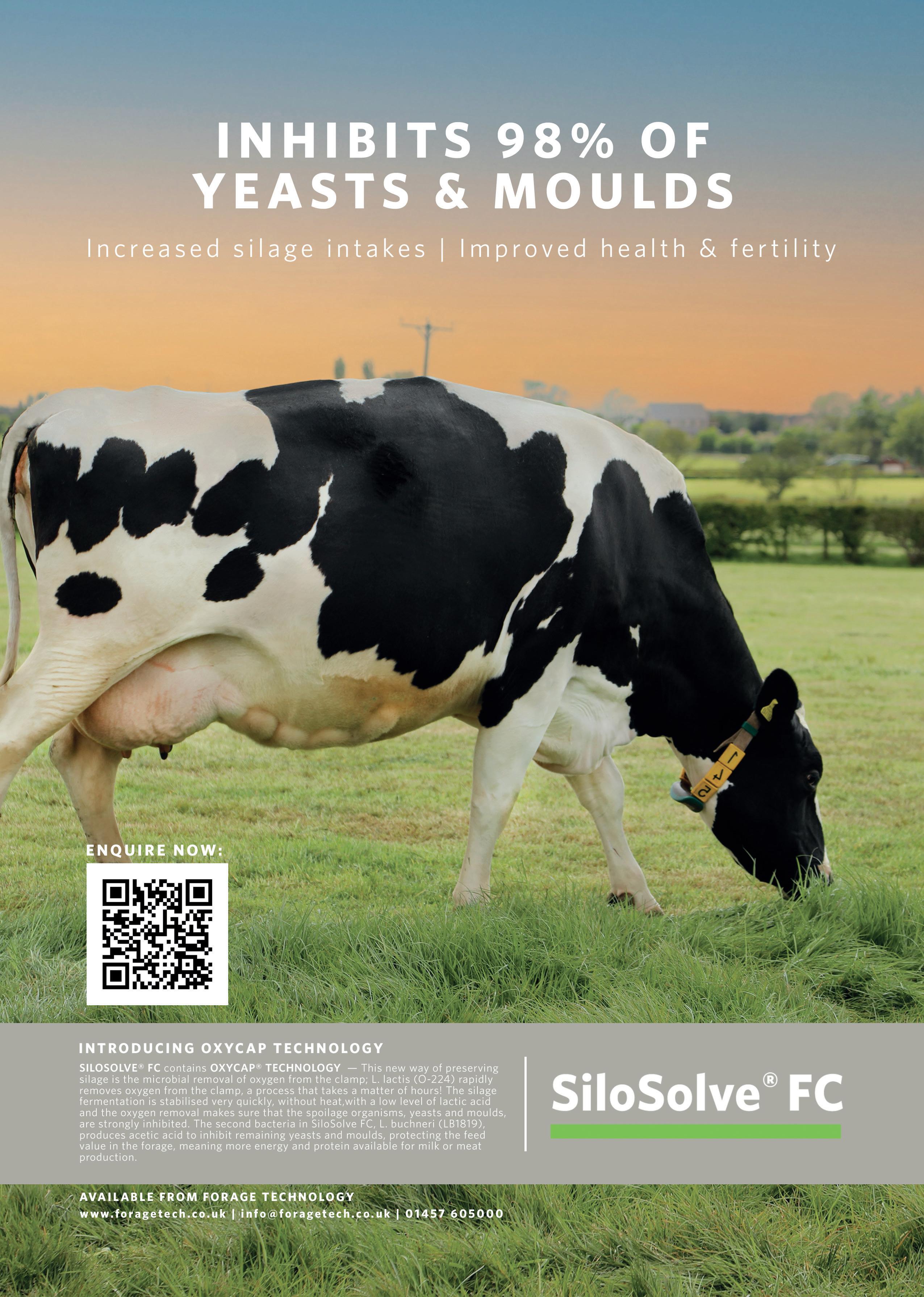
On February 27, the dairy industry lost one of its most ardent supporters and arguably its most vocal spokesman. Following the death of Ian Potter, Dairy Farmer pays tribute.

Ian Potter 1960-2023
Described as a ‘dairy industry giant’, Ian Po er had been at the forefront of the dairy industry for more than three decades as a well-known commentator, quota broker and also a farmer.
Ian, who wrote a column in Dairy Farmer from 1991 until 2021, was known for his forthright opinions, his ability to provoke debate, but above all for his knowledge of, and dedication to, the dairy industry.

Born in May 1960, Ian was the son of an East Yorkshire farmer. He studied at Cirencester, before becoming a chartered surveyor and auctioneer with Bagshaws.
In 1988 he set up a business which specialised in the sale of quota. e company, which operated for almost 20 years, became the best known broker in Europe.
It was during this time that he started writing his regular column for DF, in which he would prod and probe the industry and all those who worked within it.
While not everyone would say they agreed with Ian all of the time, what was apparent was his desire to stand up for dairy farmers and
JIn his final column for Dairy Farmer in May 2021, Ian promised readers he would ‘continue to breathe down the neck and look over the shoulders of those who do not play ball’. And he continued to do just that through his own weekly news summary, which provided
for an industry he obviously cared so passionately about.
Katie Jones, editor of DF, said: “Ian was an extremely wellregarded commentator, his contacts were enviable and his passion for the industry was evident in everything he wrote and everything he did.”
In recent years, Ian’s business
its readers with an insight into the industry and the very latest on milk price news.
diversi ed into o ering call centre, back o ce administration and telephone-answering services for a range of agricultural businesses, including the National Fallen Stock Company (NFSCo).
e company’s work includes managing about 16,000 direct debits each month, as well as collecting money directly from invoiced customers.
Ian’s services to dairy farming were recognised in 2010 when he was presented with the prestigious Princess Royal Award by the Royal Association of British Dairy Farmers ( BDF).
Speaking following his sudden passing due to medical complications a er a short illness, BDF chair Di Wastenage said: “Ian has been synonymous with the dairy industry for as long as I can remember and was a massive asset. He loved what he did and the industry he worked in and his passing will leave an enormous void in the sector.
“Over the past three decades,


he has kept us updated on market conditions with his weekly bulletins or comment pieces in farming publications, building respect across the industry and beyond. His voice and presence in the dairy industry will be missed by all.”
NFU dairy board chair Michael Oakes said: “Ian was a wellrespected gure as a journalist and industry commentator and a great advocate for the UK dairy sector.
“Although we did not always see eye to eye, I know he worked tirelessly and passionately to highlight the issues facing British dairy farmers.”
In a statement released by his wife Carole and three children –Harrie , Jack and Lydia – the family described Ian as a ‘giant of the dairy industry’ who would be missed, not only by them, but by his ‘countless friends and colleagues’.
e family added: “ roughout his career, he had the interests of dairy farmers at heart and loved what he did and the industry he worked in.”
rA celebration of the life of Ian Potter and his contribution to the dairy industry and NFSCo will be held on March 29 at the Staffordshire Showground. For more details and to register attendance visit ipmsltd.co.uk
38 TRIBUTE APRIL 2023
Ian has been synonymous with the dairy industry for as long as I can remember and was a massive asset
DI WASTENAGE
Dairy Farmer contributor
POSITIVELY IMPACT CALF HEALTH AND GROWTH BEFORE SHE’S BORN
ReaShure XC precision release choline delivers benefits to transition dairy cows and their calves



With genomic testing and advanced reproductive technologies, dairy producers are increasingly seeing the potential for impacting calf health and future milk production, before the calf is even born.
“Calves are the future of every operation, and research is showing a strong link between prenatal choline supplementation and calf performance,” explains Anna Dinsdale, AB Vista ruminant technical manager.
In dairy cows, rumen protected choline (RPC) has long been known as an essential nutrient, enabling transition cows to better utilise the non esterified fatty acids (NEFA) mobilised from body stores, to meet extra maintenance and production demands, rather than letting fat accumulate in the liver.



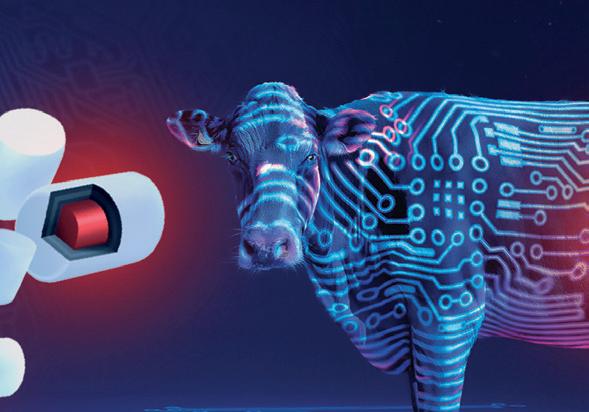
“With extra body fat mobilisation inevitable for a cow on the steep incline to peak lactation as she tries to close the gap between her energy output vs input, using a rumen protected choline (RPC) source helps the liver to metabolise and export the extra fatty acids out of the liver for use in milk production or tissue repair,” explains Ms Dinsdale.
BENEFIT TO UNBORN CALF
However, a growing body of research is also highlighting the benefits in improved calf health and growth from those calves exposed to choline in-utero.
Recent research from the University of Florida, for example, shows the benefit of feeding the concentrated form of RPC, ReaShure XC, during the close-up dry period, to the unborn calf.
“Not only are we interested in the benefits to the milkers, but we are also keen to investigate the additional benefits in the calves born to ReaShure XC supplemented mothers” continues



VALUE OF A HEAVIER HEIFER AT FIRST CALVING
Ms Dinsdale.




“The recent work from the University of Florida is particularly interesting as this follows calf performance through to first lactation.”
Calves born from cows fed ReaShure XC 21 days pre-partum were born lighter, improving calving ease but had a higher average daily gain (ADG), meaning they were 13kgs heavier at 12 months of age and 36kg heavier post-calving (Zenobi et al 2018).
“The di erence in early daily weight gain can be attributed to both the e ects on calf development in-utero and the improved colostrum quality from the cows fed ReaShure XC; increasing
dry matter intake and enabling the calf to fight immune challenges more e ectively,” says Ms Dinsdale.
“The growth and health benefits resulted in heifer calves from cows fed ReaShure XC having a higher milk yield in their first lactation averaging 2.2litres/ day/head more than control,” she adds.
ReaShure-XC has been proven in over 25 peer-reviewed published research trials and these benefits have been demonstrated in the field for many years.
















■ Contact our friendly team at AB Vista to discover more abvista.com




FOR MORE INFORMATION CALL 07395 248 963
Why settle for less? Protect your herd with the highest concentrated Choline this spring
ADVERTORIAL
Additional Body weight at first calving Amount of additional milk/year Milk price pence per litre Additional milk income/year from 1st lactation animals (35) 100 cow herd x 35% heifers = 35 heifers 36 kg2 455 kg 34.12 ppl3 £ 5,433.61 29.31 ppl4 £ 4,667,62
Milk price €/kg: 3 December 2021 UK Average Milk Price (AHDB) 4 GB 5-Year Average Milk Price (AHDB)
1 Staley, Gavin. “Why Heifer Maturity Matters: The Peter Pan Problem.” Progressive Dairy. 11 March 2020, 53-55. 2 Zenobi, et al. / Dairy Sci. 101:1088-1110 (2018).
“Feeding
ReaShure-XC during transition can lead to substantial returns on investment” says Ms Dinsdale. “We can place a value on increased ADG and body weight at first calving, with an additional £6370 to £7166.25 income per year at a milk price of 40 ppl to 45ppl.”
Could a unique parlour design which sees the electrics all housed in a cellar to protect it from daily wear and tear lead to greater equipment longevity? Dairy Farmer reports.

Subterranean parlour has long life potential
Stephen Kirkup farms in partnership with his father John and brother Robert, near Darlington, Co Durham, milking 480 Holsteins through a DeLaval, Blue Diamond 40/40 rapid exit parlour. e parlour is a rare concept, featuring a cellar to house the
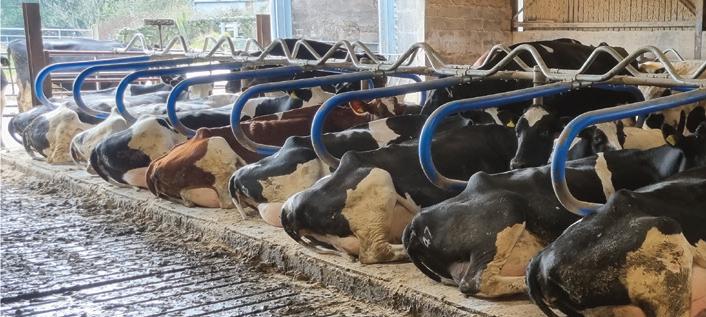

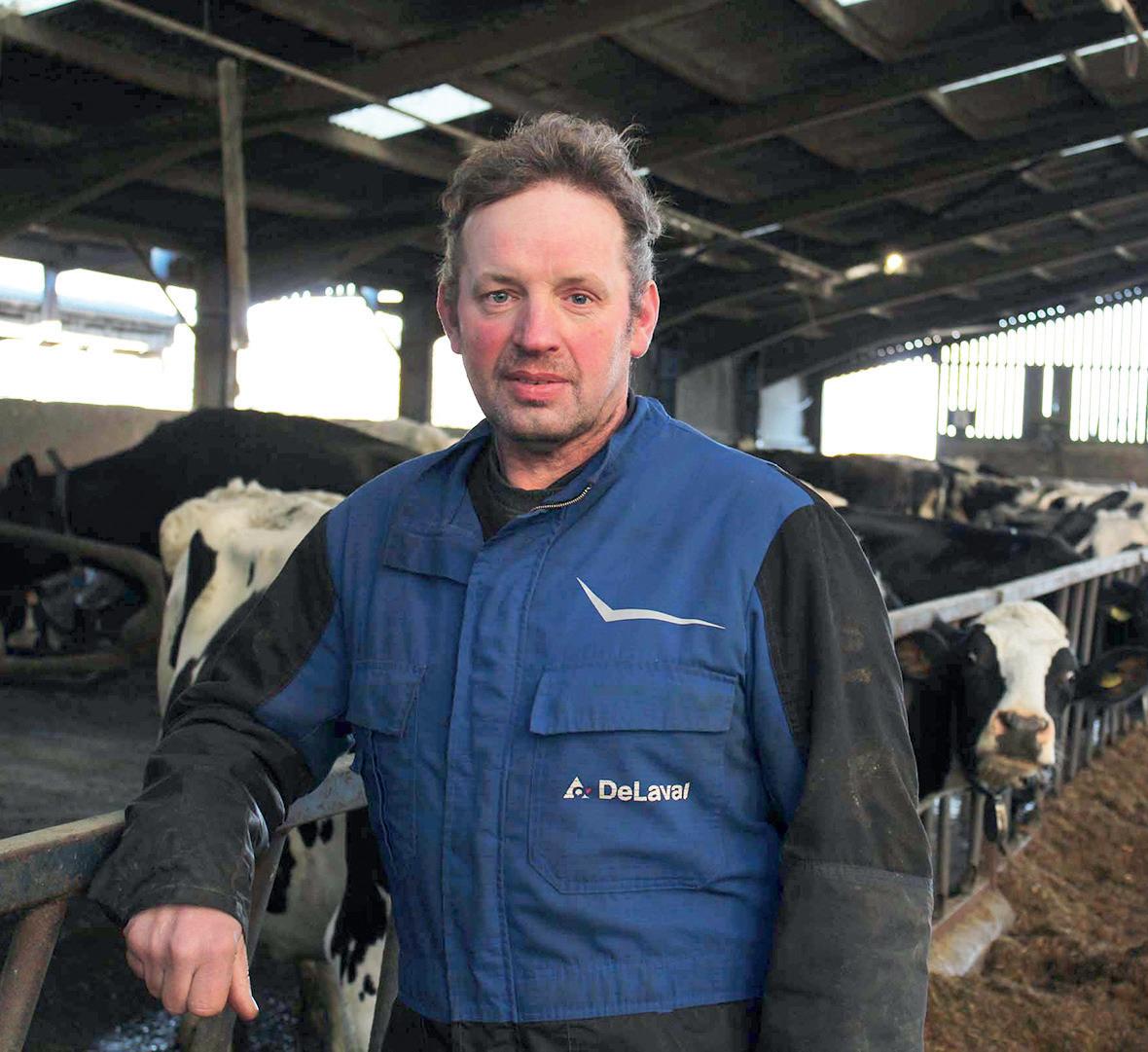
electrics, milk meters, pulsation, receivers and air wash equipment. is, and the sturdy stainless steel construction of the parlour, has seen it work tirelessly for 18 years, with Stephen sure that it will last at least the same again. He says: “We lost the herd to foot-and-mouth, but restocked
to 240 by 2002. e 16/16 herringbone parlour we used then was in need of an update.

“And having travelled to both UK and American dairy farms to see di erent options, I wanted to replicate a system which bene ted from a cellar to protect equipment from the day-to-day wear of milking.”


By 2005, the herd had grown to 300 and the decision to install the rapid exit was clear cut.





e family was ready to invest and had ambition to grow the herd substantially. e 40/40 o ered the space and build quality to realise this while keeping labour costs to a minimum.



“Today we milk 420 twice a day, but at one stage we were hoping to have near double that number.

“Milk prices made that growth

di cult and at one point we moved to three times a day but it was not sustainable.
“We only employ two farm workers and average 8,000 litres per cow per year.
“When we milked three times a day we were averaging more than 10,000 litres, but it was not worth the extra labour time.”
e herd is housed all year and the sheds are arranged to enable milkers to access a wide collecting
40 PARLOUR POTENTIAL APRIL 2023
HYBRID FLEX CUBICLES MATTRESS A New Standard In Cubicle Bed Comfort 01704 821717 | www.mayofarmsystems.co.uk
GRANT ALERT! Huge Selection of Qualifying Products Available GET IN TOUCH WITH AN EXPERT ABOUT YOUR APPLICATION TODAY Scan Me
Stephen Kirkup and his family milk 420 Holsteins.
FETF
yard with a backing gate that e ciently pushes cows up.
Two people can milk 420 cows in three-and-a-half hours through the parlour and the pit is light and spacious which helps to assess udder and overall cow health while milking.
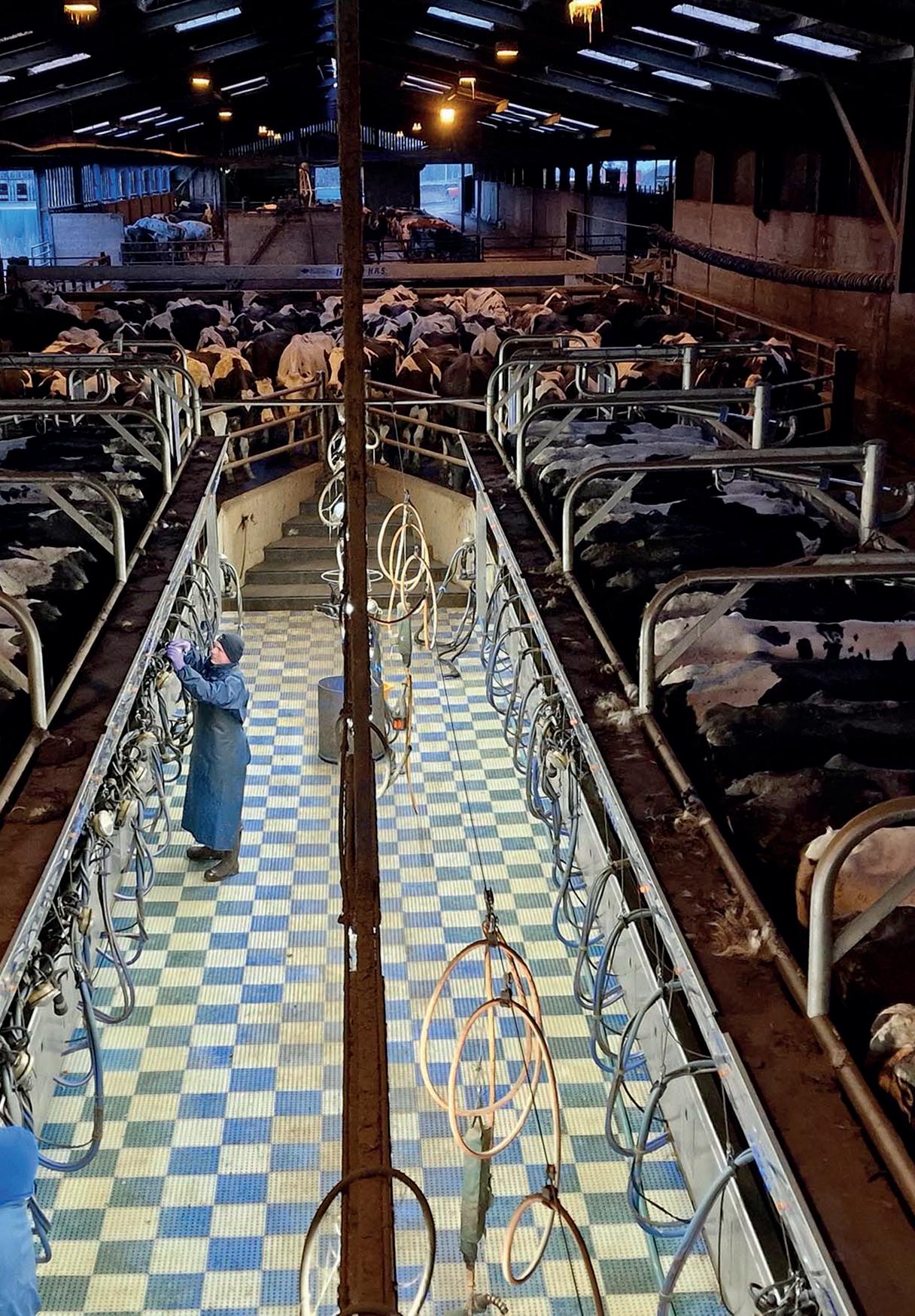
Stephen says: “ e 40-foot backing gate makes dra ing the cows quick and e cient for one person.
“ is keeps labour time and costs down and while it was a £20,000
investment when the parlour was installed, it has been worth every penny.”
Milking time is setup has halved milking time compared to the previous herringbone and enabled the family to grow the herd and improve the overall farm system.
Today, pressures to extend slurry storage and contracting costs have demonstrated that the investment almost 20 years ago is paying o well.
“ e parlour is paid for and costs relatively li le to service and maintain, because the wearing parts are protected in the cellar.

“We expect to see at least 20 more years of milking in this parlour and that is giving us the con dence to invest in other areas of the farm.”
Stephen is hoping to bene t from grants for slurry storage.
To store two million gallons of slurry, he anticipates a signi cant investment, which would be more challenging if the farm was still paying o a parlour.
“A new slurry tower is a heavy
Fusion Dairy Feeds Sustainable High Performing Feed
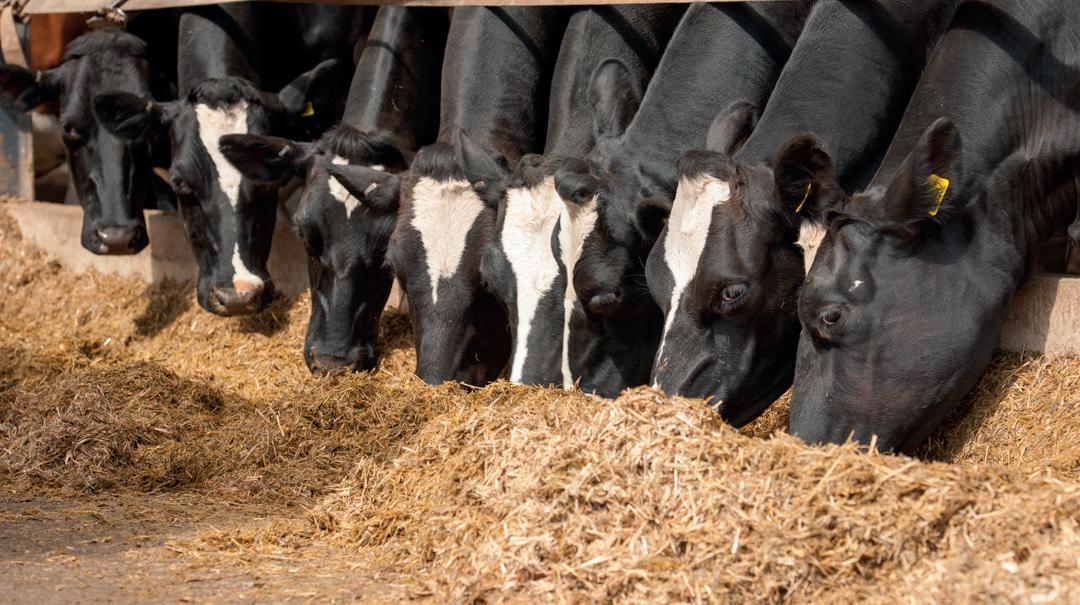
• The Fusion range features a high fibre, a starchy and a high protected product diets, available in different proteins to suit a range of systems.
• Ultra Pro-R is a high-quality vegetable protein which, as a result of precise treatment of rapeseed meal, contains a high level of DUP.
• Ultra Starch-W, a protected wheat, aids rumen health to achieve feed utilisation, reducing the rate of ‘quick fizz’ in the rumen preventing a pH drop.
• Formulated utilising British and/or European grown raw materials helping to reduce agriculture’s carbon footprint, keeping raw material provenance in mind.

• Manufactured at NWF feed mills in Cheshire, Cumbria and Devon.
2787
Fusion Rearer Now Available

41 APRIL 2023
Get in touch for feed and expertise 0800 756
www.nwfagriculture.co.uk
The NWF Fusion Dairy feed range is free from soya, soya hulls and palm kernel. Efficient and cost-effective rations for early lactation and high yielding cows.
I wanted to replicate a system which benefited from a cellar to protect equipment from the day-to-day wear of milking
STEPHEN KIRKUP
A 40-foot wide backing gate is used to move the cows through the parlour efficiently.
PARLOUR POTENTIAL

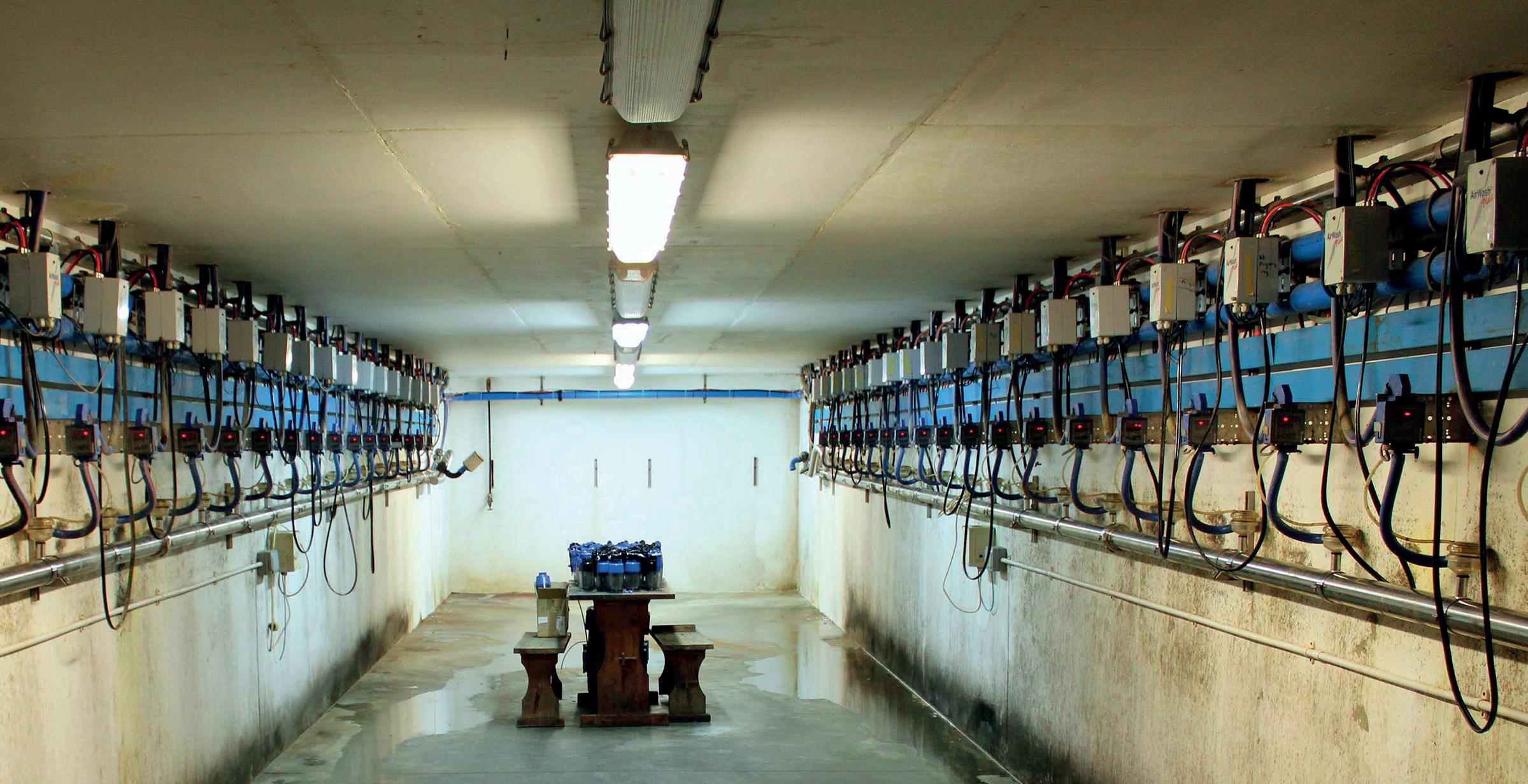
cost to bear and then there is the infrastructure and adaptations to the farm to consider.
“We hope these grants come soon, because we are ready to make the investment so long as we can see a signi cant contribution towards the cost.”
To further reduce costs the farm is zero grazing, which has reduced the reliance on silage contractors.
With 182 hectares (450 acres) of grassland there is ample opportunity to feed fresh grass.
However, fuel price rises and the cost of machinery have compounded to make zero grazing a questionable economy.
“We do not have fancy tractors and expensive zero grazing kit, because most of it would be too wide for our sheds, preventing us from being able to feed out quickly.
“Instead, we have a wagon with a detachable side mower that we can leave in the eld. It was the brainchild of Ed Walley from Cheshire.
Farm facts
r304 hectares (750 acres), which includes 182ha (450 acres) of grassland and 121ha (300 acres) of cereals

r420 cows milked twice a day averaging 8,000 litres

rGrass zero-grazed

“It is a simple machine and we have only had to replace the mowing parts which has made it relatively cheap to run.”

Evaluating the fuel cost of £350£450 per day and an annual labour cost of about £50,000 has caused Stephen to reconsider.
However, with contractor costs also increasing, the farm is set to continue zero grazing, which also o ers the bene t of fresh grass which is more palatable for the herd and enables the farm to make more milk from grass. e farm will continue to assess and weigh up the bene ts to decide whether to invest in more zero grazing equipment.
Stephen says: “ e land is spread over four farms that we have taken on over the years.

“We total 304ha, choosing to use 121ha to grow cereal crops which are sold as a second income for the farm.
Replacements
“Being so spread out may not suit us in the future as we have chosen to stop rearing our own replacements and so may not need so much grass.”
In 2020, when milk prices plummeted due to the Covid-19 pandemic, the farm was forced to sell heifers to generate income.

Eventually everything above ve

months was sold o to make way for a new strategy of buying replacements.
“We have bought from France, Denmark and Ireland, because availability was be er at the time and the costs were comparable. We need to buy 140 heifers a year as replacements at close to £2,000 a head.
“However, the cost of rearing our own is similar as there are many hidden costs, especially labour.
“Our parents have looked a er youngstock in recent years and when they retire the labour cost will make rearing replacements more complicated and expensive.”
He says he intends to buy locally in the future to improve cash ow
42
APRIL 2023
Key to the parlour’s longevity is the underground area which houses the electrics, milk meters, pulsation, receivers and air wash equipment.
Two milkers can milk 420 cows in three-and-a-half hours.
by introducing cows monthly rather than buying larger numbers from abroad.

Free from the need to invest in a parlour for many years to come, he can con dently focus on the herd and select the best cows to incor-


porate. It also enables the family to potentially keep growing the herd without increasing labour costs.

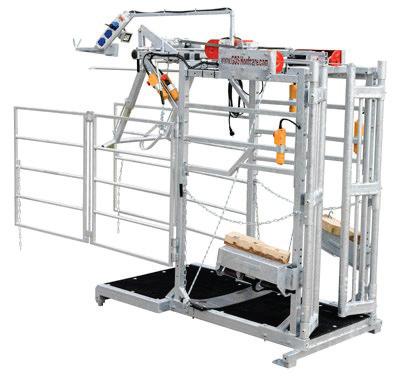




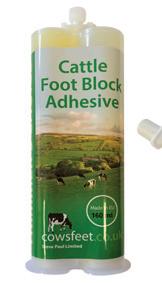



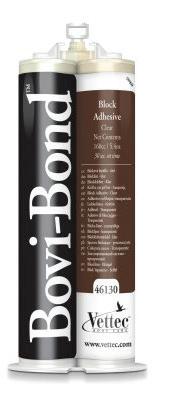
“Almost 20 years on from installing this parlour, we still have the same opportunity to scale the herd,

either up or down, as we please. By reducing the reliance on labour, protecting what we have and saving money for projects which could facilitate growth, like slurry storage, we are also managing risk.
“It is hard to see what lies ahead and so having a reliable parlour and an adaptable farming system with hand selected cows is how we believe we can approach whatever is thrown at us next.”
43 PARLOUR POTENTIAL APRIL 2023 Prefer to speak to a human? Give us a call on 01963 824448 "Thank you to Steve and his team for an excellent and very quick service and very competitive prices every time, thanks!” JOHNNY MILLER, LANCASHIRE LAMENESS WORKSHOPS October 22 £125 per person Steve Paul Limited The UK's leading cattle foot care company TRIMMING • TRAINING • SUPPLIES Free next working day UK mainland & Ireland delivery ORDER BY 3PM when you spend £100 online excluding VAT Make your life easier with our Electric Farmer Crush Do ring us if you’d like more information!
Cowsfeet advert Farmers Guardian 200x130mm March 2020.indd 1 14/02/2020 09:40
From farmer cattle crushes to wooden blocks, we have everything you need to keep your cows' feet healthy!
Almost 20 years on from installing this parlour, we still have the same opportunity to scale the herd, either up or down, as we please
STEPHEN KIRKUP
Narrow access to sheds has kept the farm working with older machinery which fits the space.
Producers should be more precise in the utilisation of data in their farm management practices, according to Prof Alex Bach, of the Catalan Institute for Research and Advanced Studies in Barcelona.

Speaking during an AHDBorganised webinar, Prof Bach also warned against using some performance averages for decision-making.
He said: “Data averages may be heavily in uenced by a small number of cows at the extremes of performance. Changing management factors in response to data averages, where the gures vary widely, will a ect all the cows and this approach is imprecise, in my opinion.
“My preferred option is to use the median, which separates the lowest 50% from the highest 50% of the values. is will allow for a more e ective decision-making policy on potential changes in feeding or fertility, for example.”
He also emphasised that data must be reliable, suggesting that weigh bands should be replaced by designated weighing equipment.
“It is claimed that weigh bands produce accurate results, but research suggests that they do not. ere can be as much as an 80kg variation between a weigh band estimate and gures taken from electronic weigh scales on animals weighing 400kg.
“An insemination programme based on inaccurate weights is likely to have a negative e ect on fertility. A producer who aims to serve heifers at 400kg may nd the actual animal’s weight is 380kg, or even 440kg. is could have a
Data management and the benefits of milking cow groups were among the subjects covered in an AHDB-organised webinar. Wendy Short reports.
Using data to make effective decisions
detrimental e ect on future performance that may last a lifetime.”
Some milk producers feed the same ration across the milking herd, but grouping animals according to stage of lactation can increase pro tability and improve cow health, he said.

“In an ideal world, each cow would be fed a diet which meets its speci c requirements. A cow giving 55kg/day will need 30kg of dry ma er [DM], while one giving 28kg will need only 22kg DM. is is a signi cant disparity and money will be wasted on feeding the low yielder to meet the demands of the high yielder.
“Furthermore, the low yielders will likely be overfed, leading to an increase in body condition and potential health and reproductive problems in the subsequent lactation.”
On some dairy units, the practice of forming milking cows into groups
was avoided, as producers feared that it would lead to a dip in production immediately a er each move between groups. However, Prof Bach was in favour of cow grouping as it was another way of targeting feed to production levels.
While he admi ed the slight risk of yield losses following each group move, he said it would help to increase the herd’s margin over feed performance – this should be the main focus, rather than placing too much emphasis on yield maximisation.
Nevertheless, the grouping system had to be correctly managed in order to boost farm pro tability, he added. Greater precision was also needed in dietary formulation and delivery, he said.
“Most nutritionists choose the level of milk production to formulate a diet which is calculated in a fairly arbitrary manner or by going
with their gut feeling. A good rule of thumb is to aim to meet the precise requirements of 70% of the milking herd.”

He also cited the advantages of feeding cows in the parlour.
He said: “In-parlour feeding is a vast improvement on the ‘one-sizets-all’ policy for feeding milking cows. We are close to reaching the limits of genetic advancement in yield potential, so our e orts should be turned to improving production e ciency.
“Flat-rate feeding may work for units in countries like the USA, where producers rely mainly on economies of scale and have access to a wide range of resources.
“In Europe, the opportunities for herd expansion are limited and margin enhancement must be derived from improvements in the return on investment gure, which means greater e ciency.”
44 FERTILITY APRIL 2023
Prof Alex Bach
PICTURE : Ruth Rees
Grouping cows according to stage of lactation can increase profitability and improve cow health.
Adopting the best system for the farm situation is the starting point when seeking to maximise grass silage quality. For many, this means cutting earlier and more often to ensure grass is cut when energy and protein levels are highest.
This is according to Volac’s Peter Smith, who points to on-farm research in Pembrokeshire which showed that improved quality from a multi-cut system meant it was cost-effective when taking account of extra costs for more cuts.
Mr Smith says: “The trial was conducted in a field divided into two plots, one cut five times and the other cut three times. Over the season, the multicut plot yielded an extra 0.38 tonnes of dry matter [DM] per acre.
“This additional yield alone would not cover the cost of two more cuts, but the increased energy value, equating to 7,520MJ, translated into a real benefit in potential added milk yield.
“The trial also showed DM losses halved where Ecosyl additive was used and there was evidence of better protein preservation. A trial on the same farm showed that if grass was tedded straight after cutting at 10am, 35% DM was reached within seven hours. If tedding was delayed, it took up to 24 hours to reach 32% DM. If grass was not tedded, it did not reach the target DM.”
Choices
Starting with the highest quality grass seed mixture to suit the system is vital to producing the best silage. John Spence of Limagrain suggests longevity and cutting

Forage quality is key
system are two important considerations when selecting a grass mix.
He says: “Highest yielding grass varieties, such as Westerwolds and Italian ryegrasses, persist for the shortest time and are of a lower forage quality than the more durable perennial ryegrass varieties.
“The highest yielding cutting mixtures will usually last for two to three years and will predominantly comprise Italian and hybrid ryegrasses. In my opinion, there are few situations where Westerwolds ryegrass is appropriate, as breeding advances mean Italian ryegrass has similar yield potential with superior forage quality.”

“Tetraploids have a higher sugar content; the plants use nitrogen more efficiently and they have improved drought-tolerance due to a deeper rooting structure. They establish more rapidly because the seed is larger and can store more nutrients. Tetraploid varieties tend to have a higher energy yield under conservation management and grazing studies have shown them to be preferentially grazed over diploids.”
Limagrain carries out extensive trials of grass varieties used in its mixtures and, under identical conditions, there are marked differences in yield and forage quality, Mr Spence says. He says: “We have recorded 5% differences in protein

Top machinery tips for high-quality silage
● Inspect the pto shaft and guards and hydraulic hoses for wear and damage before hooking up

● Ensure mower blades and tedder tines are working properly and replace any broken or worn items


and sugar levels and 10% in digestible fibre between the best and worst performing Recommended List varieties.”

Levels
Philip Cosgrave, of Yara, says that understanding levels of key nutrients and minerals in grass prior to cutting can guide nutrient management decisions.
He says: “A comprehensive herbage analysis two to three weeks before cutting will provide detail on the levels of the main nutrients – phosphate and potash, but also sulphur, calcium and magnesium – required for plant growth.
“It is too late to apply nutrients to the soil close to cutting, but in some situations, a foliar fertiliser, such as Yara’s CropLift Pro, containing all the main nutrients, plus magnesium, zinc, copper, manganese, iron and molybdenum, will provide a valuable lift for grass growth.”

● Check the mower bed, curtains and guards have not been damaged and undertake any necessary repairs

● Replace any damaged conditioner tines and ensure the belt is not damaged or perished
A pre-ensiling analysis is important to identify nitrate and sugar levels in grass, Mr Cosgrave adds.
He says: “We would advise not cutting grass for silage if nitrate levels are above 0.15% and ideally levels should be less than 0.1%. Nitrate can act as a pH buffer during silage fermentation, resulting in a higher ultimate pH, leading to less stable and poorly preserved silage.
“Higher nitrate levels may occur if fertiliser is applied too late or, if there has been a cold spell, residual nitrate may not be used up by the plant. Occasionally it can be because sulphur levels are low, meaning an important enzyme in the plant cannot function, preventing the assimilation of the nitrate into amino acids and proteins.”


45 SPONSORED CONTENT APRIL 2023
out more about Campaign for Better Silage at FGinsight.com/ bettersilage, or scan the QR code
Find
Sponsored by
Attention to detail from start to finish when managing grassland and making silage is key to achieving the best quality forage.
Trials of grass varieties used in various mixtures show marked differences in yield and forage quality.
This animal health special looks at the latest calf health and lameness research and gives advice for producers aiming to tackle head on issues which arise around turnout.
Researchers presented their latest ndings on how to optimise early calf life and reduce lameness at the AHDB Dairy Roadshow, held at Duchy College.
So what were their key messages and how can producers put them into practice?
Calf housing
ere are various calf housing systems available, but which one is best for calves?

is was the research topic for Sophie Mahendran, vet and PhD researcher at the Royal Veterinary College, who looked at calf hutches, pair housing and group systems, and presented her ndings on what led to success in the various systems.
e prevalence of individual calf hutches has decreased due to their labour-intensive nature and regulations brought in by Red Tractor and some milk contracts, which stipulate calves should be housed in pairs or groups, said Ms Mahendran.
She said: “In 2010, about 60% of farmers were using calf hutches and it is now about one-third.”
However, Ms Mahendran said the siting of hutches was an important consideration if they were to be used successfully.
“Control of water and the environment is important in every calf housing system, but even more so with hutches.”
She said there were obvious health implications from water gathering around the bo om of, or in, hutches.
She said: “Calves get damp and cold and it is a big risk for disease, not only respiratory but also scours.
is means that drainage is key.”
Ms Mahendran also said it was important to consider the humidity and temperature within the hutches in summer and winter. She
Research to help optimise early life and prevent lameness

said: “ e maximum humidity I recorded in a hutch was 99.9%.
“Ventilation is not always great and condensation can gather on the roof, which then drips down onto the calves. Moisture is the enemy [when rearing calves].”
Ms Mahendran advised producers to consider providing shade other than just the hutch and she added that the maximum temperature she recorded inside a hutch was 38degC, which could cause heat stress.
She said: “Calves have their hutch and an outdoor run, but where is the shade? For black and white calves, the black hair can really heat up and absorb the heat.
“Providing shade in summer also acts as shelter in winter.”
Ms Mahendran said pair housing was bene cial for a number of reasons.
She said: “Ca le are social facilitators – they learn from each other. A lot of research has shown that pair or group housing can help feed intakes, improve growth rates and maintain growth over that weaning transition.”
Although prevalence of pair housing is lower than individual housing, Ms Mahendran said pair housing was on the rise, with about one-quarter of farms using this system.
“In terms of disease, I have found
no di erence between individual and pair housing. If a pair housing system is managed well, it does not have to mean an increase in disease.”
But Ms Mahendran said spo ing disease could be more di cult in pair or group situations.
“At the milk feeding stage, if calves are feeling ropey they do not jump up to feed or they do not nish their feed. It is much harder to monitor that in the pair or group housing.”
Ventilation is important in any system but particularly if group housing in a shed, said Ms Mahendran.
“A positive pressure ventilation tube is great; it blows fresh
46 APRIL 2023 ANIMAL HEALTH
50 LEPTO Forward plan for vaccination 54 WORMS Explore control strategies 56 NEOSPORA Mitigating the risks 58 CELL COUNTS Avoiding the annual spike 60 TRANSITION Managing the dry cow
Getting calves off to the best start and minimising lameness are two integral ways of improving herd efficiency. Ruth Wills reports.
Moisture is the ‘enemy’ in calf housing, so whatever the system it is important to consider ventilation.
New sown ley. Don’t delay the spray.
Leystar® is a broad spectrum herbicide designed for new sown leys.



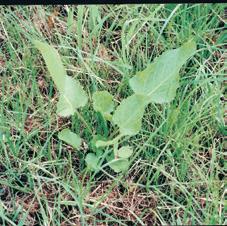

Give your leys the start they need by removing unwanted, competitive broad-leaved weeds. Leystar® is very safe to your grass and will give you the confidence that your new sown investment will deliver to its full potential.
Don’t delay, talk to your advisor or find out more at www.corteva.co.uk/forage


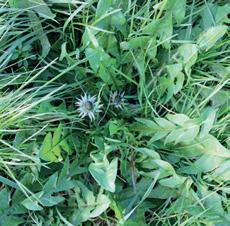

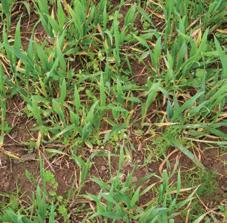

Mayweeds Seedling Docks
Thistles
Chickweed
Seedling
Dandelions USE PLANT PROTECTION PRODUCTS SAFELY. Always read the label and product information before use. For further information including warning phrases and symbols refer to label. Corteva Agriscience UK Limited, CPC2 Capital Park, Fulbourn, Cambridge CB21 5XE . Tel: 01462 457272. ®, ™ Trademarks of Corteva Agriscience and its affiliated companies. © 2023 Corteva. Leystar ® contains fluroxypyr, clopyralid and florasulam. Technical Hotline: 0800 689 8899 E-mail: ukhotline@corteva.com Free and easy to use, the Corteva Forage App is packed with information and tools to help you maximise your grass and maize crops. Forage knowledge on the go. go Download the Forage App now. Simply scan the QR code.
air in to help get rid of dust and bacteria.”
She also said gale breakers could be useful: “In summer, we need to get air in to cool calves down and in winter we need to keep the wind out.”
In terms of labour, group housing was the most e cient, said Ms Mahendran.
She said: “It is quicker to bed down and to feed, but it is potentially slower when checking calves for illness or disease.”
Ms Mahendran said the stockperson’s a itude had a huge bearing on the success of any system.
“ e system does not ma er as long as it is managed well. Having someone who is engaged in the process makes all the di erence,” she said.
Moisture
And she said moisture management was key.
“Whether that is moisture management on the oor or in the air, it is important to get the humidity under control.

“Buy a humidity data logger and stick it in the corner of the shed. Anything above 70% is a big risk factor for disease spread.”
For feeding, Ms Mahendran recommended automatic calf feeders. “In terms of the calf’s anatomy,
it is nice to get more smaller meals in. is is a bene t of an automatic calf feeder – as well as saving labour.
“But the teats must be kept clean. Take the teats o at least once a day, wash and disinfect them and then put another teat on. I have two or three in rotation.
“I also advise wiping the feeding station and ushing the lines through to stop bio lm from building up.”
Lameness
Research looking at e ective methods of treating lameness –trimming, blocks and anti-in ammatories – found a combination of all three reduced lameness, said Dr James Wilson, foot health consultant at Herd Health Consultancy.


But, he added, previous lameness could also have a huge impact.
He said: “We can a ribute more
than 75% of the risk of a single case of lameness to a previous case.”
Managing lameness pain in a young animal could have long-term bene ts, he said.
“Even early, mild stages of pain will change the way her neurons and nervous system interact with each other and she will be predisposed to pain for the rest of her life. Early
Top tips for reducing digital dermatitis
rBe hygienic by cleaning the environment and trimming equipment
rClean and disinfect feet every day throughout grazing and dry periods
rTreat lesions quickly
rSelect genetics for digital dermatitis-resistant cattle
rAnti-inflammatories have a big part to play in effective treatment
rHoof testers can identify problems early
detection and prompt e ective treatment means being critical when mobility scoring.”
He said this began with heifers. “Getting it wrong in the first lactation or before means always battling a problem.”
Ensuring foot trimming equipment was clean could help to stop the spread of digital dermatitis, according to Dr Nick Bell, director at Herd Health Consultancy.
He said research found the average time between initial signs of digital dermatitis and the full blown clinical lesion was 130 days. Dr Bell said: “So we are o en just controlling cows which are already infected. If we can get on top of removing reinfections, dealing with infected cows quickly and e ectively, we will see success.”
48 ANIMAL HEALTH APRIL 2023
Selecting genetics for digital dermatitis-resistant cattle were among tips for reducing instances.
We can attribute more than 75% of the risk of a single case of lameness to a previous case
DR JAMES WILSON
MAXIMISING RUMEN OUTPUT AND PRODUCER MARGINS AT GRASS
Following a relatively upbeat year for milk price, dairy producers are being urged to maximise the use of home-grown forages and grazed grass, to ease increasing pressures on producer margins.
“At first glance, it may appear that everything looked very rosy for dairy production in 2022 considering the strong milk prices seen across the board,” explains Anna Dinsdale, AB Vista ruminant technical manager.
A closer look reveals a number of pressure points experienced by all dairy producers. An extended dry summer saw both poorer than expected forage stocks in many areas as well as lower quality than in previous years. Meanwhile feed prices rose 42.5% compared to pre-Covid levels, and up over 30% between June 2022 and June 2021.
“Milk price reductions in the first half of 2023 have now helped push the milk:feed price ration down to 1.3, when a preference would be over 1.5, therefore producer margins are likely to come under more pressure,” says Ms Dinsdale.
IMPROVING EFFICIENCY OF MILK PRODUCTION
Feeding cows at grass therefore provides a welcome opportunity to reduce feed
DAIRY PRODUCER PRESSURE POINTS
+43% RISE IN FEED PRICES COMPARED WITH PRE-COVID LEVELS





BENEFITS OF BUFFERING AND CONDITIONING





ACIDBUF


+ Support the cow’s natural bu ering capacity with AcidBuf.

+ Maintain the rumen pH above 5.8 to reduce the risk of SARA.


VISTACELL











+ Get the rumen bacteria right by using Vistacell live yeast.

+ Rumen is conditioned to promote growth of fibre digesting bacteria due to the yeast’s natural ability to remove oxygen and helping to use up excess lactic acid.
costs. However, cows will face dietary changes around turnout, resulting in challenges that must be overcome to maintain and improve milk production.
Key areas to address when spring grass is introduced to the diet include balancing energy supply, maintaining optimal rumen pH (reducing risk of SARA), and reducing risk of falls in butterfat production.
Even the best quality swards grazed under good conditions will only realistically deliver maintenance plus 15-20 litres/cow, therefore cows are at risk of negative energy balance and may struggle to maintain higher yields.
Grass swards can also contain a high sugar percentage and this excess sugar in the grass, coupled with low e ective fibre (peNDF), can lead to a large fall in ruminal pH.
MILK PRICE REDUCTIONS HAVE PUSHED THE MILK:FEED PRICE RATION TO 1.3
When the pH of the rumen falls below pH 5.8, fibre digesting bacteria numbers deplete and the digestion of the fibre is impaired. These falls in rumen pH associated with high sugar and low peNDF are directly correlated to falls in milk fat, or milk fat depression (MFD).
OPTIMISE RUMEN CONDITION
Feeding the live yeast Vistacell and bu er AcidBuf as part of the daily bu er feed for grazing cows, can help to manage
highly digestible spring grass and reduce risk of SARA and milk fat depression.
“Vistacell is a specifically selected strain of saccharomyces cerevisiae used to optimise rumen conditions and significantly improve performance,” explains Ms Dinsdale.
“By using Vistacell, the rumen is conditioned to promote growth of fibre digesting bacteria due to the yeasts natural ability to remove oxygen and helping to use up the excess lactic acid.”
AcidBuf, meanwhile, is an e cient, e ective natural rumen bu er derived from calcareous marine algae and is a source of highly bioavailable Calcium and Magnesium. It supports the cow’s natural bu ering capacity, maintaining the rumen pH above the critical threshold of 5.8 to reduce the risk of SARA.


“Stabilising rumen pH for over eight hours, AcidBuf provides twice the bu ering capacity than traditional bu ers,” explains Ms Dinsdale.
With producer margins again under pressure, making the most of grazed grass will be crucial. Using Vistacell and AcidBuf in combination can help increase feed e ciencies.
■ Speak to our team on 01672 517650 or visit www.abvista.com to see how we can help.


















FOR MORE INFORMATION CALL 07395 248 963 Maximise your cows at grass Give your herd’s rumen condition a boost by adding AcidBuf & Vistacell to your daily bu er feed
ADVERTORIAL
Plan ahead for leptospir
Turnout is one of the high-risk periods for leptospirosis infection and vaccination will require some forward planning, as the protection programme is a two-stage process. Wendy Short reports.
Leptospira bacteria can cause signi cant herd production losses, including yield reduction, fertility issues, abortion storms and even death in some cases.
Vikki Wyse, of Scarsdale Vets, says about 75% of her clients vaccinate their dairy ca le against leptospirosis and she strongly recommends the close monitoring of unvaccinated herds.
She says: “ e disease can also be transmi ed to humans and the dual risk is one of the factors which have driven the widespread vaccination of dairy cows. In humans, it causes headaches and severe u-like symptoms, although it is treatable.
“While infected ca le will respond to streptomycin antibiotics, leptospirosis can spread rapidly and it may be too late for the treatment to reverse some of its nancial impact.”
She says the main route of transmission occurs when bacteria in the kidneys of an infected cow are shed in excreted urine. e disease can be picked up by other cows when they are grazing and infection can also arise through
the products of abortion.
Miss Wyse says: “Moist spring grass provides a favourable environment for the leptospirosis bacteria and the high-risk period will continue throughout the grazing season, although the pathogen is sensitive to drying, acidic conditions and direct sunlight.

“It is also vulnerable to extremes of temperature, which is why it is most commonly diagnosed in ca le in warmer months.”
e vaccination policy should be undertaken at least four weeks before turnout, she says.
Maximum interval
“Two doses should be given four weeks apart, with a maximum interval of six weeks, to allow for the development of full immunity.
“ e course should be followed by an annual booster and it makes sense to start the programme in early spring in preparation for the peak infection period.
“ e rst vaccination can be given to calves at under ve months, with a booster at six months. However, it is thought that colostrum antibodies may limit its e cacy and therefore, on most farms, the programme will start for heifers at the pre-bulling stage.

“ e vaccine is highly e ective and it can be given at the same time as cows are gathered for TB testing, for example.”
Bought-in livestock should be quarantined for at least 28 days before they join the rest of the herd, she says. is will apply particularly to any purchases from herds which are not routinely vaccinated.
“Ideally, bulls and replacements should be sourced from herds which
have tested negative for leptospirosis or from vaccinated herds. Otherwise, they will need to be tested for the disease twice during the quarantine period.
“If tests show positive results, ca le can be given two doses of streptomycin antibiotics, 10-14 days apart, before leaving quarantine. is treatment will also apply if there is a herd outbreak.
“Any unvaccinated new ca le to be included in the prevention programme can follow the normal vaccination routine.”
Infected animals can carry the bacteria for months or even years, excreting the leptospires which are responsible for disease spread.
Budgets
“When budgets are tight, it can be tempting to cut costs by omi ing the leptospirosis vaccination, but there have been farms which have regre ed the decision. If the programme is dropped, I would recommend screening quarterly for the disease through milk bulk tank sampling, as well as annual blood testing for youngstock. A diagnosis can also be made by testing urine and aborted material.”
Unlike BVD, which is shed almost constantly by a persistently infected animal, leptospirosis can be shed intermi ently, Miss Wyse says. erefore it may not show up through an annual bulk sampling routine and this may lead to a disease build-up.
Miss Wyse says: “If a herd moves from a negative bulk tank test result to a positive screening, it is worth checking new-calvers, even if the sampling shows a low level of disease. Cows which have recently been dried o should also be tested to highlight any infected individuals so they can be quarantined and treated or removed.
“Action must be taken quickly, because the spread via urine is extremely di cult to contain. It will also put anyone who is involved in milking or handling cows at a fairly high risk of infection.”
The strain of leptospirosis for which cattle are the maintenance host is L. hardjo, which can be brought on to the farm via purchased stock and can colonise and persist in the genital tract of both sexes.
Other risk factors include allowing ca le to drinking from natural watercourses which have
50 ANIMAL HEALTH APRIL 2023
Action must be taken quickly, because the spread via urine is extremely difficult to contain VIKKI WYSE
Leptospirosis bacteria can be shed in excreted urine and picked up by other cows when grazing.
control
been contaminated further upstream, as well as co-grazing with
sheep, which can carry and excrete the bacteria. Where possible, it is
advisable to fence off watercourses in grazing areas.
Other strains of leptospirosis bacteria can be carried by rats and may cause anaemia, jaundice and meningitis, with youngstock especially vulnerable to infection, she warns.
“Farmers with symptoms which are severe enough to warrant a visit to the doctor should mention
they work with livestock, because diseases which are transmitted by animals are not always at the top of their diagnostic evaluation.
“The extensive vaccination programme is keeping the incidence of leptospirosis under control, but every farmer should be aware of the leptospirosis status of the herd to avoid any further disease spread.”

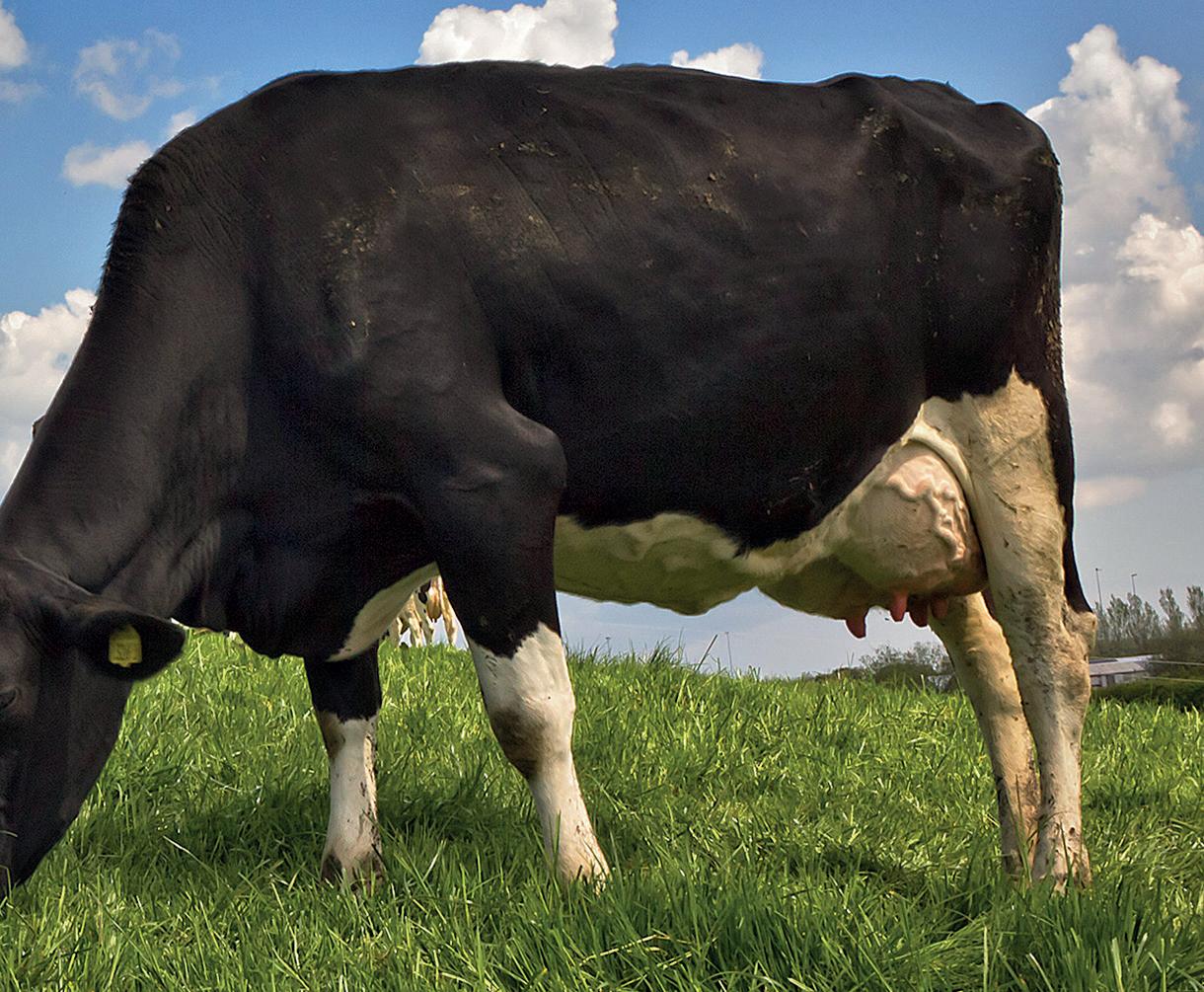
51 ANIMAL HEALTH APRIL 2023 HIGH MILK UREAS Our range of feed products can help prevent problems We are on hand with our expert advice MILK PROTEIN DROPS MILK FAT DROPS ACIDOSIS STAGGERS Contact our friendly team on 01977 710946 or visit kwfeeds.co.uk We’ve got everything YOU need to help your herd stay healthy this turnout! KW Turnout ad A5 landscape ad Rev2.indd 2 01/03/2023 16:42
osis
Any unvaccinated new cattle to be included in the prevention programme can follow the normal vaccination routine
VIKKI WYSE
With the Animal Health and Welfare Pathway now being rolled out to farms in England, what lessons can English farmers learn from their Scottish counterparts?
What can farmers in England learn from the Scottish experience?
Funded vet visits are now focused on BVD management and farmers can arrange visits with their usual vet, with resources being made available for testing and developing a BVD plan on-farm.
But the Scottish BVD eradication scheme has been up and running for 10 years, so what are the key learnings for farmers in England?
Iain McCormick, veterinary investigation officer for Scotland’s Rural
College (SRUC), says: “After a period of voluntary testing, Scotland introduced a compulsory BVD eradication scheme in 2013.
“At this point, the BVD prevalence was estimated at 40% [BVD not-negative herds], but now 8.8% of holdings are classified as BVD not-negative, which shows how progress can be made using a compulsory eradication scheme to decrease an endemic cattle disease such as BVD.”
With the BVD status of most of
the breeding holding known under the Scottish scheme, Mr McCormick says this has ultimately led to overall improvements in cattle health and welfare, and farms which have eliminated BVD have seen ‘benefits’ such as lower levels of calf pneumonia.
Success
Removing persistently infected (PI) cattle, which acts as a reservoir of infection, is also critical to the success of any eradication scheme.
Common causes of BVD breakdowns: Key learnings
Robust BVD health plan
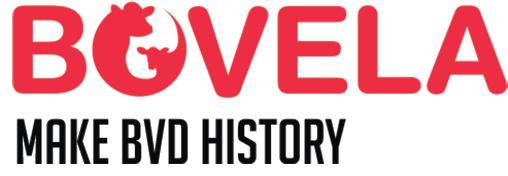
Mr McCormick says: “Negative by-chance units contain herds which may have poor biosecurity, such as nose-to-nose contact with neighbouring herds or workers regularly visiting other farms.
“In many cases, these producers are not vaccinating their breeding herd against BVD. If BVD is unwittingly introduced, it can have devastating consequences.
“Having a robust BVD health plan created in collaboration with your vet is, therefore, extremely important, with the focus of preventing BVD from gaining a foothold on your farm.”
Robust quarantine testing protocol
Mr McCormick says: “Referred to as ‘trojan cows’, these are pregnant females, unwittingly bought-in carrying a PI calf, and are responsible for several BVD breakdowns in unsuspecting herds each year.
“Having a robust quarantine testing protocol is a good start, but tag-testing the calf as soon as possible after birth is also highly recommended, irrespective of the health status of the farm of origin.
“Farmers should isolate the dam and her new calf from the rest of the herd until they have both been tested and negative results are known.
“Not adhering to this advice had
been the cause of several spectacular BVD breakdowns in Scotland.”
Robust test checks
Mr McCormick says: “Check tests are an ideal opportunity to ensure that there has been no BVD exposure on-farm.
“Testing five unvaccinated nineto 18-month-old home-bred calves per group is required if they have been housed together for more than two months.
“All separately managed groups must be correctly identified and tested and your vet will help you identify which calves to test.”
For management groups larger than 50 animals, it is recommended
Mr McCormick says: “The latest stage, known as phase five, began in December 2019 and there are currently 19 known live PI calves in Scotland, on 11 different holdings, compared with 187 on 57 farms at the beginning of phase five. This is excellent progress, but 19 cases is still too many.”
that 10% are sampled. He says: “There can be the temptation to cut corners and not stick to these rules. However, this creates a false economy as BVD breakdowns can get missed and the opportunity for a proper, rigorous, timely investigation is delayed.
“As Scotland moves to the next stage of its eradication scheme, the advisory committee is keen to address many of the pitfalls discussed above.
“Continued effort must be placed on farmers engaging with their vets about BVD eradication and control. Ultimately, the end goal of a BVDfree nation is possible, but only if all devolved nations work together.”
52 APRIL 2023 SPONSORED CONTENT
For more information, visit boehringer-ingelheim.com/animal-health
Top tips for an effective youngstock check test

● Ask your vet why testing the right number of animals from each management group is important
● Check the cattle have been housed together for more than two months
● Walk round the cattle sheds
with your vet to agree how many management groups there are before getting cattle into the crush
● Test five unvaccinated nineto 18-month-old, home-bred calves per management group, or 10% if 50 or more in the group
Top tips to avoid buying a ‘trojan cow’
● Ask the seller if the cow has been vaccinated against BVD, enquire about the farm’s BVD status and her pregnancy status
● Isolate the newly purchased cow/heifer on arrival and get your vet to blood sample her for BVD antibody and virus if she is in-calf
● Remember if the cow is BVD
virus negative, the calf inside could still be a PI
● Calve her in isolation and tag test the calf as soon as possible after birth
● Do not mix the cow and newly born calf with the rest of the herd until you have had negative test results back for both cow and calf
Role of vaccination
FOR many herds, vaccination is ‘key’ for preventing BVD breakdowns.
Mr McCormick says: “Biosecurity is important, but considering the many ways BVD could enter a herd, relying on biosecurity alone can be a risky strategy.

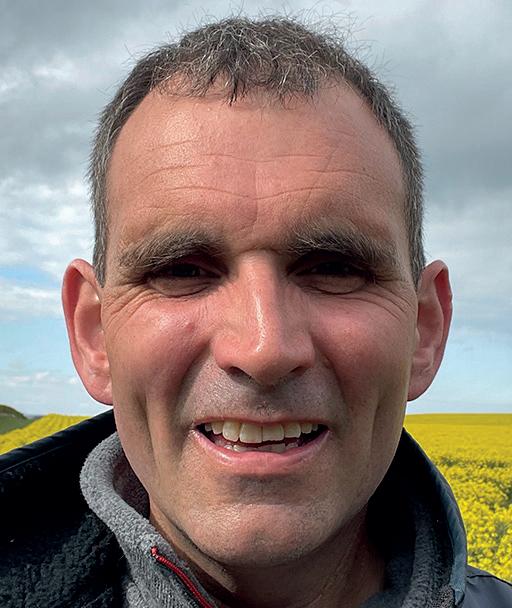

“An effective vaccination protocol ensures all breeding cows and heifers are protected before service and throughout pregnancy to prevent the birth of PIs.
“The Annual Health and Welfare Review is a good opportunity to review vaccination protocols and ensure all breeding cattle are fully protected.”
The Scottish BVD eradication scheme has been up and running for 10 years, so what are the key learnings for farmers in England?
Iain McCormick
150 countries, we offer a large and innovative portfolio of products and services to improve the health and well-being of companion animals and livestock. As a global leader in the animal health industry and as part of family-owned Boehringer Ingelheim, we take a long-term perspective. The lives of animals and humans are interconnected in deep and complex ways. We know that when animals are healthy, humans are healthier too. By using the synergies between our Animal Health and Human Pharma businesses and by delivering value through innovation, we enhance the health and well-being of both. Bovela® lyophilisate and solvent for suspension for injection for cattle contains modified live BVDV-1, non-cytopathic parent strain KE-9: 104.0–106.0 TCID50, Modified live BVDV-2, non-cytopathic parent strain NY-93: 104.0– 106.0 TCID50. UK: POM-V. Further information available in the SPC or from Boehringer Ingelheim Animal Health UK Ltd, RG12 8YS, UK. Tel: 01344 746957. Email:vetenquiries@boehringer-ingelheim.com. Bovela® is a registered trademark of Boehringer Ingelheim Vetmedica GmbH, used under licence. ©2023 Boehringer Ingelheim Animal Health UK Ltd. All rights reserved. Date of preparation: January 2023. BOV-0020-2023. Use Medicines Responsibly.
53 SPONSORED CONTENT APRIL 2023
About Boehringer Ingelheim Animal Health UK: Boehringer Ingelheim Animal Health Boehringer Ingelheim Animal Health is working on first-in-class innovation for the prediction, prevention, and treatment of diseases in animals. For veterinarians, pet owners, farmers, and governments in more than
Problems caused by lungworm and gutworm outbreaks can have an impact on productivity, so now is the time to implement prevention strategies. Wendy Short reports.
Making worm control a priority
Last year’s droughts limited the exposure of cattle to lungworm and there is an increased risk that adult cows will become infected this season, while previously grazed youngstock may not have developed the usual level of natural immunity, according to Sarah Woollatt, of Langford Vets.

Contrary to common belief, lungworm outbreaks are not confined to youngstock at grass and can affect all stages of livestock at any time of year, although young animals in their first grazing season fall into the highest risk category, says Miss Woollatt.
The parasite, which thrives in warm, wet conditions, is best controlled through a combination of vaccination and controlled exposure, with the first vaccine dose given six weeks before turnout.
Miss Woollatt says: “Lungworm is a disease which requires preven-
tion, rather than cure, because the symptoms might only become evident after the animal has already suffered serious internal damage.
“Hidden, subclinical losses include reduced growth rates and milk drop, with each adult dairy cow case costing up to £140 in lost production. Serious cases can even result in death.”
The standard oral lungworm vaccine is highly effective when used properly, she says.
“Heifers should receive two doses of the vaccine four weeks apart. That will give full protection from two weeks following the final dose, so the treatment will need to be planned at least six weeks ahead of turnout. Calves can be vaccinated from eight weeks.

“After the initial course, a single booster dose can be given every year pre-turnout, although if cattle are naturally exposed to lungworm after first vaccination, this is unlikely to be required.
“The medication contains irradiated larvae which cannot
fully develop and this allows the animal’s immune system to fight the infection, providing immunity against future attack.”
The lungworm’s four-week life cycle starts with grazing cattle eating infective larvae, which migrate from the intestinal tract via the bloodstream to the lungs.
They move to the upper respiratory tract within a few days and, in adulthood, will lay millions of eggs which are coughed up and swallowed.
The eggs then develop into larvae in the gut and are shed in dung on to pasture. Symptoms of infection include coughing, increased respiratory rate, difficulty breathing and weight loss, with a dip in milk yield for milkers.
Vaccination
Miss Woollatt says: “Our recommendation is to vaccinate all heifers before their first grazing season. The vet can also perform a diagnostic faecal test to confirm presence of live larvae so cattle can be removed from infected pasture.”
While the impact of gutworms is normally less severe compared with lungworm, they are widespread and will affect productivity.
The most significant UK species are Ostertagia (brown stomach worm) and Cooperia (roundworm).
Advanced cases may show the classic ‘bottle jaw’ chin swelling, with milder signs including scour, loss of appetite and general poor condition, with a yield penalty in milkers.
Second calvers are unlikely to be
affected unless their health is otherwise compromised.
Gutworm control relies on monitoring burdens, targeted worming and controlled exposure, says Miss Woollatt.
She says: “Silage or hay aftermath, or fields previously grazed by adult cattle, are lower risk and should be reserved for first-season youngstock, while pasture with a history of high-density youngstock may carry a heavy worm burden.
“Worming products come in different formulations, including pour-on, oral drench or injectable. Farm history and test results should guide treatment timings and reduce unnecessary dosing.
“Cattle grazing in outlying areas which are likely to require multiple doses throughout the season may benefit from a long-acting bolus administered before turnout.”
Anthelmintic withdrawal periods must be considered when treating milkers and pre-turnout treatment of adult groups is rarely suitable.
There have been reports of wormer resistance in cattle, she says, although the incidence is less well-documented compared with sheep.
“A gutworm treatment bolus gives continuous release, lasting for 140 days. Its effect is immediate, so there is no need to plan the treatment ahead.
54 ANIMAL HEALTH APRIL 2023
Our recommendation is to vaccinate all heifers before their first grazing season
SARAH WOOLLATT
“Animals can be dosed to reduce build-up of infective larvae on pasture or as a later season treatment.


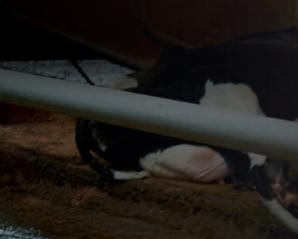


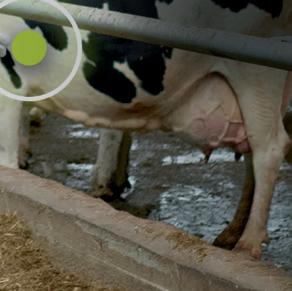





“Lungworm larvae are also killed o by worming treatments, so leave youngstock for at least two weeks a er their last lungworm vaccine
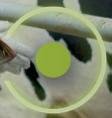
dose before giving boluses or other worming products.”




Testing for gutworm can be carried out by a faecal egg count (FEC) or by a blood test which measures blood protein levels.

FEC has a place in gutworm


monitoring, but the technique has its limits, she says.

“It is bene cial to perform an FEC every four to six weeks to highlight the extent of the infestation. However, counting worm eggs will only indicate the number of adult





female worms in the gut and it is o en the larval stage which causes most damage.


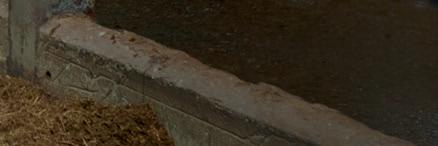





“Weighing animals ahead of turnout and every six weeks therea er may give an indication that growth rates are not meeting expectations, warranting further investigation.”




Worm control in ca le is not a simple ma er of dosing with anthelmintics, especially given the negative environmental impact of drugs, such as ivermectin, she says.
Overuse can inhibit the development of natural immunity, as well as harming biodiversity and soil health, so pasture management is an important element.

“Individual treatment programmes should be discussed with the vet and decisions based on a range of factors, including past levels of infection, grazing history and stocking rates. Last year was low risk for lungworm, but there is no way to predict the weather pa ern for this year and other worm species must also be considered.”


With early detection and best advisory in health reproduction feeding


55 APRIL 2023
Lungworm is best controlled through a combination of vaccination and controlled exposure, with heifers given their first vaccine dose six weeks before turnout.
Bovine neosporosis is a common cause of infectious abortion in cattle. Prof Lee Innes, of the Moredun Research Institute, outlines the parasite’s route of transmission and offers some suggestions for reducing infection risk. Wendy Short reports.

Veterinary surveillance data from 2017-2021 in Scotland showed that neospora caninum infection accounted for 7% of diagnosed abortions in cattle, while a further study in UK dairy herds which tested for antibodies in bulk milk samples indicated a prevalence of 51%.
Prof Lee Innes, of the Moredun Research Institute, says there is no neospora vaccine available and no licensed treatment methods, so preventative measures are the only option for herd protection.
The route of infection begins with a dog eating neospora cysts in infected bovine tissue, or tissue from other infected animals. This leads to the shedding of eggs in the dog’s faeces and these can persist in the environment, contaminating animal feedstuffs.

The next stage is horizontal transmission, when cattle consume contaminated food, followed by vertical transmission to the calf, which can continue for several subsequent pregnancies. Infection can lead to either abortion or the birth of a per-
Reducing neospora risk
levels are likely to be high and easier to detect.
“The presence of neospora will not necessarily confirm that the disease is the cause of abortion. When the results come back they will be evaluated alongside herd health history before the final diagnosis.”
There are several preventative measures to protect herds against neospora, she advises.
Neospora has no obvious clinical effect in non-pregnant females, but infection in early pregnancy may result in foetal death.
sistently infected heifer calf which can produce further infected calves if used for breeding.
“Disease severity will be influenced by the stage of pregnancy at the time of infection,” says Prof Innes. “Neospora has no obvious clinical effect in a non-pregnant female, but infection in early pregnancy may result in foetal death.
“Several clinical effects are pos-
sible in mid-gestation, including abortion and congenital infection of the foetus, and in some cases the newborn may show signs of a neurological defect. An abortion storm will be confirmed if it affects 10% or more of the herd within a 12-week period.
“Infected cows in late pregnancy can also produce calves which are congenitally infected with neosporosis or calves may demonstrate weakness at birth. However, some calves may appear normal despite being persistently infected with neospora.”
Neospora can be diagnosed by analysing foetal or placental tissue in a laboratory, she says.
“There is no evidence that humans can contract neospora and it is not transmitted from cow to cow,” she stresses. “Nevertheless, because abortion can be caused by diseases such as brucella and leptospirosis, which pose a risk to human health, material for testing should be handled using gloves. The area should also be thoroughly cleaned using a standard farm disinfectant.
“The other diagnostic methods involve testing specific antibodies in blood or milk samples, or foetal fluids. The best timing is late pregnancy or after an abortion, when antibody
“Avoid bringing in infected cattle by selecting replacement stock from herds that are part of a neospora-accredited health scheme and have a recorded history of high fertility performance. Incomers can also be blood tested and re-tested for their next two pregnancies.
“Bulls can become infected, but there is no evidence that neospora can be transmitted via semen.
Control measures
“Safely dispose of afterbirth and other bovine tissue and control rodents, because rats and mice can present a risk if eaten by dogs.
“Where possible, dogs should be prevented from having access to cattle feed and forage, as well as fields designated for forage cropping, livestock water sources and calving areas. Dogs can become infected by eating contaminated raw meat, which can be made safe by freezing it for a minimum of 14 days. I would suggest displaying notices on public footpaths asking dog walkers to pick up after their pets.”
Moredun researchers are investigating the feasibility of developing a vaccine against neospora, along with improved detection techniques.
“Until we have access to an effective vaccine, it is essential that producers take steps to reduce the risk of neospora infection, as it can cause serious financial losses and have a negative effect on animal welfare,” says Prof Innes.
56 ANIMAL HEALTH APRIL 2023
SOURCE : Moredun
neospora Neospora parasites within tissue cyst Dog gets infected by consuming neospora cysts within infected bovine tissue or tissue from other infected animals Oocysts (eggs) shed in dog faeces can persist in the environment and contaminate feed and water Horizontal transmission through consumption of oocysts Vertical transmission often over several pregnancies Persistently infected calf Breeding of persistently infected calf Transmission of neospora in pregnant cow to foetus may cause abortion or result in birth of persistently infected calf Abortion: Severity of disease depends on stage of gestation when infection occurs
Lifecycle of
WE ARE HIRING!

Are you looking to work in a friendly, dedicated farm animal team in beautiful Gloucestershire with progressive dairy, beef and sheep farmers?
We are recruiting for the following positions:
Experienced Farm Veterinary Surgeon - The ideal candidate will enjoy routine dairy work, with an interesting amount of beef, sheep, gamebird, small holder, and export work. Part time/flexible options considered.

Approved TB Tester (ATT) – Working a four-day week on farms delivering statutory TB testing of cattle alongside our clinical team. Full training would be given for the ATT qualification, with the practical and technical support of an experienced team of vets and office-based colleagues. Qualified ATTs and OVs are welcome to apply. We are privileged to have a forward thinking client base, always keen for training and health planning. We have an in-house Laboratory with dedicated technicians providing advanced diagnostics such as Johne’s and Neospora testing with bulk tank and mastitis culture and sensitivity.
Alongside the clinical team is an exceptional office team, a Vet Tech, NACFT Foot Trimmer and 3 TB Testers, allowing us to provide a high standard of veterinary services to our clients. We have regular clinical and whole farm team meetings to support, develop and build relationships in the team.
Excellent salary and employment packages available.





For more information please visit our website https://woodvets.co.uk or contact the Practice on 01452 543999
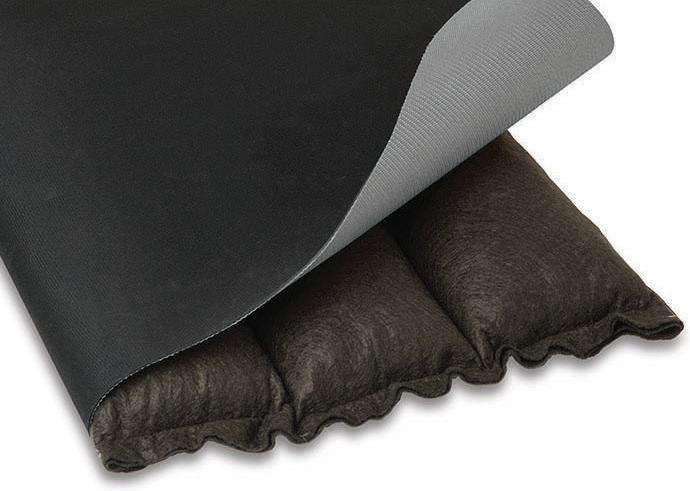

Wood Veterinary Group, 125 Bristol Road, Quedgeley, Gloucestershire, GL2 4NB

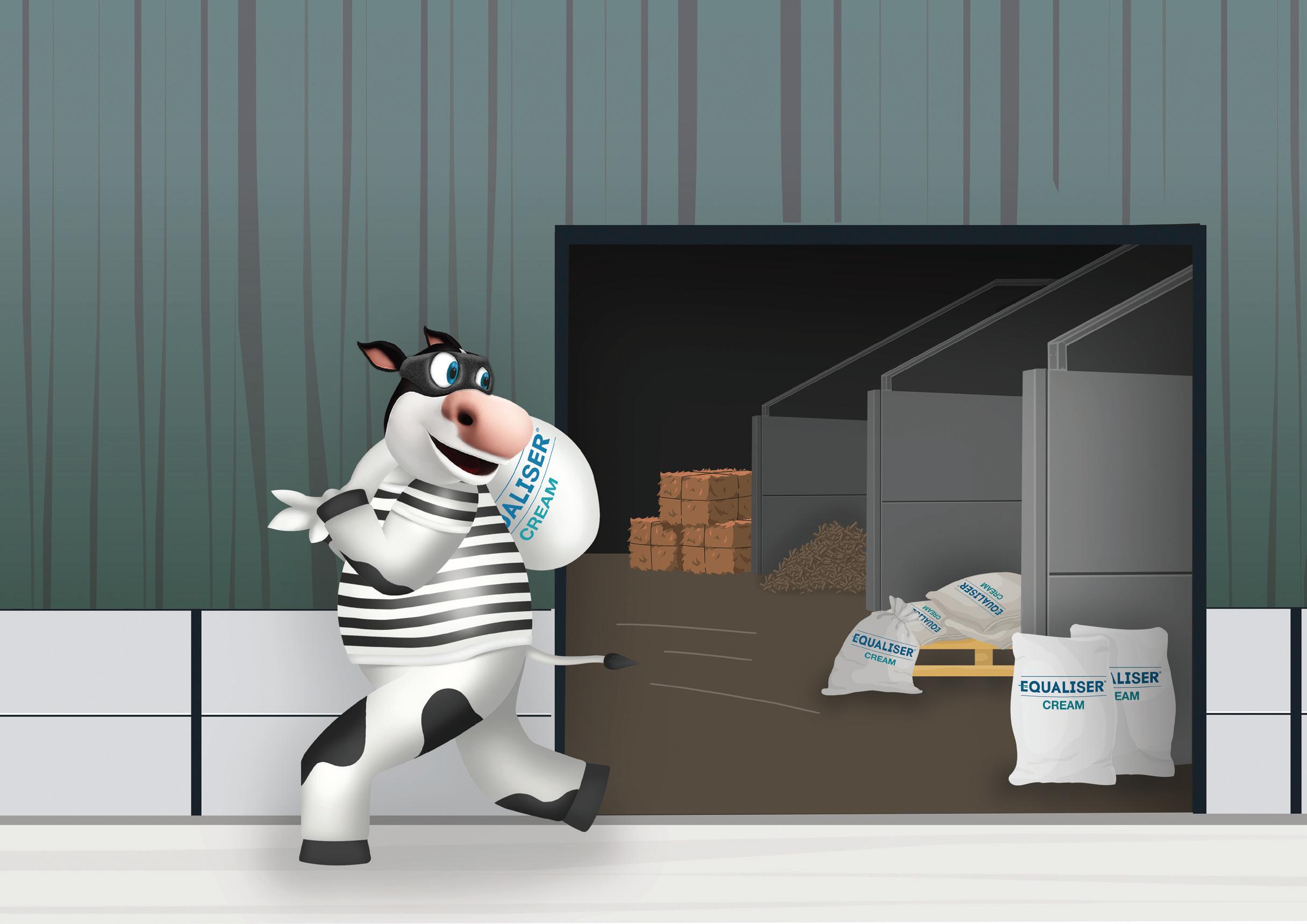




















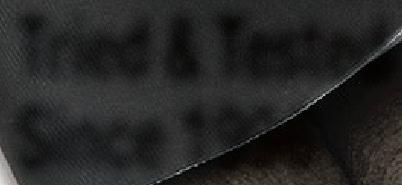


















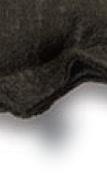


57 APRIL 2023
Proven 3 Ply waterproof rubber top cover www.cozycow.co.uk info@cozycow.co.uk Cozy Cow UK Ltd 07713 097184 /01296 738122 Quality and Value from a name you can trust Tried & Tested Since 1996 Unbeatable comfort and long-lasting performance ALSO ON GRANT - Range of Rubber Flooring and CCTV Syste Available with foam pad 50mm thick mattress with DPM & balanced latex core AVAILABLE ON GRANT NOW ! AVAILABLE ON GRANT NOW ! In 2021 and 2022 feeding Equaliser® Cream improved milk income on UK farms by £2412 per month*, with an average uplift in milk butterfat of 0.33% within 7 days and 0.51% within 1 month of feeding. Contact us today to maintain your herd performance this spring! *Average daily income per cow improved by 51p. Monthly figures based on a 155 cow herd. www.provimi.eu/uk-equaliser T (01845) 578125 E customerservices_dalton@cargill.com @CargillAnimalUK So good the cows want it back in their ration
Multiple factors from mob grazing to trace element deficiencies can cause a spike in somatic cell counts (SCCs) at turnout, but with planning and attention to detail, these can be avoided. Debbie James reports.
Avoid spikes in somatic cell count at turnout
Spring turnout is the high point of the year for many dairy farms, but the associated labour saving and feed cost benefits are often diminished by an annual spike in SCCs.
When 8% of the herd – one cow in 12 – has a high SCC during the first month of calving, from day four to 28, it indicates a problem, says vet Dr Sotirios Karvountzis, of Mendip Vets.
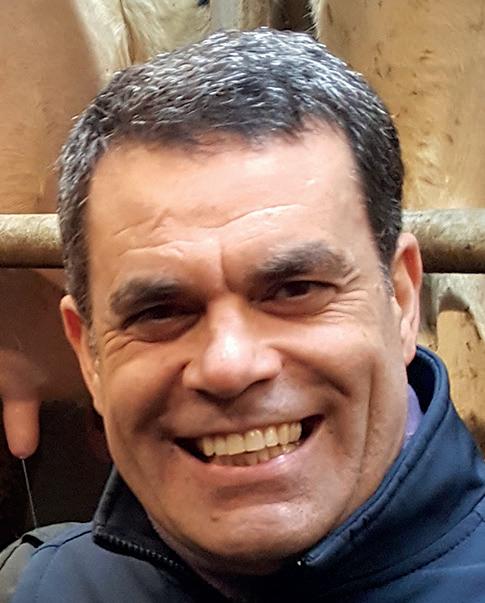
well-ventilated and temperature-controlled conditions in winter, in contrast to the situation at turnout, when control over their environment is relinquished, Dr Karvountzis says.
over moisture levels and we cannot disinfect.
Farmers invest money in housing cows in clean,
“Cows tend to return to the same area of the field to lie down, where they may or may not have leaked milk, so that area could have some level of infection.”
It can take six to 12 hours for
Strategies farmers can take to avoid an annual elevation in cell
AVOID MOB GRAZING WHEN COWS ARE AT MAXIMUM YIELD: Mob grazing reduces the space available to each cow and increases the chances of them laying on a patch of grass which might have been contaminated by a leakage of milk.

Dr Karvountzis says:
“Although there are many good reasons for mob grazing, the potential risk it poses to udder health at this time must not be underestimated, so it
is sensible to avoid this system of grazing when yields are high.”
“Although grass is fairly clean, it is not dry, we have no control 1
2USE AN IODINE-BASED DIP BEFORE AND AFTER MILKING:
Dr Karvountzis says: “Dips and sprays each have their benefits, but at this time of the year I would advocate using a dip pre- and post-milking, because, provided it is used correctly, it covers the entire teat from the base to the tip of every teat, every quarter of every cow.
A cow will need 5-50g [of ammino acids] per day DR SOTIRIOS KARVOUNTZIS
“Dipping is more timeconsuming, but it gives a head start on protecting the teat from pathogens until the end seals.
“My personal preference is an iodine-based dip which includes a high concentration of lanolin.”
These might be more expensive, but Dr Karvountzis says it is a small cost when balanced against the 10-20% loss in expected milk yield in a cow with sub-clinical mastitis and the associated increased risk of culling at some stage.
3
DO NOT OVERLOOK THE IMPORTANT ROLE OF TRACE ELEMENTS:
Dr Karvountzis says it is important to take the advice of your first opinion vet on correcting any trace element deficiencies which may be contributing to high cell counts.
He says: “Selenium, vitamin E, cobalt, copper and, to a lesser extent, iodine and zinc, even in
counts
small amounts, can improve the immunity of cows. There are no independent published studies on the correct amounts needed, but we know they help the cow fight off infections which result in high SCCs.”
4LOOK AT WHAT IS IN THE COW DIET:
While trace elements are important, so too is nutrition generally, says Dr Karvountzis.
He says: “Many people ignore the role of ammino acids, largely because they are very expensive at about £1,000/tonne.
“A cow will need 5-50g/day, depending on her specific requirement.
“Ensure there is sufficient high-quality protein in the diet to provide this, especially during early lactation.”
5
ACR SHOULD BE SET CORRECTLY TO AVOID OVER-MILKING:
58 ANIMAL HEALTH APRIL 2023
the teat to seal a er milking, a period which has extended greatly with changing genetics.


Dr Karvountzis says: “Twenty years ago it was thought that it took 30 minutes for the teat to seal, but as yields have gone up it can be anything from six to 12 hours, depending on teat conformation and yield, and that exposes the udder to possible infection for a very long time.”
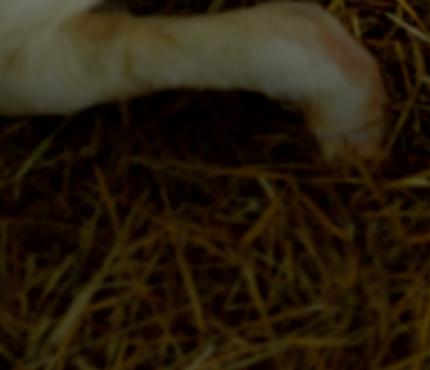

Dr Karvountzis says over-milking will result in ‘calluses’ forming on the teat end, which prevent it from closing, taking away a massive barrier to infection.

“Most parlours are set to remove clusters when there is 200ml of milk left; that is just 50ml in each quarter, which is incredibly low. The minimum I would recommend is 800-200ml in each quarter.”
Dr Karvountzis says it is also important to ensure a minimal gap between when the automatic cluster remover (ACR) starts pulling the cluster away from the teats and the vacuum being cut off.
He says: “The situation where the cluster is horizontal for any length of time should be avoided. Some ACRs are set to pull the units for 10 seconds before the vacuum is switched off, but it should be for no longer than three to five seconds.”
Dr Karvountzis recommends working with an independent parlour consultant to carry out a dynamic test, as closing that gap will almost certainly reduce SCCs.
He adds that the vacuum reserve must also be appropriate to the type of parlour and leakages – dynamic testing is the best way to assess this.

Reviva
Farm-O-San Reviva is an easily digestible, highly palatable energy drink for freshly calved cows, that should be given immediately after calving.

It helps the cow to rehydrate rapidly after calving. Farm-O-San Reviva increases the cow’s activity and forage intake.







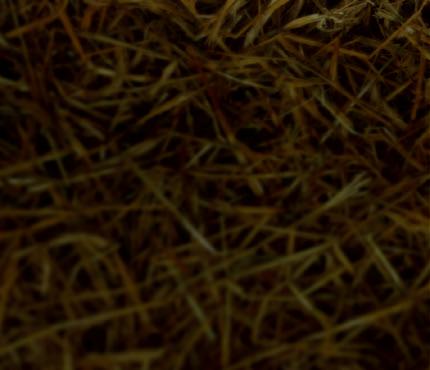
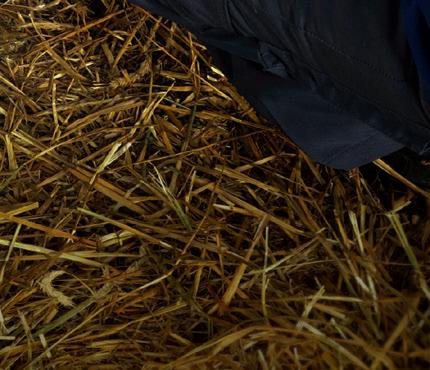
trouwnutrition.co.uk/reviva

59 APRIL 2023
The orange energy boost for recovery after calving
Cows tend to return to the same area of the field to lie down, where they may or may not have leaked milk
DR SOTIRIOS KARVOUNTZIS
Dr Sotirios Karvountzis says it is sensible to avoid mob grazing when milk yields are high due to the impact grazing conditions can have on udder health.
With dry cows o en going under the radar due to milkers taking priority, experts at a recent Elanco and Advanced Ruminant Nutrition event in North Yorkshire discussed why successful transition management can help to reduce problems during lactation.

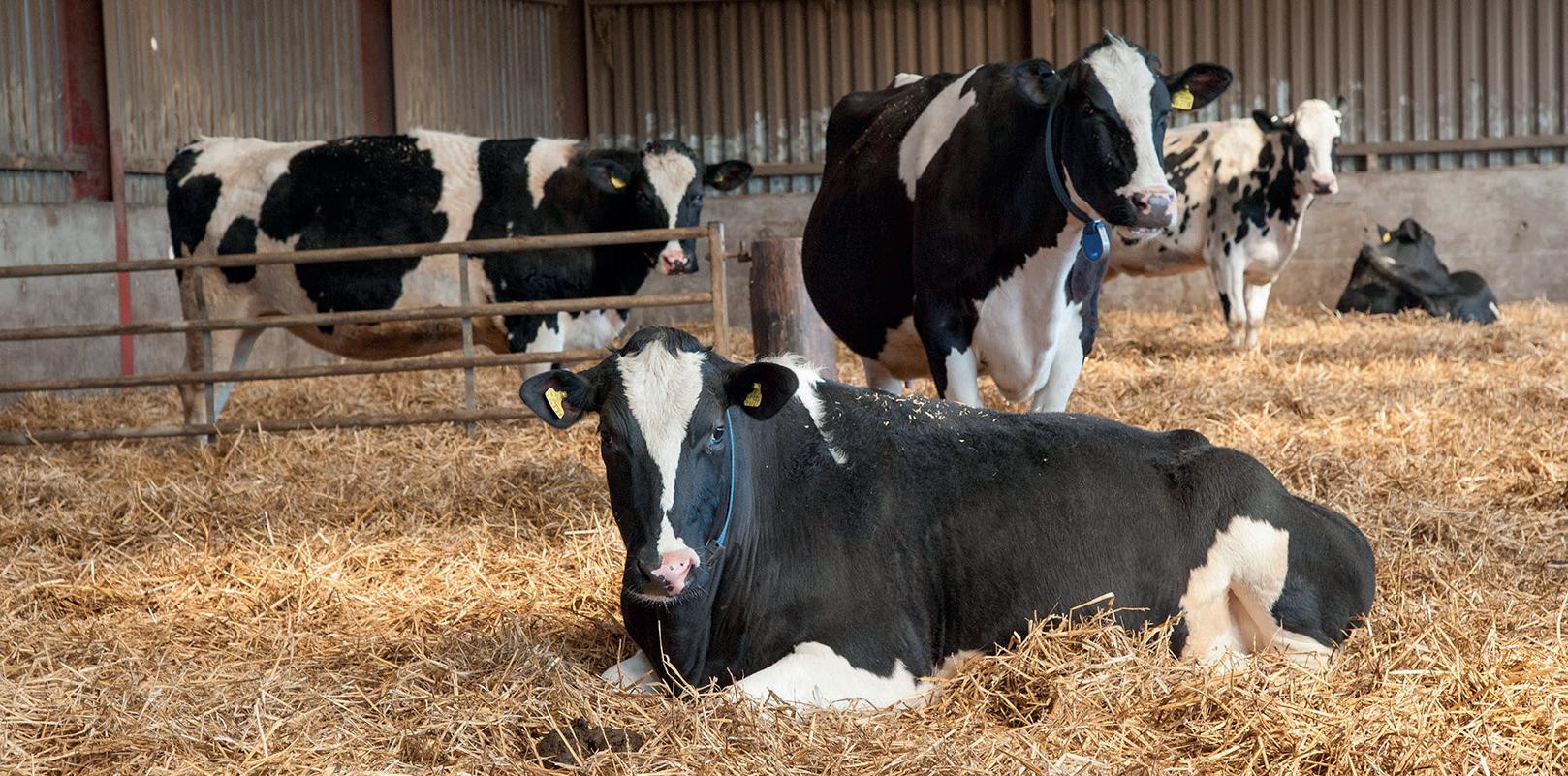
e transition period is the most crucial time on any dairy farm, said Roxanne Winstanley, veterinary ca le team and key account manager at Elanco.
And with recent research highlighting that 55% of antibiotic usage on dairy farms supplying Tesco are used during the transition period, it is becoming more important than ever to optimise dry cow health and reduce antibiotic usage ahead of increased industry pressure.
Ms Winstanley said the transition period came down to a negative energy balance, which happened to all animals and humans before giving birth.
She said: “Cows physically cannot eat enough as they get closer to calving. You will notice in the last few days pre-calving they go o their feed and usually take themselves o to the corner of the shed and stop drinking as much.”
She said this meant that when cows calved, they were already in a negative energy balance. erefore, it was crucial to get them eating as quickly as possible to start matching the level of milk they needed to
Managing dry cows
produce and ideally achieve peak lactation by 30 days in-milk.


She said: “People o en think that transition related problems are ‘milk out’ and they just think it is the high-producing Holstein cows which you get most problems with.
“Actually, it is ‘feed in’, so we want to maximise dry ma er intake in these transition cows.”
If the transition period goes wrong, problems such as ketosis will develop, said Ms Winstanley, a gateway disease which will cause further problems such as retained cleansings, twins, metritis and cysts, all of which relate to the transition period.
She said: “ e three cornerstones of pro tability for you as a farmer are milk production, the fertility of your cows and the overall health of the animals, and sub-clinical ketosis is going to a ect all three of these.”
In terms of milk production, a cow with sub-clinical ketosis will lose 350kg of milk per lactation and, re ecting on recent milk prices, Ms Winstanley said farmers could lose a large amount of money from just one cow su ering with sub-clinical ketosis.
Cows which have experienced ketosis will also take on average 22 days longer to return oestrus and, with the cost of a day open on-farm at about £5, when multiplied by 22 days it is costing a lot of money.
Ms Winstanley added that retained membranes, cystic ovaries and ketosis all added to involuntary cullings caused by issues during the transition period, another cost to the farm.
erefore, to improve the overall transition period, Ms Winstanley advised focusing on housing facilities.
To maximise cow comfort for dry cows in a straw pen, it is advised that for every 1,000 litres of milk a cow is expected to produce, they should be given 1sq.m of daily maintenance lying space. erefore,
a cow expected to produce 10,000 litres of milk should have 10sq.m of lying space. She also advised routine body condition scoring (BCS) of cows during the key points of lactation, ideally including 200 days in-milk, at dry o and calving and at 30 days in-milk.
She said: “You want to make sure that, on average, the BCS of that cow pre y much stays the same and what you dry that cow o at should be what it calves at.
Strip the fat
“Please do not trim fat o cows in that dry period. If they are looking a bit t during late lactation, strip the fat o them, do not wait until they are a far o dry cow.”
When it comes to feed and water during the transition period, Ms Winstanley said there should be 75-80cm of feed space available per cow and ve headlocks available for every four cows when feeding at a feed fence.
In terms of water requirements, Ms Winstanley advised at least 10cm of water access per cow at any one time and two troughs per pen to ensure cows always have access.
She said: “With good access to water, comes high dry ma er intakes.”
60 ANIMAL HEALTH APRIL 2023
Getting the transition period right can help achieve better results during lactation and improve cow health and productivity. Katie Fallon reports.
Roxanne Winstanley
It is crucial to get cows eating as quickly as possible after calving so they can achieve peak lactation by 30 days in-milk.
Three important things to remember ahead of the 2023 silage season
Lientjie Colahan, technical sales support at Lallemand Animal Nutrition, outlines three important things to consider:






1
DEVELOP A PLAN WITH YOUR NUTRITIONIST, AGRONOMIST AND CONTRACTOR
Now is a good time to start forageplanning discussions with your nutritionist, agronomist and contractor to help make the process as efficient as possible. Aim to discuss the following:
> Nutrition – work out a forage budget to include requirements for silage volumes and quality
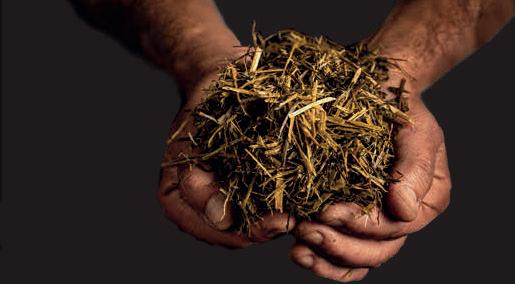

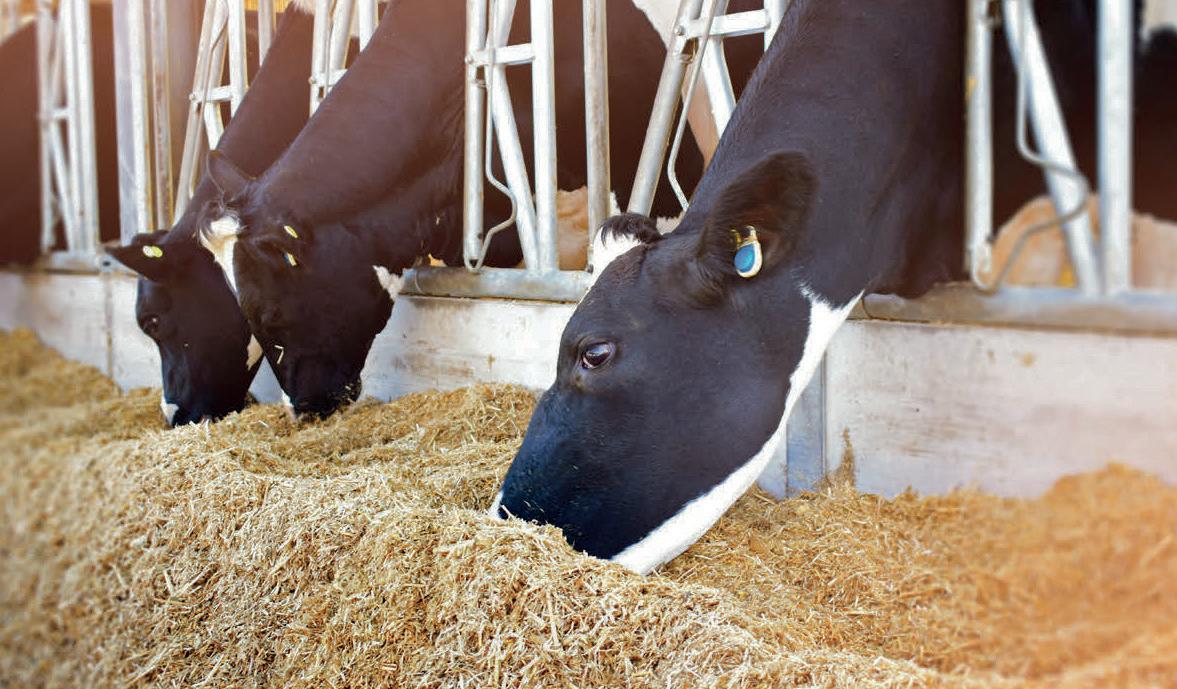
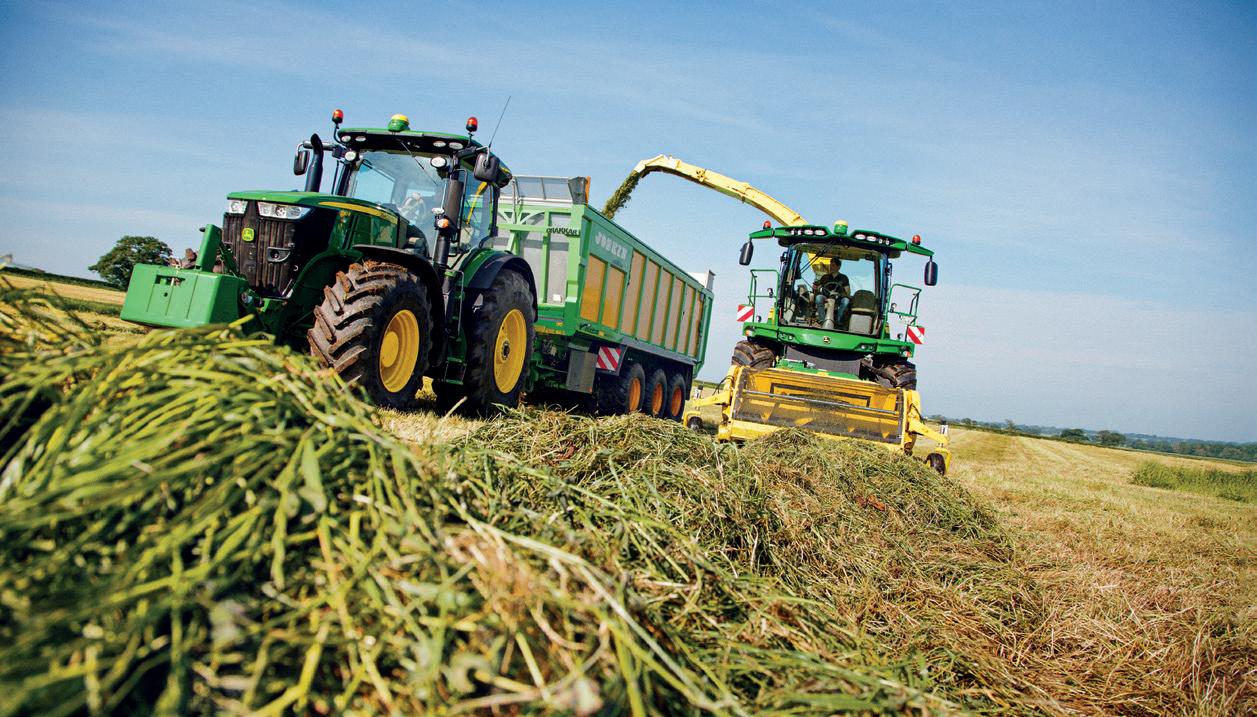
> Agronomy – discuss fertiliser plans and re-seeding policy to improve grass yields




> Cutting – plan your cutting timings and clamp construction, especially if cutting earlier than usual, as young, lush grass will compact more easily, so will need to be put in the clamp in thin layers and rolled with less weight

2
TEST BEFORE YOU CUT
Get your grass tested before going ahead with cutting – you cannot manage what you do not measure. Pre-cut grass testing helps to ensure the crop is at the optimum stage for cutting. Farmers should start sampling two weeks before the previous year’s cutting date, given the yearly variation in grass growth, to monitor nitrate, neutral detergent fibre (NDF) and sugar content.

3
MAKE SURE YOU HAVE EVERYTHING YOU NEED
Make sure you have everything you need ahead of silage-making – including silage sheets and inoculants – at least two weeks before you plan to start cutting.
Lallemand’s MAGNIVA range of forage inoculants utilises the bacterial strain L. hilgardii CNCM I-4785 in combination with the industry gold standard L. buchneri NCIMB 40788. The products’ unique combination of bacteria and enzymes offers three benefits:

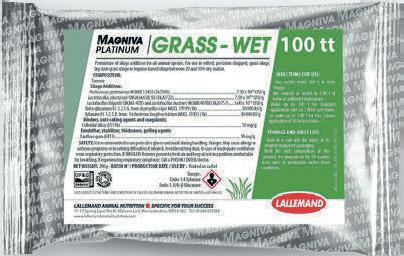

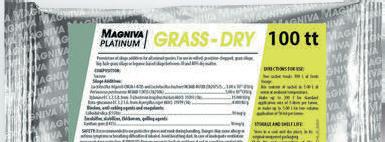
> Rapidly lowers pH










> Increases aerobic stability for early and conventional clamp opening


> Reduces waste and increases energy from silage, helping maximise the value of your forage – offering up to 13% more digestible fibre and up to 15% more dry matter

There are different MAGNIVA inoculants available, depending on the dry matter content of your silage. The Lallemand team are on hand to offer their advice on making the best quality silage possible – scan the QR code to find your local silage specialist:
TAKE CONTROL OF GRASS SILAGE QUALITY

Dairy and beef farmers are being encouraged to start planning for the silage season ahead.
PRE-CUT TESTING TARGETS Parameters Target Sugars (% DM) >15% Free nitrates (DM) <1,000 mg/kg NDF (% DM) 36-42% ADVERTORIAL LALLEMAND ANIMAL NUTRITION n SPECIFIC FOR YOUR SUCCESS www.lallemandanimalnutrition.com +44 (0) 1684 580022
Introduced as the most compact telescopic range from Manitou, the ULM’s diminutive dimensions may initially be overlooked. However, the range may offer unique options for businesses looking for an agile handler. James Huyton and Toby Whatley put one to the test.
Handy little loader
Compact telehandlers are not a new product for Manitou, with the two-tonneli MT420H having been o ered in the range for some time.
Launched in mid-2022, the
ULM range is now the smallest o ered by the French manufacturer.
Supplied in two models with a li capacity of 1,250kg and 1,500kg respectively, the ULM 412H and 415H provide users with the ability to tow the machine on a conventional plant trailer behind a 3.5t
Engine and transmission
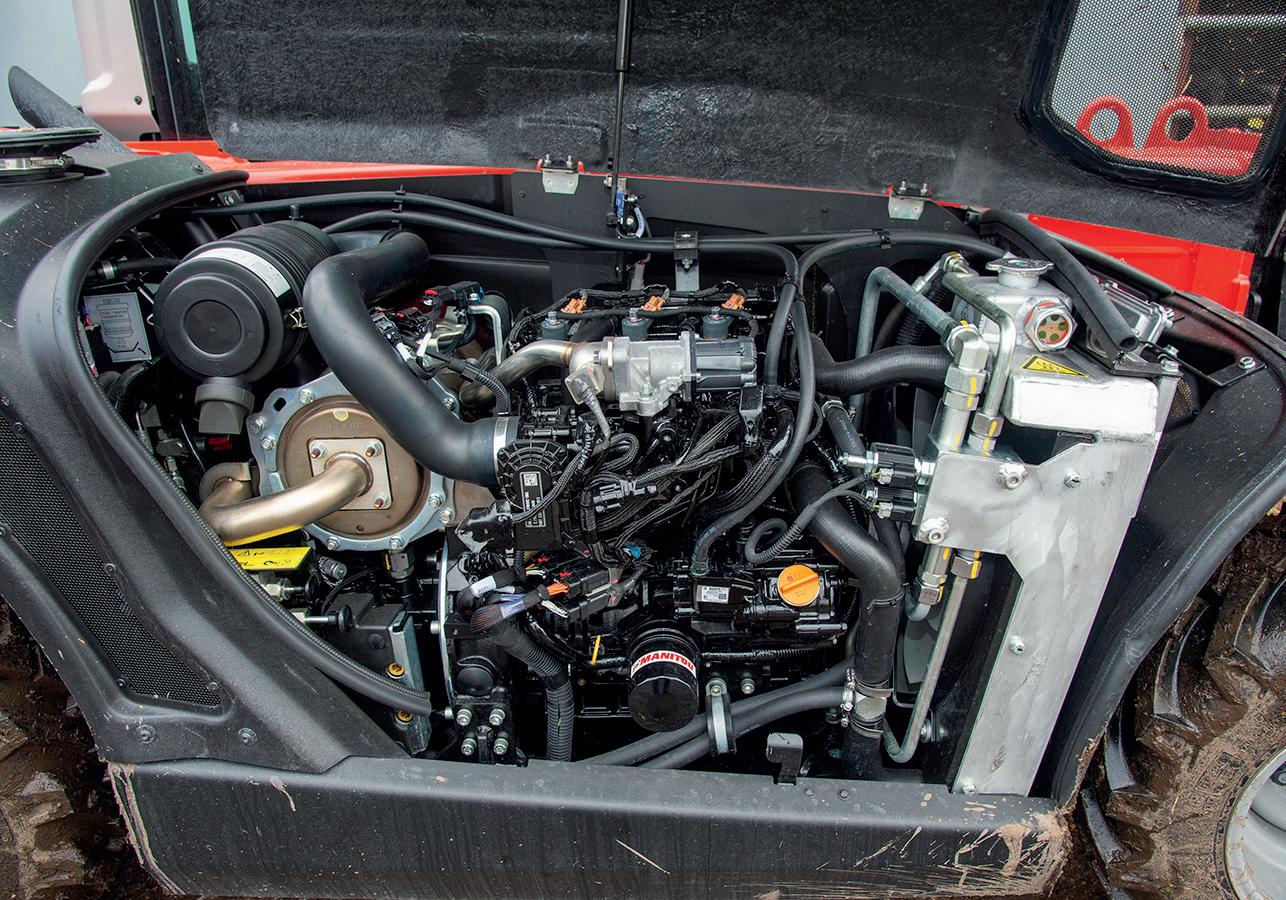
JBreaking from the current trend of manufacturers using batteries as a power source for compact handling equipment, the ULM is fitted with a threecylinder, 1.64-litre Yanmar diesel engine, delivering a maximum of 35hp.
Potentially a surprise that Manitou has chosen internal combustion for the ULM, its ability to be towed behind a 3.5tonne pickup has necessitated a tight weight limit – something which batteries do not offer.
Lifting the bonnet panel to the side-mounted longitudinal
engine reveals a well thoughtout engine bay. Access to daily checkpoints and filters for service was remarkably user-friendly, with a removable rear panel for more intricate service tasks.
Mounted towards the front of the machine, the hydraulically driven cooling fan can be specified as a reversible option.
This is an effective addition for a compact machine and an attractive option for dairy users.
The lower-powered Stage V engine does not require any additional AdBlue treatment, with emissions cleaning provided by a

rated pickup or van, a feature not previously o ered with the heavier MT420H.
Both models o er a maximum li height of 4.3 metres and a maximum forward reach of 2.62m from a machine measuring 1.49m wide and 1.92m high.
combination of a diesel oxidation catalyst and diesel particulate filter unit.
The machine uses an automotive-style stop-start engine system to reduce idle hours and fuel consumption.
The delay length of stop times can be specified through the in-cab control screen, with the engine restarting as soon as the joystick or steering wheel is moved.
In use, the restart did seem responsive and user-friendly when constantly in and out of the cab, with little delay between the restarting and hydraulic or drive engagement.
Combined with the hydrostatic transmission, the Yanmar engine proved to be very responsive, delivering torque when needed.
An electric high and low splitter in the cab provides transmission control, giving access to the Manitou’s 25kph forward speed.
Uneven terrain
During our test, this was not achieved, due to uneven terrain and limited yard space. For those carrying out work away from a concrete or hardcore base, both the front and rear axles are fitted with limited slip differentials.
e diminutive dimensions of the unit position it as an e ective additional handler for businesses looking to relieve the workload on a larger, less agile machine, and those with small traditional buildings where full-sized handler access is impossible.
We did not feel the machine lacked in acceleration or forward speed and, although road registered, any significant road use would be easier achieved using a plant trailer.
When travelling across the yard at 2,000rpm, an in-cab recording of 84dB was measured at the driver’s ear. This was quite noticeable and comparable to the noise delivered from a diesel UTV.
Although not a major issue, the in-cab sound was noticeable during a prolonged operation, particularly when compared to the sound-proofing quality of larger machines.
The low-range transmission, when used in conjunction with the inching pedal, made for a very usable machine working in tight spaces and loading.
Parking mode can be engaged manually with the in-cab button, although we opted to use the autopark function.
This is automatically applied when the forwardreverse rocker switch was left in neutral and is particularly useful when constantly jumping off the machine.
62 MACHINERY APRIL 2023
A non-turbo 35hp Yanmar Engine provides the power.
PICTURES : Marcello Garbagnoli
Manitou ULM 412H

rMaximum lift capacity: 1,250kg
rMaximum lift height: 4.3 metres
rMaximum forward reach: 2.62m
rEngine: Yanmar Stage V
rPower: 35.10hp
rHydraulic system: 48 litres per minute, 235 bar
rTransmission: Hydrostatic

rMaximum speed: 25kph
rTyres: 10.0/75-R15.3
rWeight: 2,750kg
rLength: 3.47m
rWidth: 1.49m

rHeight: 1.92m
SUFFOLK RETRO FIT DRIBBLE BARS
• Retro fits to any make of Tanker
• Working widths 6m to 10.5m
• Strong and safe 4 point attachment
• Dribble pipes 250mm spacing

• Vogelsang E.C.Q. Macerator
• Optional full lighting
• Optional Purge Valve and Spread Nozzle
• Optional Flow Meter
• Optional 3 Point Linkage Galvanised Umbilical Frame with Swinging Arm

For details of grant funding available search Rural Payments Agency Annex 3: FETF 2023 Productivity and Slurry Eligibility Items Grant

63 APRIL 2023
DIGESTATE AND SLURRY MANAGEMENT T: +44 (0)1449 766133 E: info@tramspread.co.uk WWW.TRAMSPREAD.CO.UK
Suffolk Retro Fit Dribble Bars Ad.indd 2 15/02/2023 18:11
Continues over the page...
The cab length covers the wheelbase of the machine.
MACHINERY
Engine and transmission
JWith a cab which almost covers the full wheelbase length, it initially looked like it has been lifted directly from one of Manitou’s larger ranges.
Once inside, you soon realise the cab width has been compromised to meet the design’s compact constraints.
A wide door opening provides easy access to the cab space and a twin sliding window provides a functional opening to the door.
Although this does allow an option of front or rear ventilation, it also generated some visibility issues when the overlapping glass allowed condensation to build between them, which was not easily cleared.
Users with repetitive issues of wet windows and dust can remove the windows entirely.
However, this does create a reasonably large opening in the side of the cab.
Dash dials, control buttons and the joystick are identical to the manufacturer’s larger ranges and provide a recognisable feel to existing operators.
Manitou’s JSM joystick lacks the familiarity of conventional joysticks offered by other manufacturers, but after a short period in the machine, the joystick became very intuitive.
Mounted on a well-designed floating armrest on the airsuspended seat, the joystick was joined with the main control switches and radio which was mounted vertically under the armrest.
Overall, this design won praise for its ergonomics and practicality in the access and reach of the controls.
Standard specification includes a heating system for the cab with an option for air-conditioning. Although this was not fitted on our test machine, we would recommend the option if continually operating in warm, dusty and damp conditions.


With regards to machine security, a digital code
Likes and gripes
LIKES
rCapabilities and lift capacity
rManoeuvrability and visibility
rFinish and specification in cab
rPotential attachment options
rTowable behind a 3.5-tonne vehicle
immobiliser and telematics are fitted as standard.
The telematics included the ability to geo-fence the machine’s working location using a smartphone app.
This system sends an alert when the machine leaves this pre-defined area, allowing the unit to be remotely tracked.
GRIPES
rLateral stability
rIn-cab noise
rManual locking pins
rCab width
rExposed wires and pipes around the chassis

64
APRIL 2023
The cab was well finished with an ergonomic design.
Boom, hydraulics and carriage
JManitou has created a compact boom design with the pipework for the carriage, third service and telescopic extension all running internally.
The obvious benefits of this are improved visibility and significant hose protection and, to counteract potential issues with hose leakage, Manitou has developed a patented system for hose movement, which is claimed to reduce hose bending and potential failure.
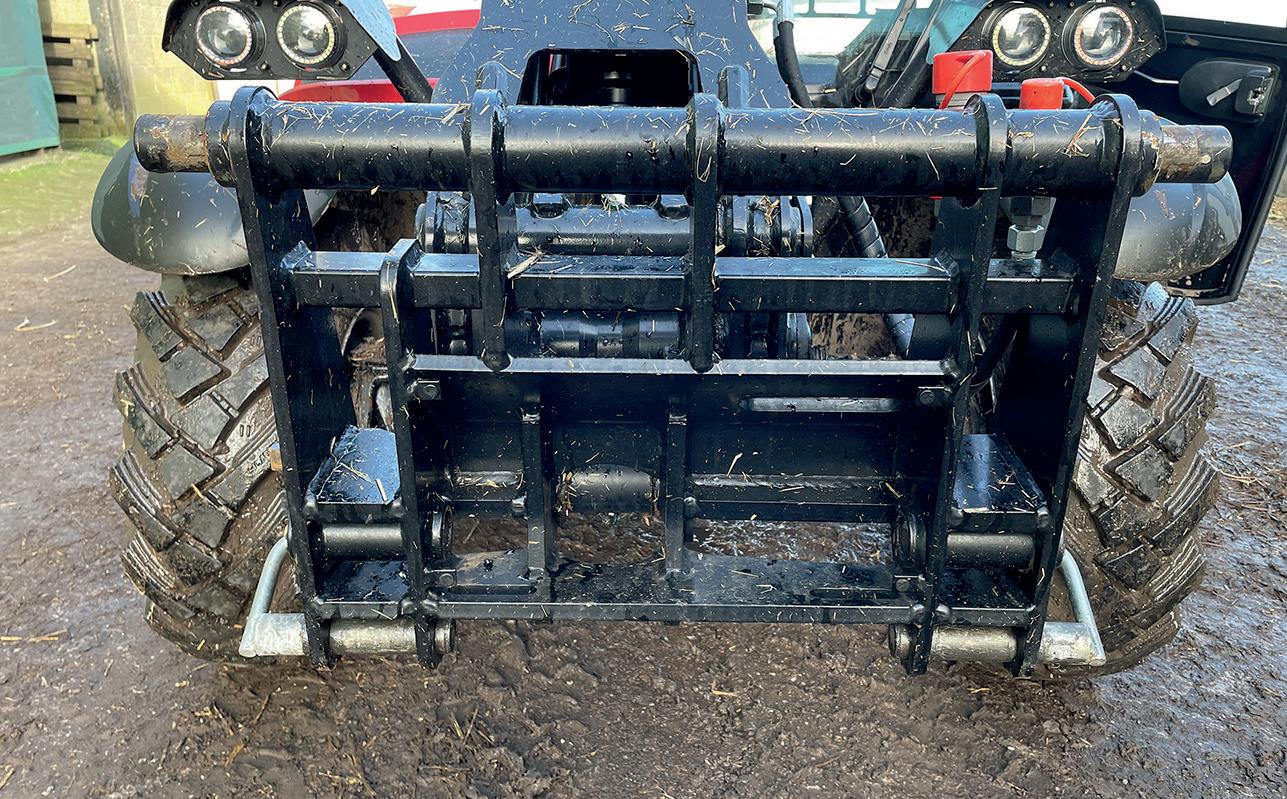
With a maximum outreach of 2.62 metres and a lifting height of 4.3m, the ULM clearly delivers when loading high-sided trailers for such a compact machine. This reach allowed the machine to comfortably load into a mixer wagon, with visibility being the
main challenge for an operator seated much closer to the floor.
A concern during operation with the boom raised was its stability on uneven ground when working at height, largely due to the machine width of only 1.49m.
Fitted with a 48 litres per minute gear pump, this delivered ample flow. However, higher flow users can specify a larger 62 litres/minute variant.
This could be worth considering for attachments, such as yard brushes or sawdust spreaders. Installed on the hydraulic tank, an anti-aeration filter for the return line has allowed for a 25 per cent tank reduction.
This design decreases both the machine weight and required fluid volume. A further weight reduction includes an electronic carriage

The machine can be supplied with three designs of headstock.
compensation system, which removes the requirement for a counter-balance levelling cylinder.

In use, it worked well, but did deliver occasional auto-corrections to the boom, which were marginally delayed, creating some slightly unexpected movements.
Fully retracted at ground level, the substantial boom knuckle and carriage provide a natural extension to the boom length. This allows the ULM to deliver a lift capacity of 1,250kg through the full lift height to 3m. It also
provides the handler with improved reach capabilities without any boom extension. A number of headstock carriage designs can be fitted from the factory, including Manitou’s four-point variant used on our test machine. Alternatively, Euro and skid-steer carriages can be specified. For all options, hydraulic locking pins should be considered to improve coupling efficiency, as the twin manual pins of the tested design were overly time-consuming to use. Continues
65 APRIL 2023
over the page...
DF verdict
JManitou’s ULM offers real potential for agricultural, horticultural and fencing businesses alike.
The compact design and manoeuvrability in confined spaces make it a strong contender against a skid-steer machine.
Its real value and a main strength for businesses with multiple sites are its sub-three-tonne gross weight and road-towable abilities, which offers the capability to move the machine from location to location without the need for a tractor and large plant trailer.
As a compact telehandler, its forward reach ability offers much more versatility than a skid-steer equivalent.

It could comfortably unload palletised products off wagons,
then turn its hand to mucking out calf buildings.
As a small second machine, it could be drafted to load the occasional bag of seed into a drill, or other larger handler duties.
When fitted with the optional skid-steer carriage, the list of affordable attachment options grows and adds to the handler’s versatility.
In practice, the ULM would have benefited from the fitment of some wider tyres to offer a little more cushion to help with rough terrain travel.
In turn, this could have also offered more stability to the machine. While the engine was small, its 35hp did not leave it wanting for more power, although a quieter engine with more refined soundproofing would improve
operator comfort greatly. But this would compromise the weight and ability of the machine to be pickup towed.
The build quality was not left lacking, although some chassis pipework did seem vulnerable and some undercarriage components could have benefited from a lick of paint.
Overall, the machine provided a comfortable well-designed operator environment, with



the potential to add a number of specifications to the machine or alternatively reduce it and its associated cost.




If the farm business was a single-site operation with a range of buildings and towable road transportation was not a necessity, the larger MT420H would provide greater options for a business requiring larger lift capacities in a compact frame.
Colour co-ordinator
JAs an alternative to its crimson paintwork, the ULM can be purchased as a Gehl GCT.
Better known as a manufacturer of skid-steer loaders in the North American market, Gehl is part of the
wider Manitou Group of companies.

The Gehl version is supplied through a separate dealer network. However, it is virtually identical to the ULM, apart from the paint colour and operator joystick.
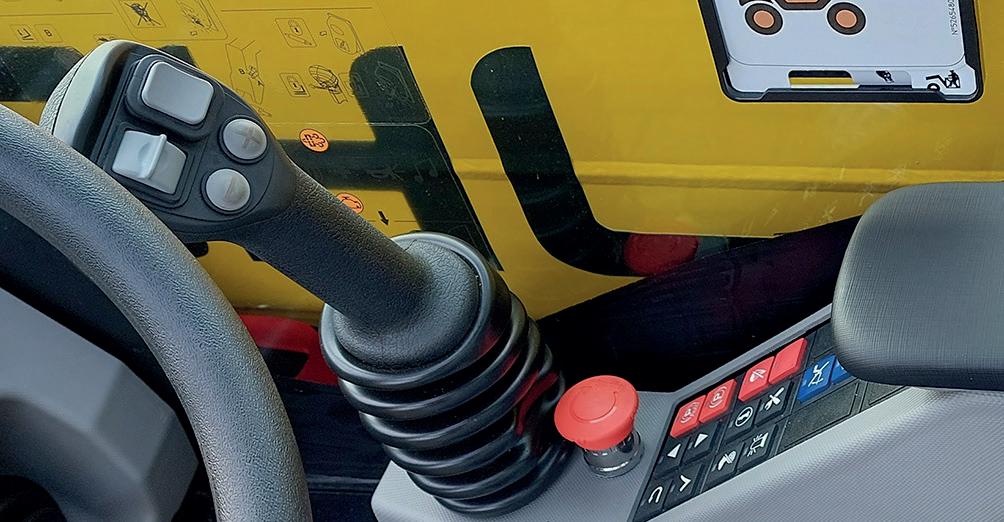
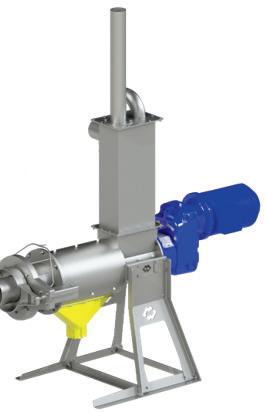
66 MACHINERY APRIL 2023 OWEN BOND@SAVECO-WATER CO UK WWW SAVECO-WATER CO UK Separators Green Bedding Screw Conveyors Long Shaft Pumps Submersible Pumps Submersible Agitators s EXPERTS IN SLURRY HANDLING 07851 25 26 27 01684 29 91 04 Call today to be put in contact with your local dealer
The ULM is also available as a Gehl with alternative joystick controller.
Despite its size, the ULM performed well loading a high-sided mixer.
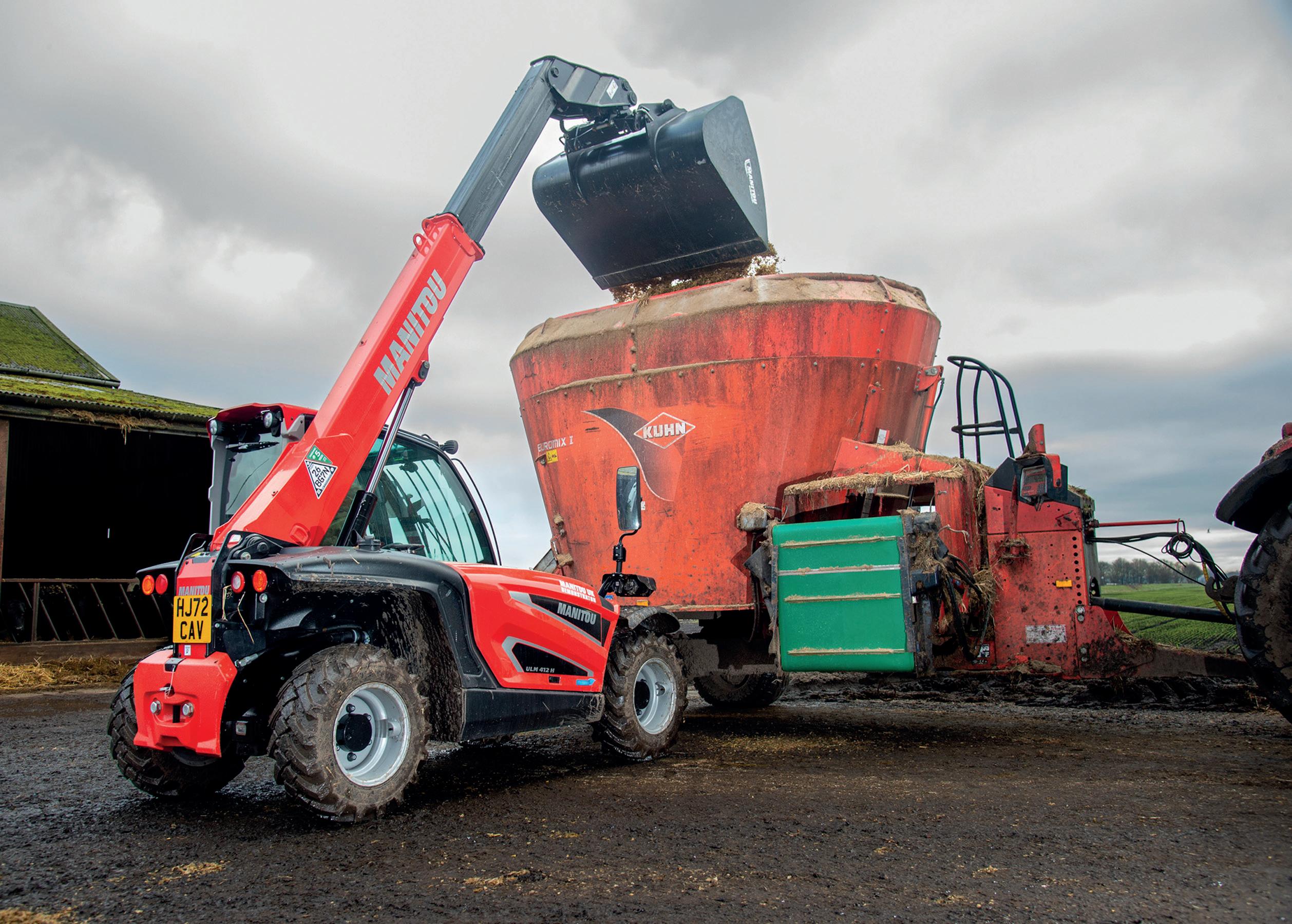
SEE THE ONLINE VLOG FROM AMY WILKINSON FGINSIGHT.COM/ MACHINERY
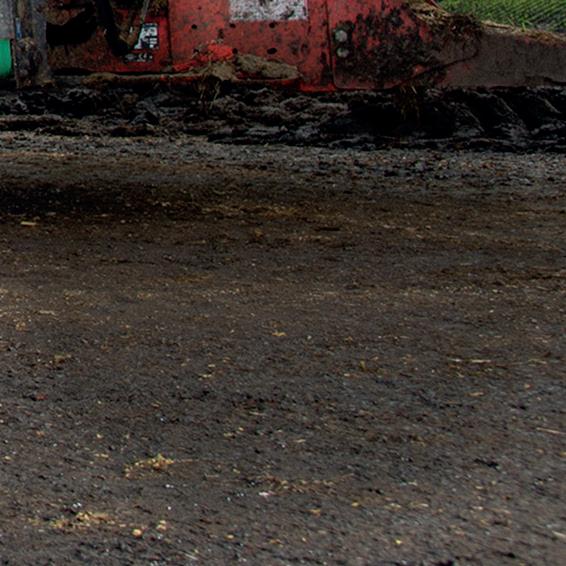

67 APRIL 2023
MILKprices

Milk price cuts continue at pace
JMonthly milk price reductions have continued at some pace through March and April to the point where the range of cuts from the start of the year through to April currently tally anywhere from zero up to 10.1ppl, based on our liquid standard litre*.
Of all the milk prices we track on a regular basis, there is currently just one remaining milk buyer, Marks & Spencer, which has yet to notify suppliers of any price cut, certainly having held its price unchanged up to the end of March and still paying its peak milk price of 52.66ppl for our liquid standard. is is a er the price was increased by 1.28ppl from January.
Unfortunately, that is pre y much the end of the good news for this month.


It would be great to report that April has seen the end to this rout of milk price cuts, regre ably though, milk prices are certainly not out of the woods just yet.
Many who may class Waitrose to be in a similar league to Marks & Spencer may be a li le surprised at the speed to which it has started its own price decline, having reduced its milk price by 0.5ppl from March, with a further reduction of 1.2ppl from April.
e two moves take our liquid standard price down to 48.3ppl. Currently residing in the middle of the above price cut range is Muller, which cut its Direct price by just 1.5ppl from April, taking our price down to 42.5ppl.
Balancing scheme
is cut is somewhat smaller than it might have been as the company also launches its new ingredients balancing scheme from April.
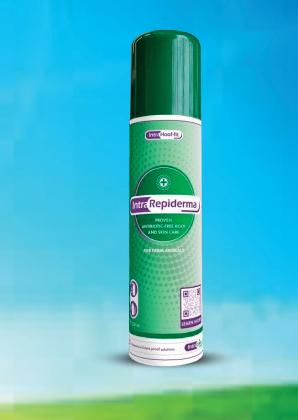

Muller is by nature a bell weather for liquid milk prices and its move has seen many other milk buyers for liquid se le April prices anywhere from 41ppl to 42ppl.
Meadow reduces 3ppl for April

JMeadow has reduced its supplier milk price by a further 3ppl from April.


The company reports that the market remains under considerable pressure, with the contraction in the values continuing to see high production volumes along with a reduction in demand from consumers both in


















the UK and globally. This latest decrease brings the company’s total reduction tally for the year to date to 10ppl and takes our liquid standard litre down to 38ppl across all the company’s regional milk pools. Our manufacturing standard also decreases by 3ppl to 38.63ppl.

Call Andy Berry about “Crypt-Occur” 07969 164 066 www.berrysagriculture.co.uk Maintaining Calf Health auctionfinder.co.uk Your one stop shop for all agricultural sales Search by sale type, mart, auctioneer or region Follow us on Facebook: www.facebook.com/bdsupplies SUPPLIERS OF HOOF TRIMMING AND ANIMAL HUSBANDRY EQUIPMENT PHONE OR ORDER ONLINE Tel: 01738 842996 www.bdsupplies.co.uk sales@bdsupplies.co.uk KVK Hoof Trimming Chutes 68 APRIL 2023
Milk price analyst
Stephen Bradley on the latest milk industry developments.
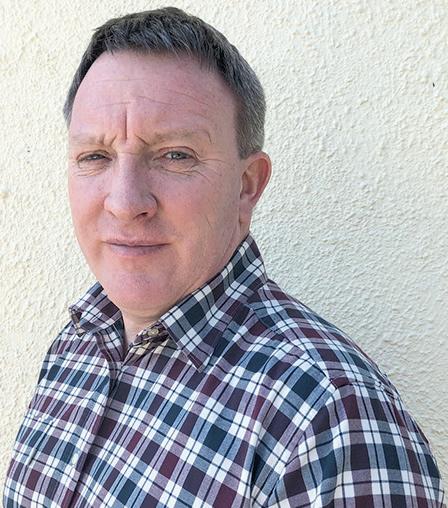
Retailers take prices down
JTesco has cut its Tesco Sustainable Dairy Group (TSDG) milk price for April in line with the Muller Direct milk price reduction to 42.5ppl.
Our Arla Direct Tesco supplier price moves down by the same to 42.25ppl. The retailer claims these prices are
now above the cost of milk production within the TSDG pool.
It adds that consumer demand remains pressurised due to inflation and difficult wider economic conditions, compounded by strong milk production through autumn and winter.
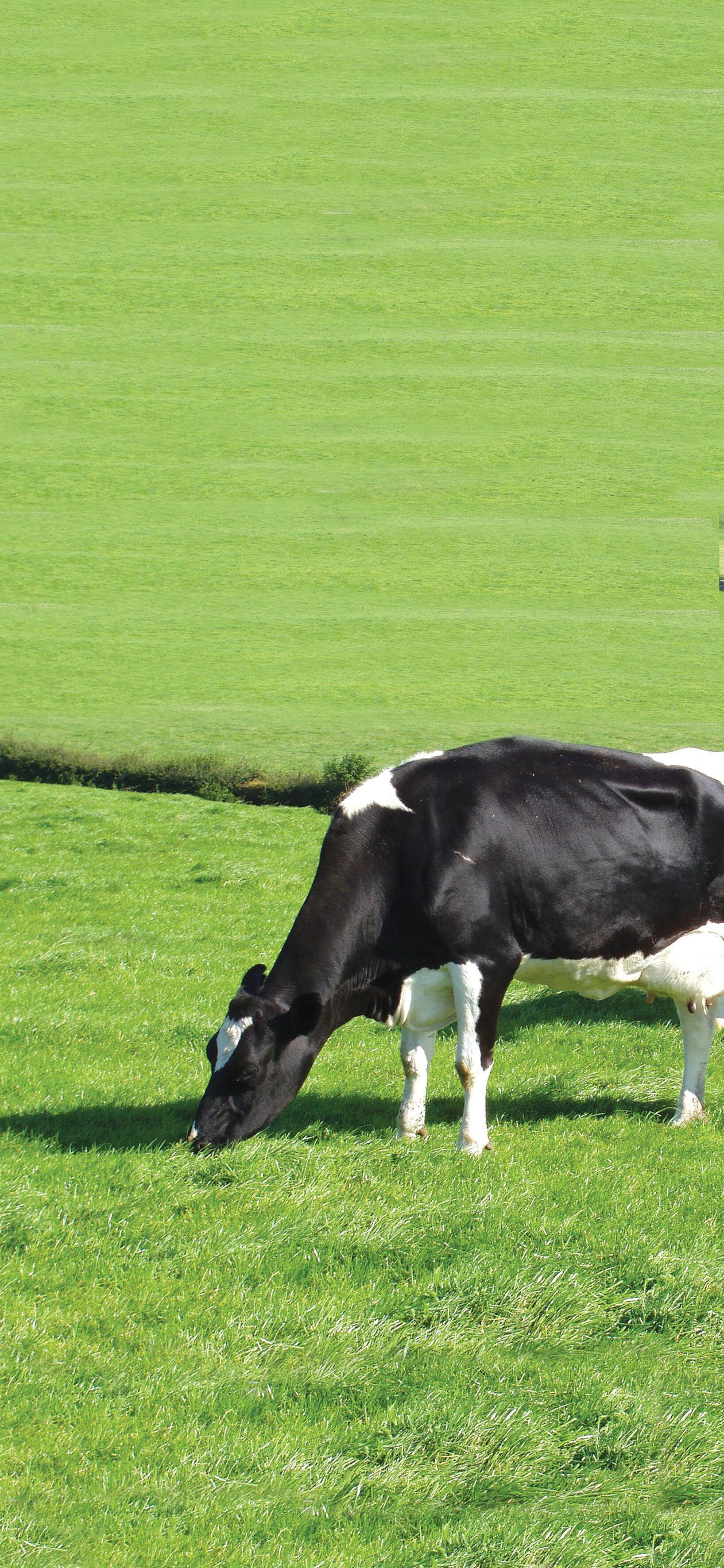
JTracking in line with its cost of production model, Sainsbury’s has reduced its Sainsbury’s Dairy Development Group (SDDG) milk price by a further 0.54ppl from April.
The decrease follows the penny cut from February and 2.06ppl from March, making a total reduction to date of 3.6ppl, and takes our liquid standard for our Muller supplier down to 43.9ppl.
Same level
Our Arla SDDG supplier receives the same level of decrease, pushing the price down to 43.78ppl after including the company’s 0.12ppl haulage charge.
Both prices include an




average bonus of 0.62ppl for herd health and efficiency.
As for the cost tracker itself, it now uses the 2022 actual farm data values to influence the forecast to April 2023.
The tracker update for April puts the cost of feed, fuel and fertiliser down by 0.7ppl to 20.47ppl. Other variable costs decreases by 0.06ppl to 7.21ppl and net overheads increase by 0.21ppl to 15.6ppl.
These changes put the total cost of production at 43.28ppl. Adding the 0.62ppl bonus matches the price of 43.9ppl.
The forecast puts the cost tracker as decreasing by 0.2ppl for May and by a further 0.3ppl for June.
*Our liquid standard litre is 4% butterfat and 3.3% protein, for our manufacturing 4.2% butterfat and 3.4% protein and, in both cases, Bactoscans of 30,000/ml and SCCs of 200,000/ml, with Thermodurics of 500/ml, 1m litres/year on EODC (max vehicle accessibility) based on level supply and therefore before seasonality (but includes the winter premiums paid in Northern Ireland), as well as monthly profile adjustments, balancing charges, capital deductions or annual/part annual growth incentive schemes or supplements not directly linked to dairy market price movement.

69 APRIL 2023
The first dairy compound range with SHEEP GROWER BEEF PLANET DAIRY PLANET PLANET PLANET REARING PLANET Successfully fed on farms since 2019 ZERO soya and palm kernel Contact Massey Harpers Feeds: Holmes Chapel: 01477 536300 Preston: 01772 206200 Holsworthy: 01409 254300 or scan: Fo cuse d on n utriti on Fo cuse d on n utriti on Reduce your carbon footprintwith
SDDG cost tracker down 0.54ppl
MILK PRICES
Notes to table
Prices for both Liquid & Manufacturing tables paid for a producer sending 1mltrs/yr on EODC (max vehicle size accessibility) with Bactoscans of 30,000/ml and SCC’s of 200,000/ml with Thermodurics of 500/ml. Excludes capital retentions or AHDB levies, profile adjustments from level supply, seasonality, balancing and A&B price schemes (includes the winter premiums paid in NI). Excludes annual / part annual growth incentive schemes or supplements not directly linked to dairy market price movement. Liquid price for milk contains 4% b/f and 3.3% protein. Manufacturing price for milk containing 4.2%/b/f and 3.4% prot. All prices for non-aligned prices are before monthly retail supplements. (i) Nov’22 prices before seasonality or B pricing (ii) Dec’22 prices before seasonality or B pricing (iii) Table ranked on simple rolling 12mth average of monthly prices Jan’22 to Dec’22). (i) v (ii) The difference Dec’22 compared with Nov’22. UK Arla Farmers 1.28ppl increase from Nov’22 includes the forecast 13th payment +1.24ppkg (+1.278ppl) based on our liquid std litre. UK Arla Farmers 1.33ppl increase for Nov’22 includes the forecast 13th payment +1.29ppkg (+1.329ppl) based on our manufacturing std litre. UK Arla Farmers 1.28ppl price hold for Dec’22 includes the forecast 13th payment +1.24ppkg (+1.278ppl) based on our liquid std litre. UK Arla Farmers hold for Dec’22 includes the forecast 13th payment +1.29ppkg (+1.329ppl) based on our manufacturing std litre. First Milk price includes 0.5ppl Member Premium accrued as a 13th payment paid Apr’23. First Milk Haverfordwest Tesco Cheese Group includes 2ppl retailer premium averaged as 1.5ppl based on seasonal profile. Fresh Milk Company price before Morrisons monthly cheese supplement (last payment made in Dec’22 of 0.072ppl for Jul’22 to Dec’22 period). MMG Direct price includes 1ppl Premium paid annually in arrears to Direct/Organic farms meeting specific Müller Direct criteria (Quartely payments from Apr’22).Crediton Dairy price includes FarmMetrics Scheme Bonus of 0.5ppl paid monthly. South Caernarfon price includes flat 0.7ppl annual member bonus. ‡ Price includes 12mth average rolling profile fixed at 0.57ppl. * UK Milk Futures Equivalent (UKMFE) net to producer includes 5% processor margin and allowing 2.67ppl ex-farm haulage + milk testing. ** Ave delivered spot milk net to producer allows 3ppl covering haulage + milk testing and margin. (iv) Latest confirmed milk price at the time of going to press. N/C in this context means no change made aware since Dec’22. UK Arla Farmers 1.13ppl decrease from Jan’23 includes the forecast 13th payment reducing from +1.24ppkg (+1.278ppl) to 1.23ppkg (1.267ppl) based on our liquid std litre. UK Arla Farmers 1.12ppl decrease for Jan’23 includes the forecast 13th payment reducing from +1.29ppkg (+1.329ppl) to 1.28ppkg (1.318ppl) based on our manufacturing std litre. UK Arla Farmers 2.54ppl decrease from Feb’23 includes forecast 13th payment holding on 1.23ppkg (1.267ppl) based on our liquid std litre. UK Arla Farmers 2.65ppl decrease for Feb’23 includes forecast 13th payment holding on 1.28ppkg (1.318ppl) based on our manufacturing std litre. UK Arla Farmers 3.39ppl decrease from Mar’23 includes forecast 13th payment holding on 1.23ppkg (1.267ppl) based on our liquid std litre. UK Arla Farmers 3.52ppl decrease for Mar’23 includes forecast 13th payment holding
70 APRIL 2023
on 1.28ppkg (1.318ppl) based on our manufacturing std litre. MMG Direct Premium for Direct/Organic farms meeting specific Müller Direct criteria confirmed as 1ppl for 2022 and paid quarterly, Apr’22, Jul’22, Oct’22 & Jan’23. All prices (excluding First Milk Haverfordwest Tesco at 1.50ppl) are before monthly retail supplements. Milkprices.com cannot take any responsibility for losses arising. Copyright: Milkprices.com Nov’22 Dec’22 12mth Diff Latest 4.0/3.3 4.0/3.3 Ave Dec’22 Confirmed Before Before Jan’22 v Milk Seas’lty Seas’lty Dec’22 Nov’22 Price LIQUID PRICES (4% b/f & 3.3% prot) (i) (ii) (iii) (i) v (ii) (iv) UK Arla Farmers – Morrisons (Grazing) 51.86 51.86 45.60 N/C 47.99 UK Arla Farmers – Tesco 51.66 51.66 45.57 N/C 48.19 UK Arla Farmers – Morrisons 51.63 51.63 45.37 N/C 47.96 Müller Milk Group – M&S 51.38 51.38 44.96 N/C 52.66 Dale Farm NI 51.02 51.02 44.66 N/C 50.02 UK Arla Farmers 50.24 50.24 44.15 N/C 46.57 Müller Milk Group – Waitrose 50.00 50.00 44.05 N/C 50.00 Dale Farm GB (Kendal) 48.95 48.95 42.46 N/C 48.70 Crediton Dairy 48.00 48.50 42.38 0.50 45.00 Freshways 50.00 50.00 42.33 N/C 44.00 Yew Tree Dairy 48.00 48.00 42.17 N/C 43.75 Paynes Farms Dairies 48.00 48.00 42.17 N/C 47.00 Müller Milk Group – Tesco 48.00 48.00 42.16 N/C 47.00 Meadow Foods Lakes 48.00 48.00 42.06 N/C 44.15 Meadow Foods 48.00 48.00 42.06 N/C 45.50 Müller Milk Group – The Co-op Dairy Group 47.67 47.83 41.96 0.16 45.50 Müller Milk Group – Müller Direct 48.00 48.00 41.92 N/C 44.00 Arla Foods – Tesco 47.75 47.75 41.91 N/C 44.44 Müller Milk Group – Sainsbury’s 47.00 47.50 41.72 0.50 44.00 Müller Milk Group – Müller Direct (Scotland) 47.79 47.79 41.71 N/C 44.32 Blackmore Vale Dairy 48.00 48.00 41.66 N/C 45.50 Arla Foods – Sainsbury’s 46.88 47.38 41.60 0.50 43.79 Grahams Dairies 46.00 46.00 40.79 N/C 44.00 Simple Average 48.86 48.93 42.84 0.07 Simple Average (excl. retail contracts) 48.46 48.50 42.35 0.04 MANUFACTURING PRICES (4.2% b/f & 3.4% prot) UK Arla Farmers 52.24 52.24 45.91 N/C 48.47 Dale Farm NI 51.91 51.91 45.53 N/C 50.91 Wensleydale Dairy Products 50.52 50.52 44.35 N/C 40.90 Parkham Farms Tesco 50.90 50.90 44.30 N/C 44.06 The Fresh Milk Company – Level Profile ‡ 50.69 50.69 44.24 N/C 49.27 First Milk – Haverfordwest Tesco Cheese Group 51.19 51.19 43.98 N/C 47.19 Wyke Farms 50.12 50.12 43.68 N/C 46.11 The Fresh Milk Company (Lactalis) 50.12 50.12 43.67 N/C 43.49 Barber’s Cheesemakers 50.02 50.02 43.63 N/C 50.12 Saputo Dairy UK – Davidstow 49.50 49.50 43.33 N/C 46.50 South Caernarfon 50.00 50.00 42.94 N/C 44.00 Glanbia – Llangefni (Constituent) 49.25 49.25 42.71 N/C 43.25 First Milk 49.69 49.69 42.48 N/C 45.69 Belton Farm 48.55 48.55 42.40 N/C 44.05 Arla Foods – Direct Manufacturing 48.32 49.70 42.25 1.38 48.58 Simple Average 50.20 50.29 43.69 0.09 Simple Average (excl. retail contracts) 50.07 50.18 43.62 0.11 ‘B’ Price Indicators StoneXMilkprices.com UKMFE (gross) 41.90 41.50 49.86 -0.40 *StoneXMilkprices.com UKMFE (net) 37.18 36.76 44.81 -0.42 **Delivered spot milk (net to the producer) 42.52 36.12 -6.40 Latest
milk prices from





From Dairy cattle, Milking parlours, calving equipment and everything in between, you’re sure to find what you need on FGBuyandSell.com. Start listing your items FREE today! Browse. Sell. Buy at FGBuyandSell.com Brought to you by Farmers Guardian, FGBuyandSell is the platform for you to sell your items to a responsive farming community.
CROSS VENTILATION

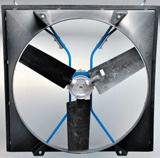
Commodity prices struggling
Commodity prices are still struggling to gain any traction, with few positive factors which manufacturers can seize on to leverage prices.
Milk volumes are still strong and sentiment is at – epitomised by the GDT auction results

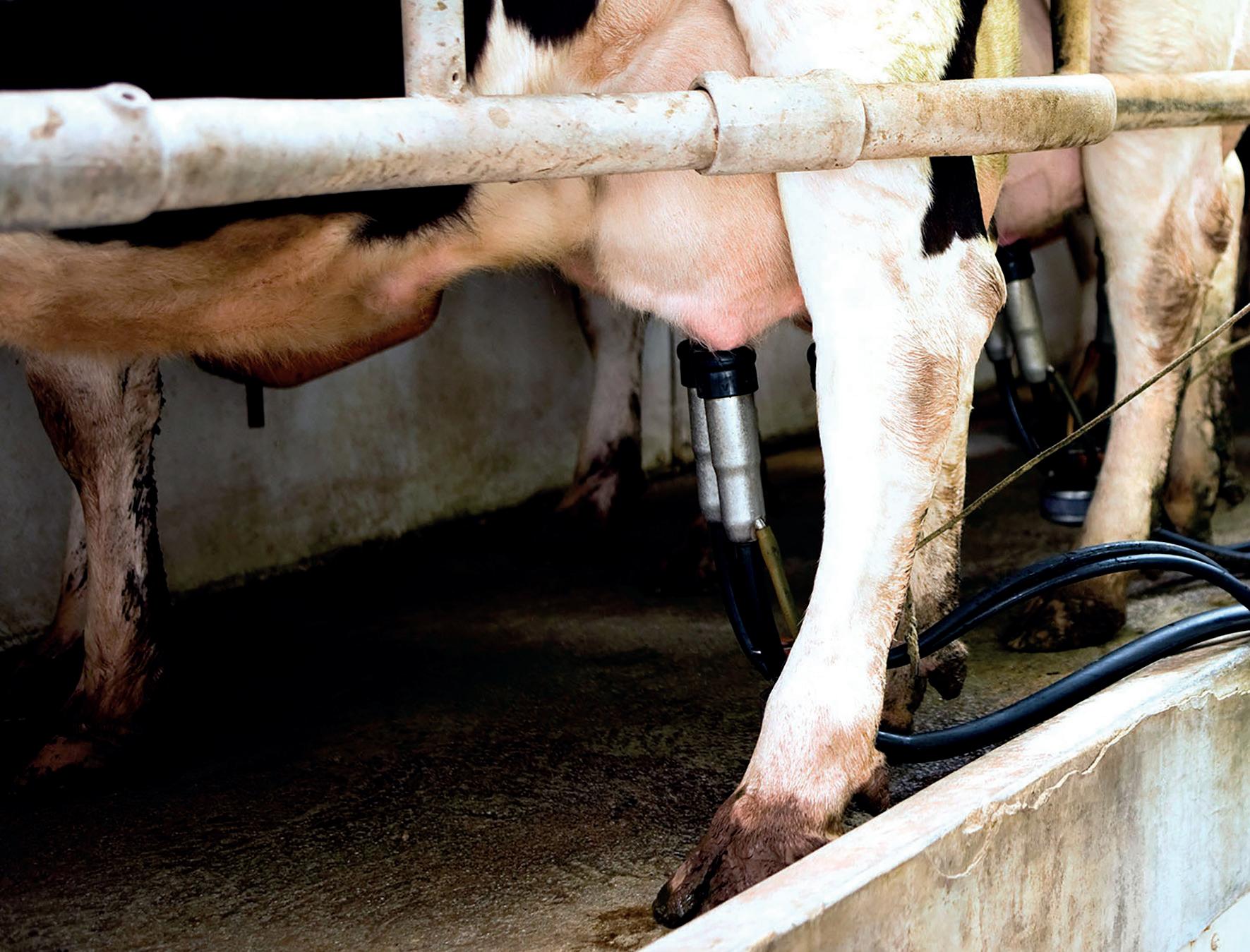

While there have been some useful increases in both the physical and futures bu er and SMP, the gains have been fragile, with some of the gains o set by falls as buyers
ful l their needs and step back from the market again.
Currently in the UK, the average bu er price is about £4,150/tonne with SMP at £2,250/t.
Estimation
Together the pair convert into a milk price of about 30ppl a er costs, so commodity prices have to increase signi cantly in order to pay a 42ppl milk price, which is where costs are estimated to be. Bu er has to be more than £5,000/t and SMP over £3,000/t, for example.
Defra price falls below 50ppl again
JDefra has dropped its milk price for January for the first time since early 2021, with the price increasing every month from June 2021, when it was just over 30ppl.
It peaked at 51.51ppl in December 2022, at 4.38% fat and 3.47% protein, but price cuts and a drop in milk quality have both contributed to a drop to 49.2ppl for January 2023.
At typical fat and protein valuations, it equates to about 47ppl on a standard 4% fat and 3.3% protein litre.
Since then though, milk prices have tumbled. In February, there were 13 price reductions, in March another
21 and, so far, 14 have been announced for April. More will follow. It takes the average non-aligned standard litre price down to less than 42ppl for April.
The latest AMPE figure for
UK cream has increased marginally and is now trading for about £1.62/kg, with the price continuing to be volatile in an uncertain market. It is well down on EU cream, however, which is equivalent to about £1.88/kg in UK terms.
Mild Cheddar is at £3,600/t, which continues to decline a er some volatile weeks where the price has plummeted by more than £1,000/t, while mature Cheddar is at £4,100/t – again down over £1,000. ese prices convert into a milk price in the mid-30p level.
February is 33.47ppl, which is down 1.62p on January, which equates to a milk price of about 31.5p. MCVE is at 39.5p, down almost 5p to a price in the mid-30p zone.

Defra farmgate price vs. AMPE price after costs
72 APRIL 2023 www.abbi-aerotech.com www.rumitechs.co.uk Ph: 07714 846987
The climate in the barn is the key! NEW! NEW! DC-permanent magnetic motor 40-70% energy savings No frequency control needed No motor protection switch needed No special wiring needed No maintenance Mains: 230/400V 50Hz Simpler installation Less electric wiring No obstacles inside No restlessness when doing maintenance Shorter suspension of the fans Lower total investment Airflow in length of cubicles THE SOLUTION: ABBIFAN 140-XXP-2 The latest motor technology now applied on our fans! Direct drive.
HEATSTRESS?
blows fresh outside air in your barn!
Jan 18 Mar May Jul Sep Nov Jan 19 Mar May Jul Sep Nov Jan 20 Mar May Jul Sep Nov Jan 21 Mar May Jul Sep Nov Jan 22 Mar May Jul Sep Nov Jan 23 Mar May Note: Based on 4% fat and 3.3% protein including lag 60 50 40 30 20 10 0 Defra farmgate price (including lag) AMPE after costs
Future price trends expressed as a milk price
UK milk volumes
JUK milk volumes over the last two weeks have averaged 40.75 million litres per day, some 1.8m litres and 4.37% more than last year and some 3.63% more than the long-term average.
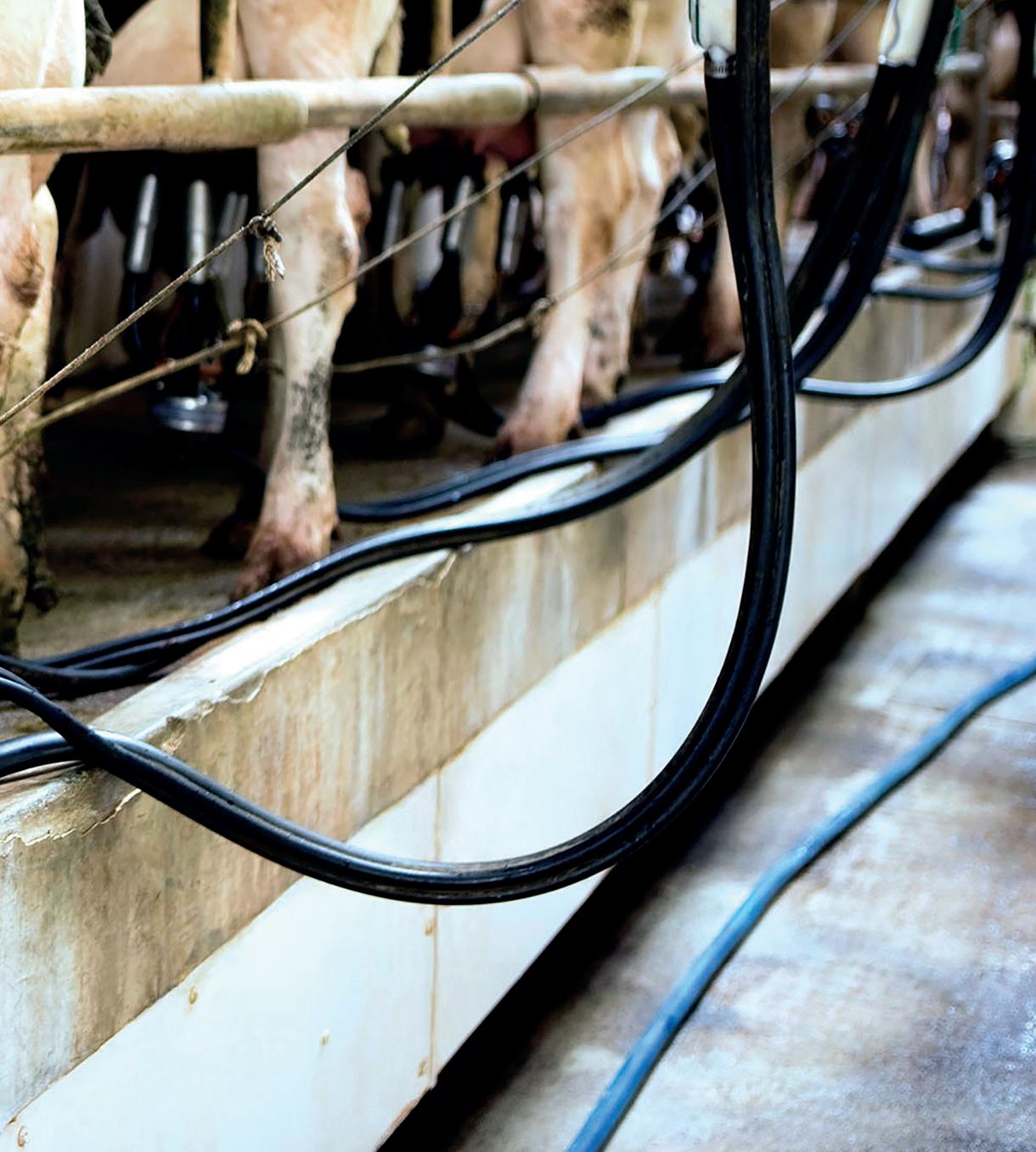
GB milk volumes over the last two weeks have averaged 35.15m litres per day, 1.8m litres and 5.5% more than last year and 3.27% more than the long-term average.
The latest milk volume data allows an assessment of the first 50 days production for 2023, with the total milk
produced in the UK over the last 50 days from January 13 to Mar 4 being 2,057m litres, which is 47m litres and 2.3% more than last year.
Volumes
In GB over the last 50 days, volumes have been 1,700m litres, which is 52m litres and 3.1% more than last year. This year we topped two billion litres for the year on February 20, while last year it took another five days to cross the threshold.
Futures on a slow rising plane to Q4
JThe futures prices are on a rising plane through Q2 and Q3, but not enough to propel milk prices into breakeven territory.
Currently EU and New Zealand prices convert to a milk price equivalent of 33-34ppl, with prices not peaking until August.
The outlook is better than it was at the end of January, however, when the prices converted into a milk price less than 30ppl.
EU butter futures have increased by 14% since early February, with Q3 contracts at or over €5,000 (£4,412) again.
Tub Grinders
- Exclusive UK Distributor of Haybuster & Rotogrind Grinders.
- Range of models from 5t - 25t / hour output.
- New, used & refurbished machines available.
- Ideal for straw, hay, green waste, roots, biogas feeds etc.




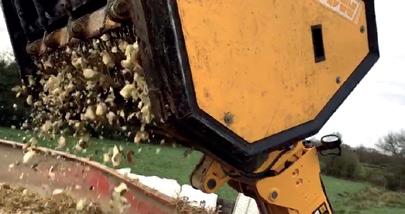
Root Choppers & Cleaners
- Loader, 3 point linkage, free standing PTO and electric drive available
- UK Distributor of VDW range of choppers, cleaners & feed dispensing equipment


- Output from 10t/hour to over 120t/hour available
Diet Feeders
- Largest stock of mixers in the UK - over 50 ma chines in current stock
- Refurbished, used & nearly new units available
- New Mini Mixer available
- Diet feeder parts available- Blades, Conveyor belts, gearboxes, weigh cells.


- All feeders undergo 30 point service
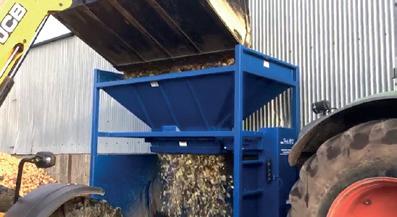
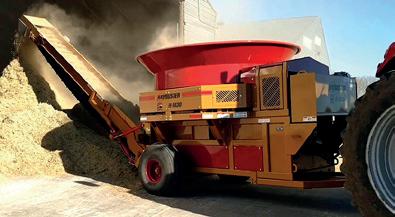

- Finance available subject to terms


- Nationwide delivery available
Current Used Stock:
-
Trioliet 16, 20 x 2
- Strautmann 12, 20, 27
- BvL 10, 20, 27

- Kuhn 14, 27
- Siloking 14 duo
- Shelbourne 11, 13, 16, 19 -










-
Hi Spec 20
Redrock 14
- Profi Root chopper x 2
- VdW RS Root chopper - Farmhand Tub Grinder
73 MILK ANALYSIS APRIL 2023 Would you like to increase your milking efficiency? 0750 841 7698 Discover how a Supa4 milking system, featuring entry-level automation, is capable of maximising your throughput with minimum effort and less labour - to increase your milking efficiency. Hurricane Slugwash System Faster Milking Greater Efficiences Powerful Cleaning Electronic pulsation system waikatomilking.com Growing the value of dairy Feed Processing Specialists Please visit www.enegis.co.uk for more photos or call 01789 205132 or 07721 442979
May Apr May Jun Jul Aug Note: Including transport, processor margin and cost allowance 36 34 32 30 28 EU futures NZ futures
NEWProducts
This month, we feature an update to the Tractor GPS guidance system, improvements to MSD’s teat sealant range and new clamp and bale cover options, plus boluses for pre- and post-calving cows and heifers.
Tractor GPS system update
JFamily-owned Tractor GPS has launched a new, improved accuracy model to its range of guidance systems.
This latest model uses a seven-inch screen with a magnetic roof-mounted exterior antenna to guide the user when driving and spreading fertiliser, slurry, spraying ,mowing or tedding and so on.
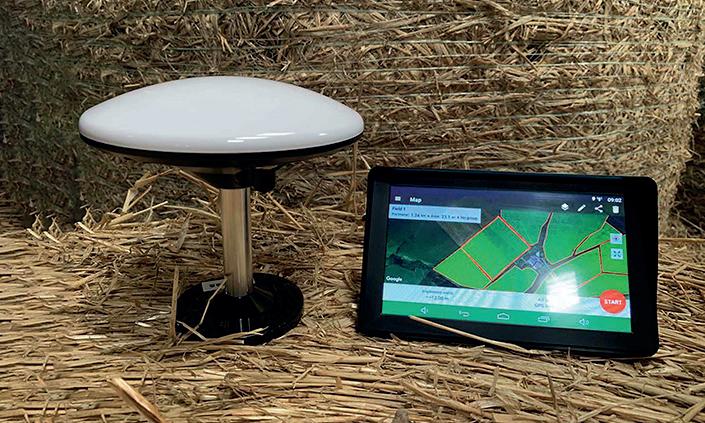
A to B lines can be plotted with arrow/visual guidance of steering adjustments as well as a visual ‘colouring in’ effect on-screen.
The system retails at £399.99 plus postage costs.
Newer fodder beet varieties perform in trials
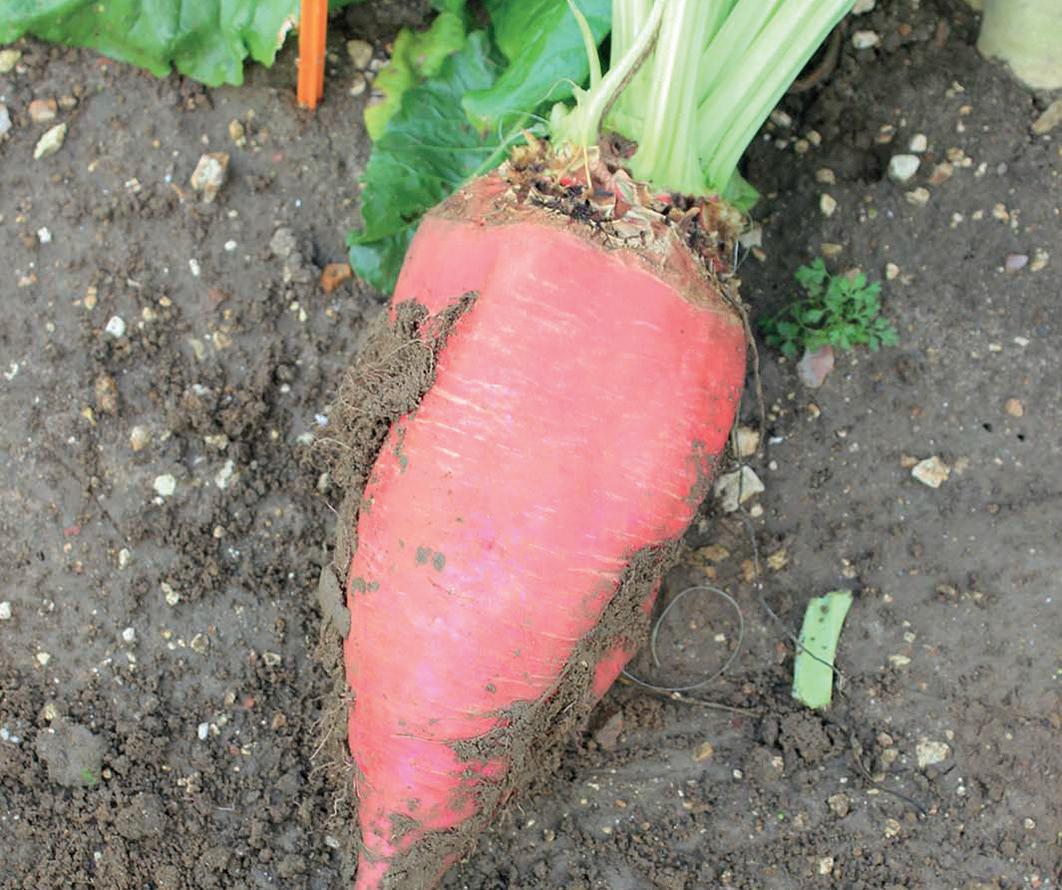
New trial data from Limagrain UK published in January 2023 shows that newer fodder beet varieties are raising the benchmark for dry matter (DM) yields and the crop’s ability to produce consistently high yields in varying seasonal growing conditions seen in the UK in recent years.
Limagrain UK has run trials on its Lincolnshire site since 2008 and compared the performance of commercially available varieties of fodder beet.
In the latest ranking, the new variety Fosyma has an average DM yield of 14% above the control variety Magnum, equivalent to more than 2.5 tonnes of DM per hectare (1t DM/acre). Fosyma has been included in the trials since 2019 and has been available to UK growers for the past two years.
Got a new product?
JNew products are featured in each issue of Dairy Farmer. Please send details and pictures to Hannah Morgan at hannah. morgan@agriconnect.com, or call 07824 498 702.
High-yielding and rhizomaniatolerant variety Brick is in second place, with a DM yield 9% above the control and a DM content of 22.8%. It is slightly deeper rooted than Fosyma,
with 25% of the root out of the ground. A more established variety which has held its popularity in livestock diets is Robbos, due to its flexibility and high yields.
Boluses for pre- and post-calving cows and heifers
JNettex has added EnduraBol Pre-Calver and EnduraBol High Iodine to its EnduraBol Cattle bolus range.
EnduraBol Pre-Calver consists of two boluses which provide a sustained release of six trace elements and three vitamins for up to 120 days. Nutrients include high levels of copper,
zinc, iodine, cobalt, selenium, manganese and vitamins A, D3 and E. EnduraBol High Iodine is recommended for cattle on primarily forage diets, especially those consuming brassicas and legumes. Also consisting of two boluses, EnduraBol High Iodine contains high levels of copper, zinc, cobalt, selenium,
manganese and vitamins A, D3 and E and has an average daily supply of 17.6mg of iodine to overcome likely deficiencies.
EnduraBol boluses should be administered at least six weeks before calving using the EnduraBol gun.
Each pack contains 20 boluses to supply 10 cows.
74 APRIL 2023
Fosyma has been included in the trials since 2019.
Teat sealant range improvements



JMSD Animal Health UK has announced updates to application and use for the teat sealant Cepralock.


New features include a shorter plunger distance and reduced air space within the tube, while its packaging also includes biodegradable disinfectant wipes for teat preparation.
The ergonomic, dual-tip

syringe gives farmers the flexibility to choose between a short or long tip insertion, meaning damage to the teat end during application is less likely when using either the short or long tip. The active ingredient within the teat sealant remains the same.


rMore information from local MSD Animal Health UK account managers.


Clamp and bale cover options
JNew from Kelvin Cave, ClampShield 500 and BaleShield 160 have been developed to give a high degree of protection to clamped or baled forage while cutting the need for single-use plastic.
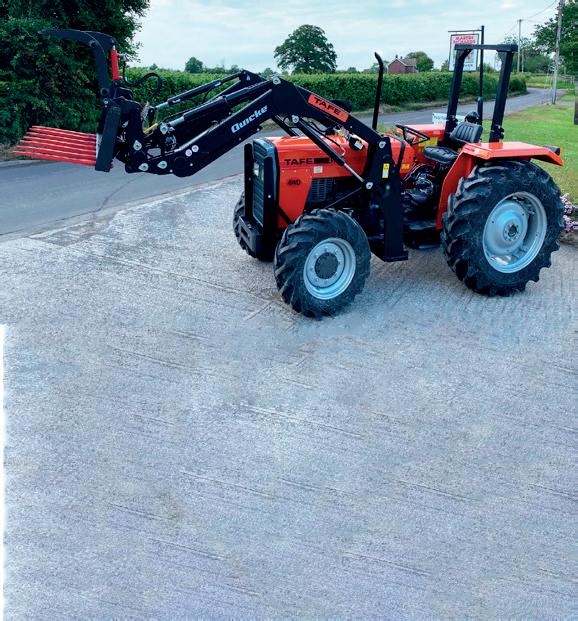
The most robust of the range is ClampShield 500, designed for use across silage clamps immediately on top of a low air-ingress vacuum film.
With a weight of 500g/sq.m, the cover is said to stay in place with less weighting than typically used. It comprises a water-repellent, durable polypropylene fleece and up to 15 years of UV resistance.

The product is available in a range of sizes and is supplied with hook and loop tape to securely link two sheets











together and cover any shape and size of clamp.
The BaleShield 160 version of the product is of the same construction, but its lower gauge is more suited to covering stacks of hay or straw, or even wrapped bales where bird damage is a problem.

Both water-repellent and breathable, BaleShield 160 is ideally used on stacked bales in a pyramid formation and on pallets to provide all-round air circulation.
BaleShield 160 can be secured using one of a range of accessories, designed for easy access at feedout.
rMore information from Kelvin Cave on 01458 252 281, or Michael Carpenter on 07817 977 701.
75 NEW PRODUCTS APRIL 2023
Want a system that makes milking and cleaning easier? Find out from our local experts how the Supa4 milks faster and more efficiently, and includes a powerful Hurricane Slugwash System and an AutoWash function to maximise cleaning efficiency and hygiene. Hurricane Slugwash System Stable milking vacuum Highest levels of hygiene A simple, easy to use system waikatomilking.com Growing the value of dairy 0750 841 7698 TALK TO OUR TEAM TODAY DEEP GROOVES FOR SOLID FLOORS SLAT GROOVES DIAMOND CUT Call us on 01258 817372 email: info@tractorsuk.co.uk TRACTORS UK SOLE UK IMPORTER OF TAFE TRACTORS FROM THE BEST PEDIGREE BASIC, SIMPLE & RELIABLE TRIED & TESTED FOR GENERATIONS 08R04B � Drum or oil immersed brakes � Roll bar or cab � 2wd or 4wd � 2 Years’ warranty � Comprehensive parts backup www.tractorsuk.co.uk ✆ 01258 817372 ✉ info@tractorsuk.co.uk BASIC, SIMPLE & RELIABLE www.tractorsuk.co.uk • • 2 Years’ warranty Comprehensive parts backup • • Oil immersed brakes 2WD or 4WD
V Mix 33 3S Steering axle, 2 front doors, 600 mm elevator, rear door, app based weighing, stainless liner, mudguards, work & rear lights

V Mix 22 2S Tandem Steering, non DHF, 435/50R19.5 tyres, front RHS door, 1000 mm elevator, LHS door with chute, RGB, App based weighing, HD lighting, 18 mm augers

V Mix 20 2S, non HDF, RGB, 435/50R19.5 tyres, 18 mm augers, HD lights, 2 front doors, 600 mm elevator, chute, mudguards, work light

V Mix 15 2S, front R H S door, hydraulic down to up chute, 435/50R19.5 tyres, App based weighing, 18 mm augers, RGB
V Mix 12 1S, RHS door, chute, 400/60R15.5 tyres, app based weighing, manual parking jack
V Mix 10H 1 S, 400/60x15.5, RHS door & chute, weighing, front window, 18 mm auger

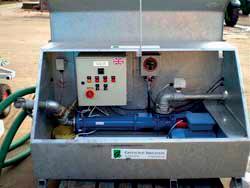



For more information, please contact either: North: Paul McUrich - 07810 040100 paulmcurich@gmail.com
South: John Molton - 07947 719985 john.molton@bvl-group.de www.bvl-farmtechnology.com
DAIRY FARMER




Building Services





SPRAY
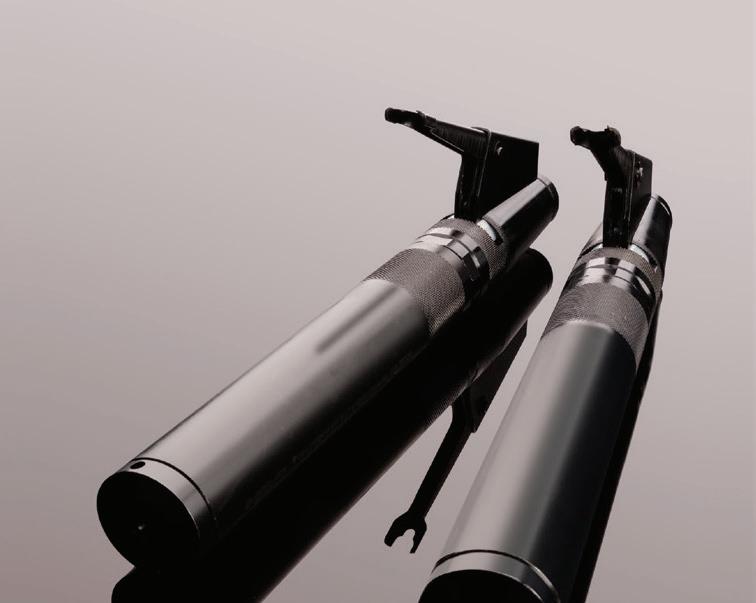
Delaval mobile milking bale for hire/sale. Delaval Blue Diamond 32/32 fast exit MM25s. Save energy, Ice Builders : Bulk Milk Tanks. Heavy duty replacement troughs for most parlours. Delaval VMS Robots : Milk meters, keypads, feeders etc. Everything for the Dairy Farmer Call Vic/Tracey Brown Tel: 01260 226261 www.milkingequipment.com Milking Equipment 76 APRIL 2023 Equipment & Accessories SEPCOM The unique separator Slurry pumps & lagoon mixers 01328 701992 | enquiries@greencrop.co.uk | www.greencrop.co.uk Multicam dirty water irrigator Slurry pump Pump in a box DAIRY FARMER CLASSIFIED TELEPHONE: 01772 799400 Livestock 1 8m x 1 2m / 6ft x 4ft Each 30kg Per Mat Easy Grip Handles Animal Proof Weather Resistant 100% Rubber Construction R U B B E R S Y S T E M S F O R A G R I C U L T U R E DAIRY MAT ARK www arkmat co uk C a l l o r E m a i l F o r P r i c i n g A n d F u r t h e r D e t a i l s 01392 209 394 info@ark-rubberandresin co uk PARLOUR MATTING HEAVY DUTY SILAGE PIT MATS SUPERSOFT CUBICLE MATS ALLEY MATS 5 YEAR GUARANTEE Tel: 01635 253344 Email: sales@raytradeuk.co.uk Web: www.raytradeuk.co.uk
FOAM INSULATION To Crop & Livestock Stores, Poultry Sheds, Cattle & Pig Buildings, Workshops & Barns. Frost & Condensation Protection. Temperature Control Energy Saving Tel: 01405 812682 www.webstersinsulation.com info@webstersinsulation.com Over 40 years of V-MIX development
and display diet feeders for immediate delivery
Ex-demo
Dairy Farmer 9x1 Spring 22.qxp_Layout
PROBLEMS WITH HIGH SCC /MASTITIS? - WANT TO REDUCE USE OF ANTIBIOTICS? - COST EFFECTIVE PRODUCTS WITH EASY WATER TROUGH ADMINISTRATION - DISCOUNTS - WE CAN HELP WITH SHEEP PROBLEMS TOO - CALL FOR A FREE SAMPLE KIT
T 01756 749444 W www.crossgateshealth.co.uk


Business Development Manager
Agriconnect is a business unit within the Arc network, a global events, data, and media platform. Arc is a fast-growing global events, data, and media platform with a varied portfolio content led portals, magazines, and events. Agriconnect’s mission is to empower, inspire, and connect people and business in agriculture by creating trusted content and connections that help the industry thrive.
Since 1844, the brands of Agriconnect have been the trusted source of information for farmers and with brands like Farmers Guardian, events, like LAMMA and Farm Business Innovation, and digital platforms, like FG Insights, Agriconnect continues to bring together the British farming community.

THE ROLE:
• We are now looking for a motivated and driven salesperson to join our Sales team.
• The main function of the role is to develop business through growth in revenue, yield, and to increase customer numbers. You will be required to identify new opportunities and influence companies’ media buying habits within the agricultural sector. Due to the ever-changing nature of the industry, this person will have the ability to spot new avenues and exploit market trends.
• Hours: 35 hours per week – Mon – Fri
• Location: Preston – temporary hybrid remote
• Salary: Competitive, dependant on experience.
SKILLS & EXPERIENCE:
• Own, support and fully develop specific market sectors
• Conduct sales presentations by telephone, email or face to face to existing and prospective clients in order to develop existing business and generate new business wherever possible.
• Advise existing and new customers on the most effective solution to meet client needs within the Agriconnect portfolio.
• Continually seek and develop new sales & opportunities.
• Ability to accurately forecast future sales
• Keep abreast of all current trends, activities and relevant news within agriculture and specific sector



• An interest in agriculture
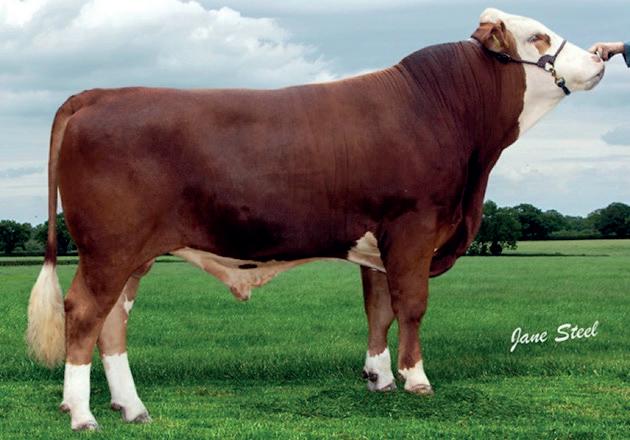
• Highly motivated & driven, with an ability to meet ambitious performance goals
• Be enthusiastic and motivated to continually explore new opportunities, whilst possessing a natural inquisitive nature
• Excellent communication written and interpersonal skills
We offer an excellent package including:

• A competitive basic salary
• 25 days holiday increasing to 27 after two years
• An extra day off on your birthday
• Free life assurance
• Contributory pension scheme
• Employee assistance programme
Arc has ambitious plans for growth, and this is an opportunity to be part of our continuing success story whilst enjoying a fabulous work/ life balance.
We strive to create a culture that is open and respectful, where differences are valued and celebrated. We want everyone to be able to reach their full potential, so we are committed to cultivating a company that promotes inclusion and belonging.
To apply for this role, please email amber.tabiner@agriconnect.com
77 APRIL 2023
Recruitment Livestock
HEALTH SOLUTIONS
Livestock Services
FARM
Ask about Herd Health Analysis
APPLE CIDER VINEGAR (ACV) Nationwide (01948) 662910/663143 george@greenfieldsrise.f9.co.uk HACKI 30 STRAWS £200 Tel: Jim Hamilton 07590 444732 visit our website www.fleckviehgenetics.com Semen Stored UK Sires WHILE STOCK LASTS Stop Press 5th April Carlisle Fleckvieh Super Sires 10 Elite Genomic Bulls From Austria Milk +946 FAT +0.01 Pr0 - 0.03 Excellent udders 119 DAM - 15,000 LTR EX COW S.Q FLECKVIEH SPRING SPECIAL
GOODEvans ‘We leave it in better heart than when we took it’
This month, Roger Evans discusses how his farm business has adapted to the unknowns which come with renting land and also gives his advice on buying second-hand cars at online auctions.
Iusually tell you about the things I get wrong. Over the years, readers have identified with this. Dairy farmers don’t see themselves in some sort of pristine world. They sometimes see themselves in the real world where things can, and do, go wrong.
But today I am going to break with tradition and tell you about something I got right. For 20 years now we have rented most of the land we farm on a Farm Business Tenancy.
This land has been fundamental to what we do. We have milked our cows here at home, but all their silage has been made on the rented land. When grazing became tight at home we have been able to augment it with zero grazing, again from the rented land.
Throughout those years we have resisted temptation to put up new buildings at home to fit a scenario where we had no security of tenure.
It’s true that when we acquired this land we put in a new parlour. Just as grass came home, muck went the other way, so we put up a shed which was designed to loose house 50 cows on straw beds.
This didn’t work out for reasons of mastitis and we used half of it to house bulling heifers and half to house cubicle refusers and calve cows. But we badly needed a new silage pit, a slurry lagoon and better milking cow accommodation.
There was some pressure as well from officialdom to spend all that money, but we knew that at anytime we could get 12 months’ notice. That notice has become reality and we lose this land at the end of March.
The cows had to go last spring. They were clear of TB and what we have left is most viable as a conventional dairy unit. So the new sheds were not needed and probably never will be.
As the nation makes its headlong rush to plant trees, I suspect our story will be a common one.
This land starts about a mile away and it was my favourite of places. The views were panoramic and spectacular. I have often asked the contractors and employees who worked there if they would forgo payment in exchange for the view. They have always passed on that.
I liked it so much that I used to go up there every day, several times a day if we were busy. Now I go there about once a month. It’s not the same when you know you are not welcome.
I could drive most of it and used to let my terrier out for a run. That doesn’t happen now and he looks like a barrel with a leg at each corner.
What I do know is that much of this land had been in continuous cereals for more than 30 years and we leave it in better heart than when we took it.
What I am about to say is not something I am advocating. I don’t think you should do this, it’s just what I do.
Excitement
Last spring I bought a car. I’d bought and paid for it, although I’d never seen it. It’s probably the third or fourth car I’ve bought like this. It brings a degree of excitement to your life.
The trick is that if you buy a car like that, don’t spend all your money, keep some in reserve in case you get it wrong. As it surely will eventually.
I’m not going to tell you how much I paid for this car, but I will tell you that I bought a new lawnmower last year and that cost more, quite a lot more.
One of the key factors to buying a car like this is the length of the MOT on it. The car I bought in spring last year had nine months MOT on it which ran out just before Christmas. So I put it in for MOT three weeks early. I didn’t want to spend much money on it, so if it failed I had a chance to buy another.
78 APRIL 2023
I had mixed feeling about this MOT. I quite liked the car, so most of me wanted it to pass, but I must confess there was a bit of me that wanted it to fail so I could go out and buy another online. As it happens it passed, so with a bit of luck, I will have it for another year.
I don’t go far now and the family think I should have something a bit smaller, but I’ve always liked big old cars.

Viewings

e only tip I can give you is to look at how many viewings the car has had and how many bids. is car I have now had had 12 viewings which had led to 10 bids.
It seemed reasonable to assume that the people that had viewed it and then bid on it knew more about cars than I did, so I used their con dence to bolster mine.
When I go down to the rugby club I always leave the key in it. I am o en taken to task by my friends who say I am taking a bit of a chance, but I always say that if there is someone down there nicking cars, mine will be the last to go.
I got this joke from my son who used to do triathlons. He always used to amuse me – your average triathlon competitor wears a spandex cycling suit, a go faster streamlined helmet and rides a smart bike.
My son used to wear some old rugby shorts and whatever old rugby shirt that wasn’t in the wash. He kept his bike in the cubicles and only got it out the day before an event and put the hose over it to knock the cow muck and cobwebs o it.
He used to do quite well, if there were 150 competitors, and there o en were, he used to come in about halfway.
One of the last events he did was at Lake Bala in North Wales. He reckons the water in Bala is the coldest in the world.
I’ve never been to a proper triathlon, so I was asking lots of questions. One of these was: “When you are all out swimming and running do they have security to keep an eye on the bikes?”
It was then he said: “No, they don’t. But if someone’s there nicking bikes, mine will be the last to go.”
Browse, list and apply for hundreds of the latest roles at jobsinagriculture.com 79 APRIL 2023
“I have often asked the contractors and employees who worked there if they would forgo payment in exchange for the view
A drop in milk price, high costs of production and a persistently strong cull cow trade are having an impact of cow numbers. Cedric Porter looks at the trends.
March milk payments have brought home the scale of the cut in milk prices, with the impact starting to be felt in the sales ring.
Meg Elliott, auctioneer and valuer at Bagshaws in Leek, Staffordshire, says: “Up until the end of February prices were very strong, with milkers regularly making more than £3,000.
“But trade is starting to ease with the best now more likely to be in the £2,500-£3,000 region.
“Historically this is still strong, but indications are that there will be further price falls to come.”
She says that third-quality milkers were getting harder to sell, particularly if they are low-yielding heifers.
Unprecedented times
Mrs Elliott says: “We are now moving into unprecedented times where dairy trade is dipping away while the barren prices remain extremely strong, which will cause many vendors to question in which direction they should sell.
“In February at Bakewell Market, the very best black and white cows through the cull cow ring have grossed in excess of a mouth-watering £1,900. Admittedly, these are really meaty cows which have been fed. However, it emphasises the strength of the trade.”
Mrs Elliott says she expects the starkness of the reduction in March
Friesian farm, England (in ppl)
Cow numbers under pressure
and April milk payments will focus the mind of many producers and could be the final straw which persuades some to give up milking. There were 1.842 million dairy cows older than two years in the UK last June, according to the latest Defra survey.
That was 0.4% less than the year before and the smallest number since 2014. In contrast, the number of dairy cows between one and two years was at a five-year high of 568,755, 6.1% more than in June 2021 and similar to a peak in numbers in 2016.
There are other signs that producers were planning to increase the number of cattle, although only marginally. In the last three months of 2022, calf registrations were 0.6% or 2,200 more than the last quarter of 2021 at 355,620, according to British Cattle Movement Service. The total number was 0.9% more than the five-year average.
Over the whole of 2022, the number of births to dairy cows was up 0.1% to 930,000 head, which was 2.7% more than the five-year
average and the highest number for more than a decade.
Looking back can help to predict future cow numbers. The milk price peaked in 2014 at a then new high of 31.7ppl, Defra calculated.
A year later, it had plunged by 25%, but the number of two year-plus dairy cows and heifers continued to increase until 2016.
In the current price cycle, values peaked at the end of December at 51ppl and are fast heading to 40ppl, which would be 21% decline in a matter of a few short months.
There are no guarantees that prices will not fall below 40ppl.
Rise of costs
What has changed since 2014 is the rapid rise of costs to unprecedented levels which could limit production if costs mount.
Farm consultants Andersons estimate that average costs in the 2022/23 milk year hit 45.6ppl on its model English 200-cow, 130hectare (321-acre) Friesian Farm.
Senior consultant and partner at Andersons, Michael Haverty, says:
“Rising prices have helped maintain a margin for producers, despite costs increasing by more than 45%.
“We are still forecasting a small margin of 1.2ppl from milk production and other output in 2023/24 for our model farm, but some producers will see a loss.”
Andersons expects the average milk price to drop 14.9% to 40.2ppl in 2023/24, while costs may only slip by 8.3% to 41.8ppl.
The Basic Payment will help cushion the blow from lower milk prices, but it will fall by another 20% as the support is withdrawn to 1.2ppl.
In Scotland and Wales, payments will still be the equivalent of 1.8ppl as new support payments have yet to kick in.
Better profitability in the last year helped stem the flow of departing dairy farmers, but did not halt it.
In October 2022, there were 7,850 dairy farmers in England, Scotland and Wales, which was 1.9% or 150 lower than the year before.
In the year to October 2021, numbers fell by 310 or 3.7% and they were down 4.7% or 410 down
80 BUSINESS CLINIC APRIL 2023
2020/21 2021/22 % change 2022 % change 2023 2021-2022 2022-2023 Milk 28.5 32.5 +43.7 46.7 -13.9 40.2 Total output 30.8 35.6 +39.3 49.6 -13.3 43.0 Variable costs 13.3 14.4 +63.9 23.6 -16.1 19.8 Overheads 10 10.5 +42.9 15 +0.7 15.1 Rent, finance and drawings 6.4 6.5 +7.7 7 0 7 Total cost of production 29.7 31.3 +45.7 45.6 -8.3 41.8 Production margin 1.1 4.1 -2.4 4.0 -70 1.2 Basic Payment 1.9 1.8 -16.7 1.5 -20 1.2 Business surplus 3 5.9 -6.8 5.5 -56.4 2.4 Notes: 200-plus cows plus followers on 130 hectares (321 acres), part-rented, year-round calving, constituent contract with an owner and worker. Source: Andersons
in the year to October 2022. In the 25 years to 2020, the average annual reduction in herd numbers was 2.7%, with the number at more than 30,000 in 1995.
e really big milk price cuts of 4ppl-plus will not be seen in milk payments until March or April and they are likely to hit home.
Pa y Clayton, AHDB’s lead ana-

lyst for dairy, says: “Feed costs have come down from their peaks of last year, but they are still historically very high and some producers will have bought forward feed and fertiliser at higher prices than current values, so the drop in milk prices will hit hard.”

She adds a large spring ush could put further pressure on milk prices, especially at a time when

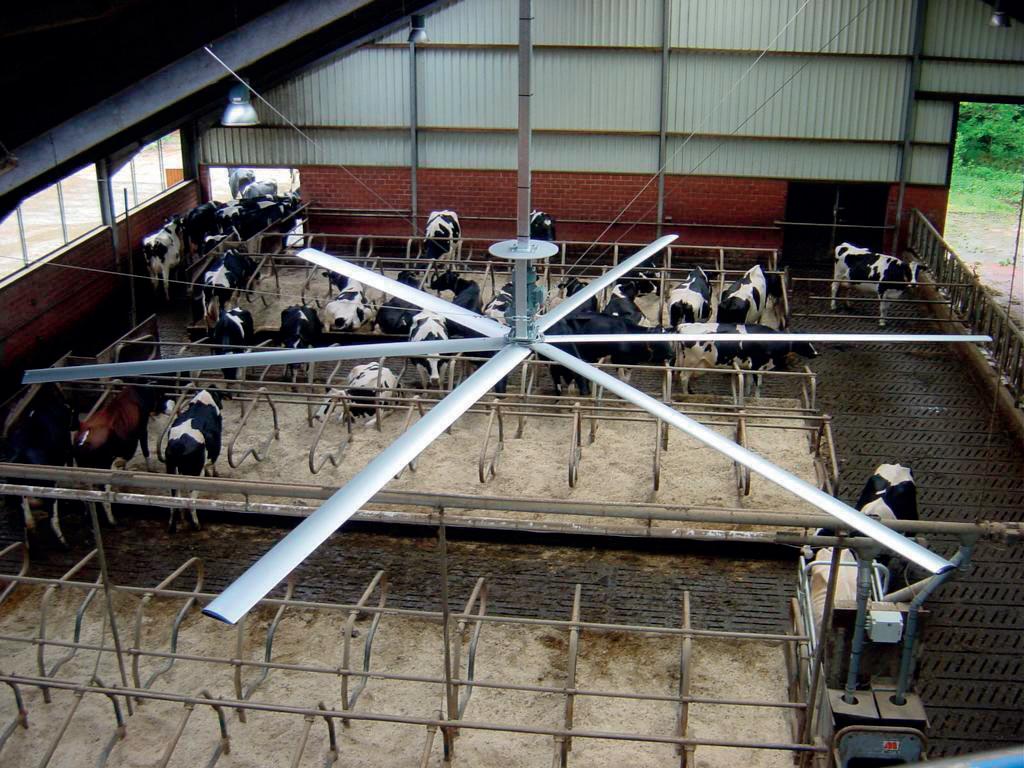
wholesale dairy commodity markets are still fragile.
By the beginning of March, producers had got through a relatively benign winter, boosted by a very kind autumn, but there were some concerns over lack of water and the prospect of cold March weather.
Milk deliveries were up 2.7% on last year, despite fewer cows
and AHDB estimates showing deliveries up 3.4% in the rst 18 days of February.
It expects March output to continue along similar lines, although growth may be tempered by the impact of cold and dry weather.
Ms Clayton says the market may have calmed by the middle of the year. AHDB’s latest dairy outlook predicts that falling milk prices, the continued burden of high costs, rising interest rates and labour shortages, will limit the increase in output.
Earlier this year, AHDB projected a 1.2% increase in GB production in the rst half of 2023, with a 0.6% drop in the second half.
Reduced yields are expected as producers cut back on inputs, but the decline in output could be greater if producers also decide to cut cow numbers.
Constraints to global production, especially in Australia and New Zealand, and the reopening of the Chinese market may also help stablilise the milk markets later in the year.
81 APRIL 2023 Key Features: Flying insects stay away Birds stay out Energy efficient Reduces ground moisture High Volume Low Speed 100ft by 100ft effective working area HVLS - Fans For a no obligation quote or more information Scotland/N. England Will - 07591833853 Wales/Midlands/S.England Fred - 07762800149 N. Ireland/R.O.I - 07803124235 JohnEmail - info@cowcaresystems.com Andrew Cowcare SYSTEMS Innovators in Dairy Farming
BUSINESS
Up until the end of February, dairy cow prices were strong, but trade is starting to ease, says auctioneer Meg Elliott.
CLINIC
AUTOMATION
At the first ForFarmers Robot Ready Roadshow, UK robotics performance manager Bas van Santen shared practical advice on what to consider when planning a robot system. Katie Fallon reports.
The drivers behind installing automated milking systems vary from farm to farm and business to business, but play an important role in the planning process nonetheless. At a recent ForFarmers event, held by the Harrison family at
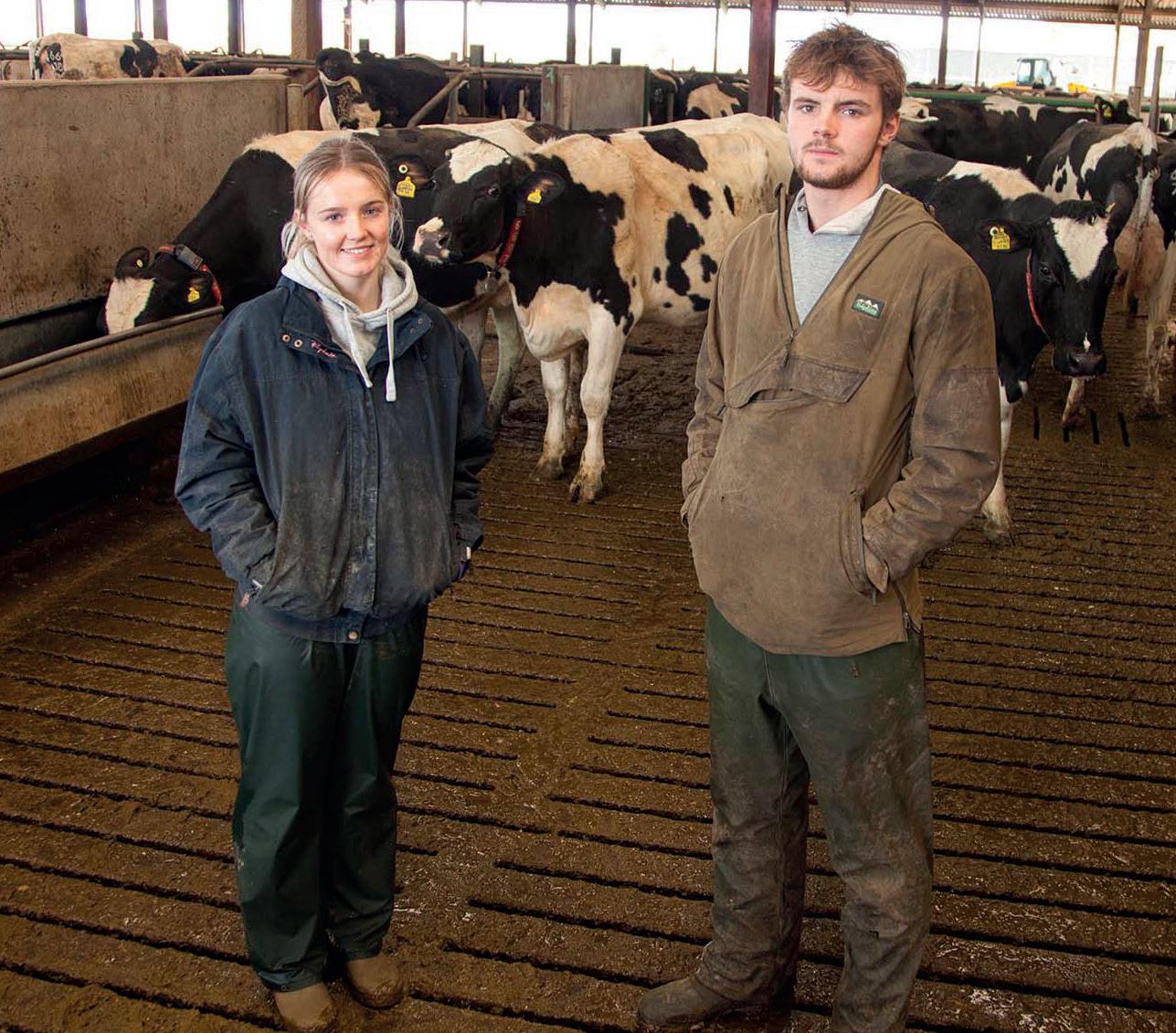
Planning a robot system
Dundraw Farm, Wigton, ForFarmers UK robotics performance manager Bas van Santen encouraged farmers looking to install robots to consider what their priorities were as a farm. He advised farmers to ask

themselves what their key drivers were behind installing robots and what they hoped to achieve from an automated system, as this would in uence shed layout and design.
Mr van Santen said: “No farm




Considerations when planning shed layout and design
JWhen planning the shed layout and design, Mr van Santen told farmers to visit other robot farms and ask one key question.
He said: “Always ask the farmer, if they had to build it all again what would they do differently, as hindsight is a wonderful thing.”
rGrouping cows: Think about how cows might be grouped and whether the shed will be split accordingly, as this can affect the shed layout and robot positioning.
At Dundraw Farm, the robot shed is split into a heifer and cow group with 120 heifers milked through two robots and the other 120 cows, including 60 second calvers milked through the other two robots.
Mr van Santen said grouping cows could be beneficial in


terms of workload as collect cows could be easier to find when split into smaller groups.
Not only that, but when splitting heifers from cows it allowed most of the work to be focused on the heifer group which would require the robot training, rather than cows which are already trained.
rFeed space: If farms are wanting to achieve high yields through automated milking, consistency of feed is crucial, said Mr van Santen.
He advised farmers to ensure there was always enough feed available and it was regularly pushed up.
Therefore, when planning the shed layout, he said it was important to accurately work out the feed space required and, if installing a feed fence, to make sure there was access for the feed to be pushed up regularly.
Mr van Santen advised farmers who were using a feed fence to think about installing an automated feed pusher to ensure a constant supply of feed if trying to achieve high yields.
He said: “There should always be something for cows to eat when they come to the feed fence.”
And he said, if farms were only feeding in the trough once a day, to consider feeding in the afternoon to ensure there was enough feed available through the night to maintain yields.
rWater: An important element in the dairy cow’s diet, Mr van Santen said water was another key focus when designing robot shed layouts.
With high yielding cows drinking 160-200 litres of water a day to produce consistently high yields, ensuring there was enough water available was essential.
He advised providing enough water space for 15-20 cows
is the same and even though there are default se ings when se ing up robots, it is not always that simple. e layout, se ing, feeding and management are all part of achieving high yields.”
per trough and to install a smaller number of larger troughs if space was limited.
rCow flow: When looking at cow flow, Mr van Santen advised farmers to include plenty of crossovers throughout the shed design and avoid any dead ends to ensure cows can move freely and escape dominant cows.
He also advised ensuring plenty of space in front of the robots to reduce crowding and ensure cows have easy access to and from the robots.
If cows are to be housed all year round, Mr van Santen advised farmers to think about grazing gates during the shed design in preparation for future requirements.
He said: “Think about the shed layout and where you could put a grazing gate if you wanted to or are required to in the future, as this could become a requirement from milk buyers.”
There should always be something for cows to eat when they come to the feed fence
82 APRIL 2023
BAS VAN SANTEN
Emma and Jack Harrison at Dundraw Farm, Wigton.
THE PREMIER UK EVENT FOR FARMERS + LANDOWNERS TO DIVERSIFY AND INNOVATE THEIR BUSINESS



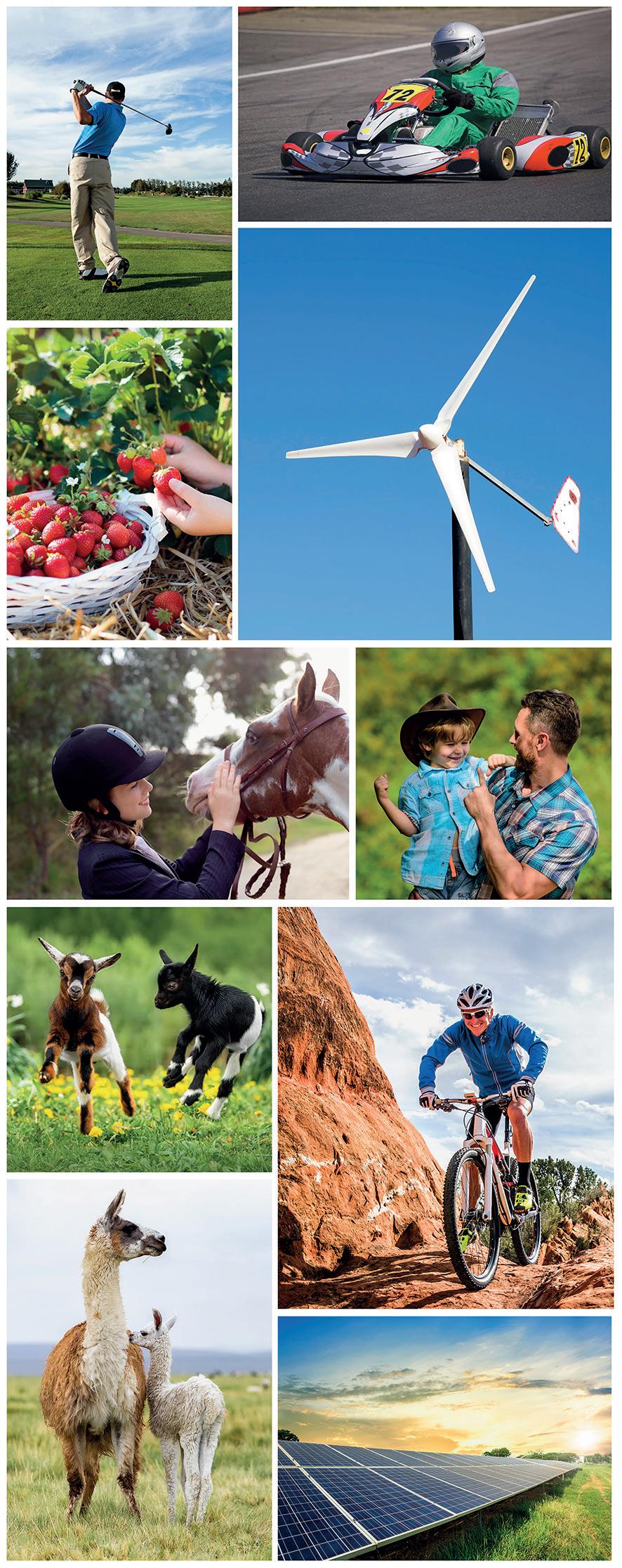




11,539 attendees
74 % of attendees have the purchasing authority or influence



of exhibitors rated the overall quality of leads good/excellent

70 % of exhibitors would highly recommend the show to others

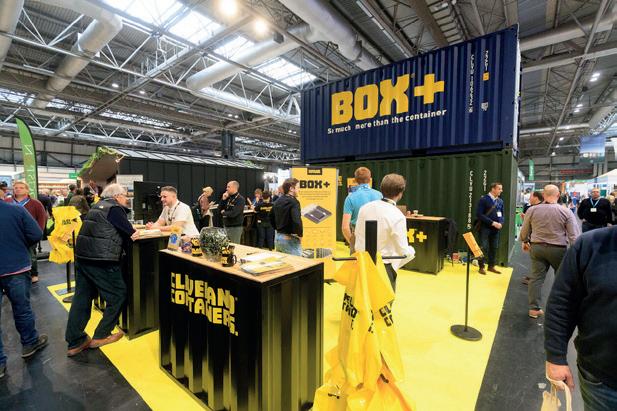
62 %


EVENT RUNNING ALONGSIDE THE FOLLOWING SHOWS:
DO NOT MISS OUT AND BOOK YOUR STAND TODAY farmbusinessshow.co.uk


NEC
15-16 NOV 2023
BIRMINGHAM
marketingre@agriconnect.com
#FBI23
• Increases milk yield by up to 2 litres per day1


• Protects fertility and reduces calving interval2
• Protects against reinfection by gutworms and lungworm*
parasite control,
by farmers for generations.
Proven
trusted
Find out more, visit beattheparasites.com
* Up to 28
control
up
21 days control of reinfection
spp. EPRINEX® Pour-On for beef and dairy cattle contains eprinomectin. POM-VPS. Advice should be sought from the prescriber. Further information available in the SPC or from Boehringer Ingelheim Animal Health UK Ltd, RG12 8YS, UK. Tel: 01344 746957. Email: vetenquiries@boehringer-ingelheim.com. EPRINEX® and the Steerhead® logo are registered trademarks of Boehringer Ingelheim Animal Health France SCS, used under licence. ©2023 Boehringer Ingelheim Animal Health UK Ltd. All rights reserved. Date of preparation: Feb 2023. UI-BOV-0025-2023. Use Medicines Responsibly.
1. McPherson WB et al. (2001) New Zealand Veterinary
Journal. 49:106-110.
2. McPherson WB et al. (1999) Proc AAVP,
New Orleans.
days
of reinfection with O. ostertagi and D. viviparus
, and
to
with Cooperia
EPRINEX®, a zero milk withhold wormer, is proven to improve the productivity of dairy cows and heifers by removing productionlimiting gutworms and lungworms.

















































































































































 Dr Tim Potter
Dr Tim Potter































































































































































































































































































































































































































































































































































































































